Checkers and Draughts -- a
guide to variants and literature
compiled by Michael Keller
Thanks for assistance to Philip Cohen, Ed Gilbert, Jake Kacher, Ken Lovell, Bob Newell, and Dennis Pawlek.
Also particular thanks to Vashon Island Books, from whom I've purchased many of the older books in my collection.
Table of Contents
Definition
A Brief History
General Rules
Checkers vs. Chess
Anglo-American Checkers
Flying King (Queen) Variants
International Checkers
Frisian Draughts
Turkish Draughts (Dama)
Variants to Reduce Draws
Alternate Opening Positions
Modern Variants
Combinations of Chess and Checkers
Commercial Variants
Distant relatives of checkers
Notation and Diagrams
Software
Bibliography
Anglo-American Checkers
Introductory Works
History and Biography
Advanced Strategy
Endgames and Problems
Collections of Games
Openings
Go-as-you-please
The Two-Move Era
Three-Move Compilations
Modern Works
Individual Openings
Computers
Magazines and Newspapers
Other Variants
International Draughts (10x10)
Pool Checkers
Organizations
Websites
Appendix 1: Anglo-American (8x8) Checker Openings
Appendix 2: Historical Notes on Some Individual Openings
Appendix 3: Glossary
Checkers or Draughts is a family of abstract two-player board games in
which
capturing is done by jumping over opposing pieces to remove
them. It is played on a checkered square board usually
ranging from 8x8 to 12x12. Most variants of the game are
played on the dark squares only; each player starts out with a set of
identical pieces which fill the dark squares of the first three or four
ranks of their side of the board. The terms checkers (mostly used in the United
States and Canada) and draughts
(used in most of the rest of the English-speaking world) should be
considered interchangeable, like solitaire and patience. [Note
that when used as adjectives, the forms are usually singular: checker
and draught.]
A Brief History
Checkers as we know it today probably developed in 12th-century France or Spain, on a
chessboard, using the original form of chess queen called the fers,
which could only move one square diagonally. The
pieces were likely the same flat disks used in one of the tables games
(forerunner of backgammon). Possibly checkers was at least
inspired by the
ancient game of Alquerque, but the earliest forms of checkers only have
the jumping capture in common with Alquerque: pieces only move forward,
promote on reaching the last rank, and captures might not begin until
several moves have been made, since there are two empty rows separating
the opposing forces. The earliest form of draughts, as we know it
today, unlike Alquerque, did not not have forced captures, although virtually all modern
variants do: forced capture (jeu de force) was introduced in the 16th century. Variants with flying kings (queens
in French and Spanish)
probably developed soon after the chess queen and bishop adapted their
modern
unlimited move around 1475 (see the introduction to Westerveld's Draughts Dictionary).
At some point regular pieces also gained the power to capture (but not
to make regular moves) backwards, through backwards capture did not
take root in Germany, and neither flying kings nor backwards capture in
England.
The oldest book is supposed to have been published in 1547 by Antonio
de Torquemada; this is lost and is only known through references in
later books. Modern research suggests the book was actually written by Juan de Timoneda; a book on draughts was published under his name in 1635 which is likely the same book. Spanish draughts was already using flying kings (or long kings)
in the 17th century, and the three kings vs. one king ending, later
called Petrov's Triangle, appeared in Spanish books of the
period. In 1650, Juan Garcia Canalejas's book La gloriosa historia espańola del Juego de las Damas included one of the most famous opening traps, commonly named after him, but it actually appeared earlier in Pedro Ruiz Montero's 1591 Libro del juego de las damas vulgarmente nombrado el marro.
The game spread from France and Spain to the rest of Western Europe,
and also to Russia, where a slightly different version evolved.
A number of books were published in Germany
beginning in the 18th century; Russia produced a large amount of theory
and literature starting in the late 19th century, and Brazil did so
starting in the 1930's.
The European version expanded to a 10x10 board in the 18th century, and
in France and the Netherlands this became the standard version, with
the first world championship in 1885, and the World Draughts Federation
(FMJD) formed in 1947 by France, the Netherlands, Belgium, and
Switzerland. Known now as International Draughts, it has more
than 70 member countries.
William Payne's 1756 An Introduction to the Game of Draughts was the first book in English. Serious play began in Great Britain in the 19th century, and the first
recognized World Champion was Scotland's Andrew
Anderson in 1840. Books, newspaper columns, and eventually magazines began to
spread interest in the game. It also gained popularity in the
United States, which saw its first newspaper column on "checkers or
draughts", edited by I.D.J. Sweet, in the 1855 New York
Clipper.
By 1880, when H.D.
Lyman was assembling a book of checkers problems (which was published
in 1881), he drew from over 35
different American and British magazines and newspapers.
The English game also spread to Ireland and throughout the
English-speaking world, including Canada, Australia, New Zealand, South Africa, and the Caribbean (especially Barbados).
In 1949, Arthur Samuel started programming the first checker-playing
program, building on earlier work by Claude Shannon (who proposed, but
never developed, an early idea for a chess-playing computer), and Christopher Strachey (who developed a draughts program for a video display in 1951 and presented his results at a conference in 1952). Samuel worked
out and tested various parameters
for evaluating checkers positions, discarding those that did not work
well. By 1952 Samuel had a working program for the IBM 701
computer, and by 1955 the program was one of the first successful
examples of machine learning (a term Samuel coined). He
pioneered some of the techniques of game programming (such as hashing, minimax,
and alpha-beta pruning), which influenced later programmers in various
games, including Gerald Tesauro's 1992 TD-Gammon and the chess program
Deep Blue, both also developed at IBM. Although Samuel's
Checkers Player never reached master strength, other
programs
followed in its wake. Tom Truscott and Eric Jensen wrote
the next strong program at Duke University. As personal
computers became widespread, other programs were developed with the
increasingly fast hardware becoming available. In 2003, Ed Trice
and Gil Dodgen published the first perfect
play database, with every
position up to 7 pieces in total, for their program World
Championship Checkers. In 2007, a team led by Canadian
computer scientist Jonathan Schaeffer
announced that their program Chinook
had established that 8x8 American
checkers (with unrestricted openings) was a draw with best play by both
sides (other variants, particularly the larger International game, are far from being solved).
General Rules
In most variants, pawns (plain
pieces, also called men or checkers) move one square diagonally forward, and can only capture by short leap,
jumping over an adjacent opposing piece to the vacant square
immediately
beyond. In some variants pawns can capture (but not make an
ordinary move) diagonally backwards as well as forward.
Pawns which reach the last rank (kingrow) are promoted to kings (gaining the power to move and capture
backwards in Anglo-American checkers), or in some variants queens (also called flying kings),
which can move any number of vacant squares in one diagonal direction. Queens or flying kings capture by long leap,
jumping over an opposing piece any distance away and landing any
distance beyond, provided all of the intervening squares (except the
square containing the piece to be captured) are vacant.
The object is to capture or block
all of the opposing pieces.
In almost every variant, captures are mandatory, and a capturing piece must continue to capture
if another capture is available from its landing square.
It is illegal to jump over a friendly piece, or to jump over an
opposing piece twice. In some variants, pieces are removed
as soon as they are captured (which may allow other captures);
others remove all captured pieces only at the end of a
move. Some variants require the maximum number of pieces to
be captured; others allow any piece which can capture to do so, not
necessarily one with the most available captures. In
most variants where pawns can capture backwards, a pawn which reaches
the kingrow by capture but makes another capture on the same move,
leaving the kingrow, is not promoted (Russian draughts is a notable exception).
At one
time, there was a rule called huffing:
if a player made a non-capturing
move when a capture was available, the opponent could remove a piece
which could have captured, then make a regular move (the opponent
could also let the move stand, or require the move to be retracted and
a capturing move played instead). This rule
was long ago abandoned in all
serious play, although it can still be found in beginners'
instructions and some general books on games (Cambodian and Malaysian draughts
seems to be the only regional variants that still use huffing).
There are many regional (national) variants, which may differ in
unimportant ways
such as which player goes first and whether the double corner is to
each player's left or right (the majority place the double corner on
each player's right, with a light square in the right corner as in
chess). In the early days of Scottish and English draughts, there
was not even a standard as to whether play was on dark squares or light
squares. For some reason, dark squares won out, despite
being worse from a visibility standpoint. Important
distinctions
in the regional variants are primarily in board size and capture
rules. We give the
most widely played variants below.
Checkers vs. Chess
Checkers has an undeserved reputation as a lightweight game for
children, and is used in fatuous metaphors comparing it unfavorably to
chess. Anecdotal evidence from discussion boards
suggests that a possible
reason so many people disparage checkers is that they are unaware of
the correct rules. Playing without mandatory captures is a
very
common house rule, and it is the way many people are taught to
play. But checkers
simply doesn't work without mandatory capturing:
the game is unwaveringly dull, and can easily turn into a completely
blocked position (especially when players refuse to move from their
back rank to prevent the opponent from getting a king). (At
least one online checkers app I found
had forced captures turned off by default, though it can be turned on).
Played properly, in any of its major variants, checkers is a deep
strategic game. Several books accurately refer to serious
play as scientific checkers. Many players who have mastered
chess and checkers (Newell Banks, Irving Chernev, Emanuel Lasker, Harry Nelson Pillsbury, Alexander
Kotov, Vassily Ivanchuk) hold both games
in high regard (even Bobby Fischer was interested in pool
checkers, and learned from the books by his friend Archie Waters). The
notable Russian chess magazine 64 for much of its history covered 8x8 Russian draughts, and later 10x10
International draughts. In Studying
Chess Made Easy, Andy Soltis suggests students play both games,
as checkers helps with visualization and calculation. Like
chess, checkers
has a long history of serious competition in several different forms,
including correspondence play, and a
voluminous literature (until sometime in the 20th century, its
literature was even larger than that of chess, according to Schaeffer's
One Jump Ahead). There
are also competitions in checkers played with faster time limits (e.g.
15 minutes per player per game in Rapid, 5 minutes in
Blitz). Checkers is well-suited to simultaneous
exhibitions, sometimes blindfold (checkers, particularly with flying
kings, might actually be harder to play blindfold than chess).
The noted chess historian Edward Winter has a fine article
on some of the notables who have played both games, including Banks (the subject of a separate article) and
Lasker.
Anglo-American Checkers
The
variant of the game most common in the United States (where it is
called checkers) and the United Kingdom (where it is called draughts)
probably has the largest literature of any form of the game (now second only to chess among board games). It is
played on the dark squares of an 8x8 checkered board, with each player
starting
with 12 men (generically pawns)
a side, on the
three ranks nearest them. The object is to capture or block
all of the opposing pieces. The player with the darker pieces moves first. Men move one square
diagonally forward, and capture
diagonally forward by jumping
over an adjacent opposing piece which has a vacant square behind
it. Captures are mandatory: a player must make a capturing move if one is
available, and must continue to capture with the moving piece if
another capture is available from the landing square (making a series of captures of the same turn). If more than one capturing
move is available (with more than one piece, or in more than one
direction), any capture (not necessarily the move that captures
the most pieces) may be played. At the end of a capture or
series of captures, all of the opposing pieces which were jumped are
removed. A man which reaches the last rank (the
opponent's first), by either a normal or capturing move, promotes to
become a king
(usually marked
by placing a second piece on top of it) and the turn ends.
A king moves and captures like a man, but in any direction (backward as well as
forward). It can also make multiple captures, jumping in
any direction on each jump. A player wins when their
opponent has no legal moves (usually because they have no pieces left,
but occasionally when all of their remaining pieces are
blocked). Draws occur when neither player can force a
win (usually due to equal material in the endgame). The game
with single step kings is also sometimes referred to as
straight checkers, to
distinguish from the larger family of games with flying
kings.
In most books, the first player is designated Black and the second White. Serious
players play with thick solid plain disks similar to backgammon pieces,
most often red and white, and a board of green and buff (white,
off-white, or cream)
squares. [Some
recent books designate the first player Red instead of Black, but we
will maintain the traditional terminology.] Play is on the green squares. Checker sets for children, at least in the United States, are usually
red and black plastic disks with ridges on both sides which allow the
pieces to lock together when a piece is kinged. These are dreadful, as black checkers show up poorly on black squares. Inexpensive
combination sets with 15 red and black checkers are often sold with a
folding board which has a backgammon board on the other side (and
sometimes a set of chess pieces as well). See notes below on diagrams.
Many checkers books dutifully include three or four pages on The
Standard Laws (originally compiled by Andrew Anderson in 1852), which
give intricate instructions on time limits, improper moves, etc., but
usually leave out trivial details such as how the pieces move and capture. A few works, such as Kear's Encyclopaedia, sensibly amend those laws to include the basic rules of play. W.T. Call's Vocabulary of Checkers cites an incident (No man to crown with) which
happened twice in 1884, where a player moved a man to the kingrow
before he had lost a piece, and refused to allow a checker to be
borrowed from another board (claiming a win), until the umpire
intervened. The laws as given today explicitly direct the referee to
furnish a checker in this circumstance.
Anglo-American checkers can played on
a 10x10 board: Zillions of
Games includes 10x10 implementations with both 15 and 20 pieces
per side (some online versions call these Sparse Checkers and Crowded
Checkers respectively). However, Martin Gardner's The Last Recreations notes that some endgames winnable on
the 8x8 board are draws on the 10x10 board (e.g. three kings vs two
kings in separate double corners: the corners are too far apart for the
three kings to threaten both simultaneously).
In recent years the game has spread beyond its traditional centers
in the English-speaking world, to countries such as Pakistan,
Turkemenistan, the Ukraine, and Italy (as noted below).
Italian Checkers
A variant of Anglo-American checkers, in which kings cannot be
captured by pawns. The board is rotated so that the double corner is to each player's left. The rules for multiple
captures are complicated: if multiple captures are available with
different pieces, the largest number of pieces must be captured; if
equal, capture by a king must be chosen over capture by a pawn; if
two kings can capture equal numbers, the one which captures more kings
must be chosen; if equal, the one which captures a king
earlier. Some sources say a player who loses without a
pawn being promoted loses double; this does not seem to be part of the official rules. Ed Gilbert's Kingsrow checkers program has a
version for Italian Checkers.
The Italian game is similar enough to Anglo-American checkers that
several Italian players have won the world championship in the latter,
in both three-move and go-as-you-please formats.
Flying King (Queen) variants
[Variants in which kings
(queens) move and capture any distance along an open diagonal.]

International Draughts
The most popular form of the game worldwide is played on a 10x10 board,
with 20 checkers per side on the first four ranks. White moves first. There
are two important differences from Anglo-American checkers: plain checkers can
capture diagonally backward as well as forward, and kings are flying kings:
they can make non-capturing moves any number of empty squares along a
diagonal (like a bishop in chess), and can capture by jumping an
opposing piece any distance away and land any distance beyond, as long
as they pass over only empty squares (except for the checker being
captured). Multiple captures, either by a checker or king,
are also possible; when a choice of captures is available, the largest
number of opposing pieces must be captured. A checker
which reaches the last rank, but which still has an available
(backwards) capture, must make that capture and is not
kinged; only a checker which finishes its move on the
last rank is kinged. In some books it is referred to
as Polish Checkers (probably a misnomer; it did not originate in Poland)
or Continental Draughts.
A consequence of flying kings is that endgames with two kings versus
one are drawn; it takes at least three and usually four kings to force
the capture of a single opposing king (but see alternate
demotion rules). Despite this, the
International game is much less drawish than the Anglo-American
variant, and richer in tactics.
International Draughts is also played on an 8x8
board with the same rules (White moves first, checkers capture backwards, flying kings,
and maximum captures) and 12
checkers per side. This is now officially called
Brazilian Draughts (older sources called it German Checkers, or
Damenspiel, but German rules do not allow plain checkers to
capture backwards). A backwards capture can
occur as early as Black's second move: e.g. 10-14 22-17; 11-15 17x19
(capturing 14 forward and 15 backwards). Spanish Draughts is similar to Brazilian except that plain checkers cannot capture backwards
(Spanish Draughts also rotates the board so that the double corner is
to the left; Portuguese Draughts is the same as Spanish but with the
double corner on the right as usual).
Spanish Draughts, as described in older books, is
sometimes played with each player having one or two kings each on their
king rows at the start of the game.
American Pool checkers
The
official rules of American Pool do not require the maximum number
of captures to be made, but a capturing piece must still continue to
capture as long as captures are available. Captured pieces
are all removed at the end of the turn. Otherwise it is the
same as Brazilian Draughts. A few older books refer to it as
Minor Polish Checkers.
Russian Draughts (шашки)
This variant, dating back to 1884, is played on an 8x8 board with most
of the International rules, with the following exceptions: a checker
which reaches the last rank by capture becomes a king immediately and can continue to capture as a king on the same
move.
Any capture, not necessarily one allowing the most pieces to be
captured, may be played when multiple captures are available, but a
piece which has made a capture (including a checker just kinged) must
continue to capture on the same turn if a capture is
available. Russian draughts players have adapted easily to
American Pool, which only lacks the continuation capture of a checker
just kinged.
Russian draughts
is also sometimes played
on a wider 10x8 board
(10 files and 8 ranks) with 15 checkers per side. This is
sometimes called Spantsireti after its inventor, Nikolai Spansireti,
but is usually called 80-Squares Checkers (80-клеточные
шашки). There are a number of other variants of Russian draughts, including:
(1) Northern Checkers (Северные шашки), where a captured king is not removed, but demoted to a plain checker.
(2) Simple Checkers (Простые шашки), in which checkers do not promote
(checkers cannot move once they reach the last rank, except to capture
backwards).
(3) Double-Move Checkers (Двухходовые шашки), where players move twice per turn. (It is not played in balanced doublemove fashion: White makes two moves even on their first turn).
(4) Giveaway Checkers (поддавки шашки),
played with Russian rules. It has been widely studied in
Russia, and tournaments have been played since 2011.
Canadian Draughts (Grand Jeu de Dames)
International Draughts on a 12x12 board, with 30 pieces per player on
their first five ranks. Malaysian Checkers (also played in
Singapore) is similar to Canadian, but plain checkers cannot capture
backwards, and the huffing rule is still in effect. In Cape Town, South Africa, a variant called Dumm is played on a 14x14 board.
Czech Checkers (Česca Dáma)
International Draughts on an 8x8 board, but plain checkers are not
allowed to capture backwards (so opening theory should be similar to Anglo-American). Played in Slovakia with only 8
plain checkers per side.
In most countries with their own regional variants, one or more of the
major variants (International 10x10, Brazilian 8x8, or Anglo-American)
is also played, particularly in official competitions.
Frisian Draughts
One
of the most interesting regional games, played in The Netherlands for
over 400 years, is played on the
10x10 board as in International draughts. Although it is played
only on the dark squares, captures can also be made orthogonally,
leaping
over two light squares as well as an opposing piece. Captures by
both men and kings are allowed in all eight
directions. Men move diagonally one square forward when not
capturing. Kings move as bishops in chess, and capture by long
leap. A multiple capture must capture pieces of the
largest available total value (counting kings as just below
1-1/2). If values are equal, a capture must be made by a
king rather than a man. An
individual king can only make three consecutive non-capturing moves
(unless a player has only kings). The World Championship Frisian Draughts
site has an excellent basic strategy manual (including openings and
endgames) in five languages, rules in six languages, and additional
books in Dutch. Recently a miniature version, Frysk, with only
five pieces per side, has been introduced. Both Frisian and Frysk
are featured on the LiDraughts server.
Full board Orthogonal variants
[Movement is orthogonal; every square is available]
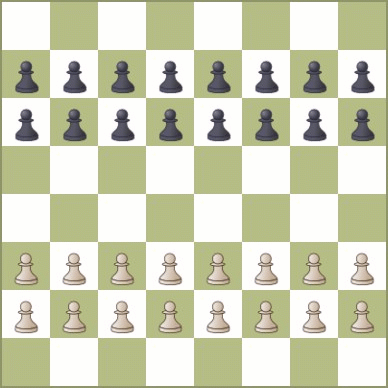
Turkish Draughts (Dama)
The principal variant in which all 64 squares are
used. It is played in Turkey, Greece, Egypt, and the Middle
East. The first world championship was not held until 2014,
though the game is far older, and likely evolved independently of the
diagonal variants. Each player has 16 pawns, placed on the
second and
third ranks (diagram above, although traditional boards are
uncheckered). Pawns
move one square straight
forward or sideways, and capture by jumping in the same
manner. A pawn which finishes its move on the last
rank
is kinged; a pawn which jumps to the last rank can continue with
sideways capture if available (and is still kinged). Kings
(Dama) can move and capture any distance in any
orthogonal direction. Pieces in multiple captures are
removed as each is jumped; this may make new captures available;
reversal of direction (180 degree turn) is not permitted.
The maximum number of captures available must
be made. Like Anglo-American checkers, two kings can win
against one in the endgame, and the draw rate is lower than the other
major variants. { The description in The New Complete
Hoyle and Goren's Hoyle
is erroneous: they allow diagonal forward movement, probably confusing it with
Armenian draughts, another regional variant.}
Turkish draughts is the basis for an excellent modern variant, Give and Take,
invented by Christopher Elis, described later under Modern
Variants. Two other modern variants, Croda (see Abstract Games 9)
and Dameo (also in Modern Variants below), are more closely related to
Armenian draughts. Another regional variant of
Turkish draughts is Keny,
played in the Caucasus (Russian кавказские шашки, or Caucasian
Draughts), in which pawns can capture in all four directions, as well
as make non-capturing leaps over friendly pieces (as in Halma).
Variants to reduce
draws
Because the Anglo-American game has a very high rate of draws among
expert players, a number of variants have been devised to vary the
opening play:
Eleven-Man Ballot (Newell W.
Banks, 1907) -- each player removes one
checker
from the start, from squares chosen at random from a special deck of 8
cards. A second card drawn by each
player gives their first move to be played. 2500 distinct
opening
positions are possible in all; Ed Gilbert's Kingsrow program identified
247 as losses, leaving 2253 playable
openings. The Checker Maven has a good account of Gilbert's work. Goren's Hoyle describes a more limited version, in which the two pieces removed are
from corresponding positions (e.g. 6 and 27). Other systems have also been
used, including special 12-sided and 4-sided dice devised by Don
Brattin, based on an idea by Bill Scott. A detailed
description of various systems for 11-man
ballots is on the website of the North Carolina Checker Association. W.R. Fraser's The Inferno of Checkers gives a few sample games, and indicates how the openings can occasionally be steered into normal three-move openings.
Contract Checkers (L.S.
Stricker, 1934) [source: Goren's Hoyle; Games Digest June 1938]
Play starts with 12 checkers a side in the usual array. There are
one, two, three, or four extra checkers per side in reserve. One checker
each is added simultaneously to each side when designated pairs of back
row squares are vacated (e.g., in the 13-checker variant, each player
adds a reserve checker as soon as both 4 and 29 are vacant). Talis' description in Games Digest
suggests only one extra checker per side, placed simultaneously as
soon as any pair of corresponding back row squares become vacant.
Two- and Three-Move
Ballot -- See Appendix 1.
Balloting for opening moves
is now used in international 8x8 (Brazilian draughts) tournaments, with 780 possible combinations of
up to three moves per side (e.g. combination 11 XVII is a longer line in
the equivalent of the American opening Gemini 2: 10-15 23-19; 11-16
19x10; 6x15 22-17). Some of the ballots use a system called flying checkers,
in which one or two pieces are moved from their opening position to a
square to which they could not move normally (e.g ballot 23 IV moves a3
to d4 and h8 to h4).
King Demotion
Rules
In Draughts variants with flying kings, it normally takes four kings
to defeat a lone king. (In 8x8 variants, three kings can
defeat one king if the stronger side has a king on the long diagonal
between the single corners, using a technique usually called a Petrov
Triangle.) An alternate rule to fix this is to require a
king, when capturing an opposing king, to stop in the square immediately beyond the
captured king,
rather than being allowed to fly further after capturing (this is a
standard rule in some regional variants like Thai
Checkers). Christian
Freeling calls the game with this rule Killer Draughts. It
has the effect that two kings can win against a single king, instead of
requiring three or four. Juri Anikejev suggested a
more limited rule called Modern Draughts (Killer Light) by applying the
rule only after capturing a king at the end of a multiple capture
sequence. In Central-South-German Checkers (Süddeutsches
Damespiel), a king must stop in the square immediately beyond the last captured piece. See Peter Michaelsen's post for some history of these rules.
Herman Hoogland, a World Champion player from the Netherlands,
borrowed a rule from Frisian Draughts to allow two kings to defeat one:
a king can
capture an opposing king orthogonally. In 2020 on the BoardGameGeek
forum, Michał Zapała proposed a new variant, Constitutional Draughts,
in which a king making a non-capturing move could not pass through an
attacked square to reach a non-attacked square (capturing moves are
unaffected); this also allows two kings to defeat one (a short introduction is here).
Breakthrough
The first
player to make a king wins (also called Kingscourt, not to be confused
with the commercial variant King's Court described below).
This is sometimes used as a
simpler variant to teach beginners the basics of strategy.
It is supported as a variant on Lidraughts,
but can obviously be played with almost any variant. Martin
Fierz solved the version for 8x8 American checkers in 2006 (White has a forced win in about 31 moves).
Alternate Opening Positions
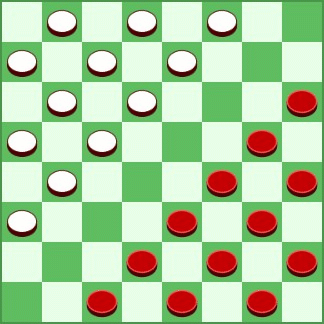
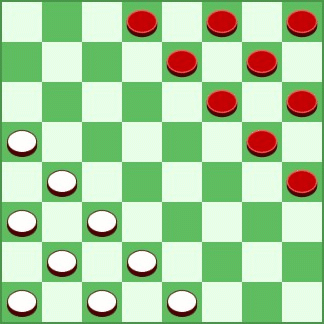
Diagonal Checkers
Diagonal checkers (in the 12-piece version above left) is a
common variant for American checkers, and also in both Russian and
German draughts. Pawns promote to Kings in either of the two
opposite double corner squares (German: a7b8 or g1h2) or any of the four edge squares
farthest away (Russian: a5a7b8d8 or e1g1h2h4). There is also a 9-piece variant (above right).
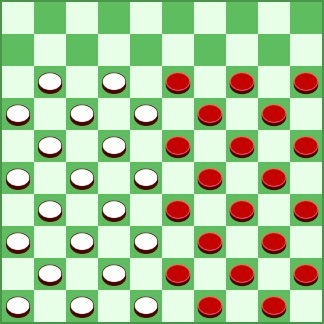
Parallel Checkers
Parallel Checkers (Les Dames Paralleles, ou A Sens Unique) (Joseph Boyer)
From the book by Boyer and Parton; both players move and promote in the
same direction (moving up the board); Boyer does not specify which
player moves first. It can be played with any of the usual
variants; the game server BrainKing
implements it as One-Way Checkers, on an 8x8 board using Czech Checkers
rules (no backwards captures by plain checkers). Boyer also
suggests 12x12 Canadian checkers; the starting position is more
balanced when both players have the same number of checkers on their
uppermost row (8x8 or 12x12).
Super-checkers (Charles Fort) c. 1930
A giant variant played with many checkers per side on a large
checkered cloth. Players were allowed to make large numbers
of moves at a time at the opponent's discretion, followed by an equal
number by the opponent. The author wrote
to a friend: "Super-checkers is going to be a great success. I
have met four more people who consider it preposterous."
Modern Variants
Checkers to the MAX (Stanley
Druben), 1992
The board starts empty. Players alternate either placing a
new checker on a vacant square on their first three rows, or moving a
checker already placed.
Coronet (Chris Huntoon), 2012
An 8x8 variant with both orthogonal and diagonal movement, with 21
pieces per side arranged in a triangle in opposite corners.
Promotion is only in the single square in the opposite
corner. Implemented in Zillions. This article on BoardgameGeek gives a number of Huntoon's inventions.
Dameo
(Christian Freeling)
An 8x8 draughts variant using the whole board, with king movement in
all eight directions; developed from Croda. Checkers can only move straight or
diagonally forward, but can perform a linear jump, passing over one or
more adjacent friendly checkers in any of the three directions (this is
equivalent to shifting a whole row of adjacent pieces one square in the
same direction, a limited version of the phalanx move in Robert Abbott's game Crossing/Epaminondas). Kings cannot perform a linear jump, nor be
jumped over. Captures are orthogonal only, but in any
direction (checkers by short leap, kings by long leap). The
tactics of the game are rich, and draws are infrequent. Two kings
can always win against one king, regardless of the position and which
player is to move. The Bibliography lists an excellent
introductory book by Aleh Tapalnitski, Meet
Dameo!, which is available for free download.
Give and Take
(Christopher Elis)
This is a variant of Turkish draughts with the same general rules and
opening position, but there are two new rules
which make the game rich in tactics. The first new rules is
that captures are only
compulsory in one instance: when a piece is moved so that it can be
captured, the opponent must immediately capture it, and continue to
capture if possible (this is the Give and Take of the
title). A king which captures must land on a square
permitting another capture if possible. The second rule is
that a pawn which is a
player's only piece instantly becomes a king. John
McCallion published an account in NOST-Algia
339, and a feature article in Games
Magazine (May 1999, pp. 56-57). It was also discussed in Eteroscacco 62.
Giveaway Checkers (The Losing
Game, Anticheckers, etc.)
This is the misčre variant of checkers: the object is to lose all of
your pieces (or have the remaining ones blocked). This can be played with any variant of the
normal game with compulsory captures. Recreational Mathematics Magazine volume
1, number 2 (April 1961) gave a 56-move solution
to a straight checkers problem (Loser's Checkers) where White (with a
full set of checkers) must win by forcing a single Black king at 7 to
capture all 12 men. It was a popular game in NOST, and
has been widely played in German (Schlagdame) and Russian (поддавки шашки) draughts.
The Good-for-Nothings (Les Vauriens)
V.R. Parton devised a game (first published in the book by Boyer and
Parton) combining regular and giveaway checkers. It is played
like International 10x10 draughts, but the five checkers on each
player's back row are replaced by Good-for-Nothings,
which move and capture like normal checkers, but lose the game if
forced to promote. The goal is to lose all five of your
good-for-nothings; you can also win by capturing all of your opponent's
regular checkers, or by forcing an opposing good-for-nothing to reach
your back row and promote. Schmittberger describes this in New Rules for Classic Games, and suggests that it can be played on an 8x8 board as well. ItsYourTurn implements it with American rules as Mule Checkers.
Heaven and Hell Toroidal
Checkers
Frank Cunliffe sent me rules for this very
interesting game from a
one-page posting on a Princeton computer network written by Tobias D. Robison, who learned the game in 1958
from Joe Tamargo. [Can
anyone shed any more light on the origins of this game?]
The game starts in the normal 8x8 position, and checkers and kings move
and capture as normal. However, the board is toroidal
(doughnut-shaped): the two end ranks are adjacent, as well as the
leftmost and rightmost ranks. The dark squares are referred
to as Heaven, the light squares (initially all empty) as
Hell. Checkers do not promote by reaching the last rank;
kings can be created only by capture. When a piece is jumped, it
is shifted horizontally (along its rank) to the jumping player's left,
to the first available square of the opposite color which is either
vacant or occupied by a single checker of the same color (in which case
it creates a king). A king which is jumped can only be
shifted to an empty square. If no squares are
available, the jumped piece goes into Limbo (off the board and
permanently out of play). Once a player has pieces in both
Heaven and Hell, they may play in either, but a capturing move must be
made if available anywhere (pieces jumped in Hell shift back into
Heaven). The object is to get all of the opponent's pieces
out of Heaven. (As Robison puts it, you are simultaneously
playing regular checkers in Heaven and losing checkers in
Hell). I passed the information to John McCallion,
who wrote a feature article for Games
World of Puzzles May 2012 (pp. 66-67), including a sample game.
Hexdame (Christian
Freeling)
International Draughts on an order-5 hexagonal board, with 16 checkers
per side. Rules are given on pp. 183-184 of New Rules for Classic Games.
Kiwi Checkers (John Bosley)
This is a variant which uses the shogi mechanism of dropping
(re-entering captured pieces). When pieces are captured, they are
added to the capturing player's reserve, and can be dropped 1, 2, or 3
at a time onto vacant squares or onto friendly pieces; stacks of up to
three pieces are allowed, named after birds from the inventor's native
New Zealand. Single (kiwi) and double (tui) pieces move as
regular checkers; triple (moa) pieces as kings. Checkers
which reach the back rank are not kinged; they are immobile until
pieces are played from the reserve to form a Moa (stack of
three). Captures are mandatory and the maximum number
of captures is required. A drop constitutes a move and is
only allowed when no captures are available. Kiwi Checkers was
first published in 1990 in NOST-Algia
319, and briefly described in WGR10
in 1994 (p.29).
March Hare Checkers (Chris Huntoon), 2012
Application
of V.R. Parton's March Hare Chess to 10x10 International
Checkers. After Black's first move, each move consists of
moving a friendly piece followed by an opposing piece (captures
mandatory as usual). A player reduced to one or two pieces
loses. Implemented in Zillions.
Sleeping Beauty Draughts (Ralf Gering)
Published in Abstract Games 14 (Summer 2003, pp.25-26), this is a modern variant designed to make draws impossible. Rules are as Anglo-American checkers, but men promote to ladies,
which can capture either as regular kings (shortleaping), or by
replacement (as the chess Fers, one square diagonally). A
player may only have one lady at a time; additional promotions are to sleeping beauties,
which remain stationary (unable to capture or be captured) until a
player loses their only lady, at which point a sleeping beauty can be
awakened. Full rules and five sample problems are
available in the online issue.
Combinations
of Chess and Checkers
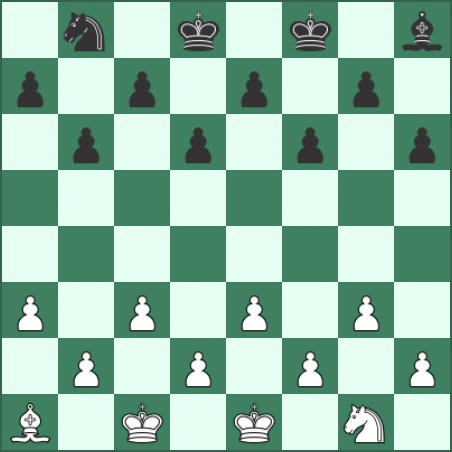
Initial position in Cheskers
Cheskers (Solomon W. Golomb),
1947
This is a combination of chess and checkers, invented in 1947 by
Solomon W. Golomb, of pentominoes fame. The board and
opening
position are exactly as in checkers, except that the four first rank
checkers are replaced by: a Bishop at a1/h8 (which moves exactly as in
chess, capturing by replacement rather than by leaping), two Kings at
c1/e1/d8/f8 (which move exactly like kings in checkers), and a Cook at
g1/b8 (which moves like the Camel in chess variants, to the opposite
corner of a 2x4 rectangle, capturing by replacement). [Knights
are used for the Cooks in both diagrams and play.] The
second and third-rank pieces are Pawns, which move and capture exactly
as checkers; multiple captures are as usual.
If captures by Pawns and/or Kings are available, a capturing move is
mandatory, but may be by Bishop or Cook if available. Capturing
by Bishop or Cook is always optional. Pawns which
reach the last rank promote to Bishop,
Cook, or King. The object is to capture all of the opponent's
kings. A stalemated player loses. This was a
popular variant game in the Knights
of the Square Table.
Chess-Draughts (Henry Richter, 1883)
Not really a checkers variant; although play is on the black squares
only, capture is by replacement rather than leaping. Each
side has 6 Pawns (moving and capturing one square diagonally forward,
and promoting to Knight on the last rank), one Lady (one square
diagonally in any direction), and one Knight (like a bishop in
chess). The object is to capture the opposing Lady.
Commercial Variants
Blue and Gray (Henry Busch and Arthur Jaeger), 1903
Checkers variant played on the intersections of an 8x8 board (i.e. 9x9 intersections) with 17 guards and a captain
on each side. The board has a specially marked path from the
starting square of both captains to the center of the
board. The object is to reach the center with the
captain. Described by Sid Sackson in A Gamut of Games.
Camelot (George S.
Parker), 1930
One
of the most renowned commercial variants of checkers, invented by the
founder of Parker Brothers. It originally appeared as
Chivalry in 1887, then as Camelot in 1930. It is played on
a vaguely octagonal board of 160 squares (12 wide and 16 deep, with the
first three ranks at each end reduced to 2, 8, and 10 squares), with
ten men and four knights per side. There are several
different kinds of moves, some of them similar to Halma. It
was briefly republished in 1985 as Inside Moves, without the medieval
imagery. Other variants have been published by Parker
Brothers, and unofficial variants have also appeared. Wikipedia
has a good description, including a sample game from the 2009 world championship. There is also a World Camelot Federation.
King's Court (Christopher
Wroth), 1986
Checkers variant on an 8x8 diamond-shaped board, which starts full
except for the 4x4
central area. Pieces move and jump as kings, and can also jump
friendly pieces without capturing. Each player moves one
piece into the central area: the first player to eliminate all of the
opponent's central pieces wins.
Quick Checkers (Amerigames International), 1998
A commercial 6x6 version (6 pieces per side) designed to teach
children how to play. The other side of the board has a standard 8x8
board.
Multiplayer Variants
Three- and four-handed versions of checkers (with each player moving in a different direction) are too numerous to mention
them all (similar chess variants have existed for a century or more). A number of examples can be found in Boyer and
Parton's book, including triangular and hexagonal
boards. A three-handed game on a triangular board, called Draughts For Three, was patented in 1888 by
John Hyde (see Provenzo, Play It Again, in the Abstract Bibliography); a different scheme, Trangle Checkers, was published in 1897 by Warren Morris Babbitt (see the Bibliography below). Four-handed commercial examples include George V. de Lery's Fourplay Checkers (Deroma, 1939), on a 6x6 board with four 2x6 wings added and only six checkers per side (mentioned in Wiswell and Hopper's Checker Kings in Action), Robert King's Intense Checkers
(1991), on an 8x8 board with four 3x8 wings added, and Elmer C. Pearson's Fourhanded Checkers (1974), on an 11x11 board with corner squares removed, and 9 checkers per side. Three-handed versions include Megacheckers
(MegaGames), for three players on an oddly-shaped board with 12
checkers per side, En Garde (Mynd Games, Northern Games, 1986), on a
nine-sided board, and Yorel Game Company's Treckers (1981), on a hexagonal
board for 2 or 3 players, with five levels of play. Board Game Geek has details on many other commercial checkers variants.
Distant relatives of checkers
To keep this guide to a reasonable size, I have omitted several families of games:
(1) Games where captured pieces
are absorbed into a stack, such as the traditional Russian game Bashni
(Columns), and its later offshoots like Emmanuel Lasker's Laska, and
Christian Freeling's hexagonal variant Emergo. Winning
Moves' King Me includes a
variant called Stack'Em Checkers in the same family. David
Pritchard, in both The Family Book of Games and Five Minute Games,
mentions Alvin Paster's game of Pasta, which combines
Laska and Checkers. There are also games where jumped
pieces are flipped as in Reversi. The New Complete Hoyle
describes a variant called Stack-Up Checkers (credited to Mark Eudey
and Stillman Drake).
(2) Games in which
there is no capturing (Halma and its relatives like Chinese Checkers,
and checkerboard variants such as Pyramid Checkers and Salta (a brief craze in the early 20th century)), where the object
is to move all of your checkers into the opponent's starting area.
(3) Games of the Fox and Geese and Tafl families, which have unbalanced
forces and different goals, and in which neither side, or sometimes
only one side, can capture.
Konane (Hawaiian Checkers)
A
Hawaiian game with 32 pieces per player, which fill the entire board
in
alternation (that is, black pieces start on what would be the black
squares and vice versa, though the board is uncheckered and
traditionally consists of pits dug into a stone board, with white
pieces of coral and black pieces of lava). Two adjacent
pieces, usually near
the center, are removed. Not a checkers variant, since
pieces can't make non-capturing moves: captures are mandatory and
orthogonal
only;
multiple captures are not mandatory and are allowed in only one
direction per turn. The last person
able to make a capture wins.
Notation and Diagrams
In
traditional Anglo-American notation, the playable squares are numbered
from 1-32, starting at the upper left corner from the first
player's viewpoint. Black moves first from the top half of
the board. Moves are designated by the starting
and
finishing square separated by dashes (11-15) or spaces in older books
(11 15); sometimes captures are
noted by x or : (11-15 22-18 15x22). Some older books (e.g.
Anderson, Baker, and as late as Kear's Encyclopaedia) which present moves in vertical columns may have
dashes (sometimes long) in Black's moves and spaces (or double dots) in White's, to make the pairs of
moves easier to see. International Draughts
also uses numerical notation with the numbers 1-50 (x for
captures), with White moving first from the bottom half of the board. Standard algebraic
notation is used in Russian and Turkish
Draughts (necessary in Turkish, since all 64 squares are used). Portable
Draughts Notation
is a text-based notation which is both human and machine readable, and
has options for many different variants. It supports
annotations
as well as information on when and where and by whom a game was
played, and uses traditional numeric notation with x for
captures. It was devised by Adrian Millett (based on the
existing Portable Games Notation) for his programs Sage and Dynamo, and
has been adopted by many other draughts programs.
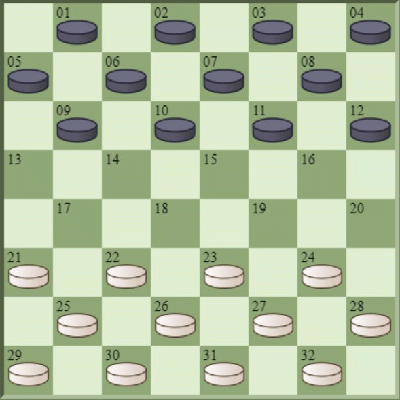
Numbered Board for 8x8 checkers
Diagrams
Although play is on
the darker squares, printed diagrams in monochrome are usually made
with
reversed colors, so the pieces are shown on white squares, with the
unused squares in gray. Monochrome diagrams printed with the
pieces on
dark squares are often nightmarishly unreadable: below are diagrams
from two different books by the same author, Andrew J. Banks. The left
diagram is from Pictorial Guide to Checkers; the right is from Checker Board Strategy.
Despite being here reduced 50% relative to the first diagram, the
second is much sharper and clearer. In electronic
publishing (like this booklet), quality diagrams can be published in full color with pieces
on the green squares.
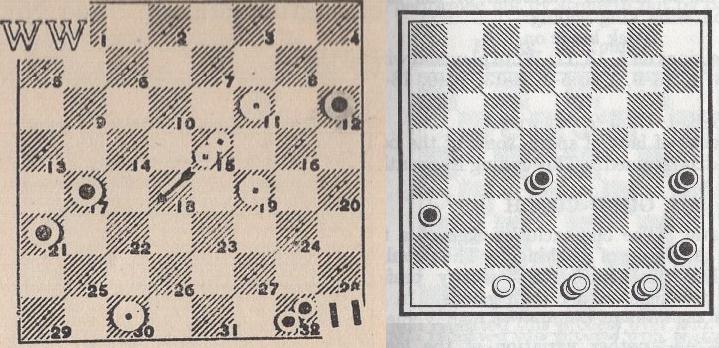
Software
Aurora Borealis Draughts by Alexander Svinn
A powerful and flexible program with options for 14 variants (all of the major variants, even Turkish and Frisian).
CheckerBoard by
Martin Fierz
A very versatile program with its own strong playing engine (called
Cake), opening book,
endgame databases, fine graphics, and facilities for reading and saving games in
PDN and positions in
FEN formats. It also acts as an interface to other programs
like Kingsrow.
Chinook by
Jonathan Schaeffer et al.
At
one time the strongest 8x8 checkers program, which won or drew several matches
against
top players. Even early versions were notable for large
endgame databases. In 2007 it proved
that go-as-you-please Anglo-American 8x8 checkers is a draw with best
play, by selectively solving enough openings to show that Black could
at least draw with 9-13 regardless of White's reply, and White had at
least one reply to each Black opening that would at least draw.
By 2009 Chinook had proven 28 of the three-move openings
were drawn, notably the White Doctor (first to be proved), Double
Cross, Octopus, Tyne,
Skull Cracker, Single Corner, and Black Widow (the last one solved,
which completed the proof for the whole game). The latest version
can be played
over the web; the website has more details about Chinook, and its
endgame databases can be downloaded. Schaeffer's book One
Jump Ahead has even more detail. Today, however, Kingsrow
and Cake are regarded as the strongest programs.
Colossus Draughts by Martin Bryant
A very strong program which won a human tournament in England in 1990,
and later that year defeated an early version of Chinook to win the 2nd
Computer Olympiad. Colossus was the first program with a
large opening book (including original research, correcting published
play). Bryant later joined the development team for
Chinook.
Dalmax Checkers
Android application with customizable rules, with presets for 12
different variants. I have not seen this: it would not
install on my Chromebook.
Kingsrow by Ed Gilbert
Powerful modern program able to play Anglo-American, International, and
Italian checkers. It includes large databases of both
openings and endgames. One of the most interesting pages
on the site is an analysis of every possible four- and five-move
sequence: Kingsrow assesses 542 out of 794 four-move sequences and 1364
out of 2700 five-move sequences as drawable. This includes
odd sequences like the Charleston line 9-14 21-17 14x21 22-18 5-9?,
where Black's poor third move is the only one which allows White to
draw what is usually a lost opening (White must then play 18-15* to set
up the two-for one capture 11x18 23x5). Kingsrow's opening
book is self-generated, and contains many strong lines which have not
appeared in published play. Another valuable page is a description of conclusive results on particular lines in some well-known openings.
Nemesis by Murray Cash
Strongest program in the world in 2002; included an 8-piece endgame
database. Enhancement of Cash's earlier program
Nexus. Many analysts in the early 2000's relied on it to
check the strength of various lines, as Kingsrow is used today.
Online Draughts Diagram Maker
Most of the diagrams in this booklet were made with this web-based
package, which is easy to use and has a large variety of options.
It also has modules for chess and fairy chess diagrams.
Sage and Dynamo by Adrian Millett
Sage is a program to play 8x8 Anglo-American checkers; Dynamo Draughts
plays 10x10 International draughts. Millett developed
Portable Draughts Notation, and is also a noted chess programmer.
Straight Checkers Gold by Al Lyman
Checkers tutorial program formerly available at www.checkerworld.com. There is a short description on the Checker Maven.
World Championship Checkers Gold by Ed Trice and Gil Dodgen
First program with a perfect play database.
Wyllie Draughts by Roberto Waldteufel
Strong program of the early 2000's, including a 7-piece database.
It won a practice match against Alex Moiseyev in 2002 with 16 wins, 3
losses, and 49 draws. See Moiseyev's Sixth for details.
Zillions of Games
A versatile software package for Windows, able to play an enormous
range of board games, particularly chess and checker variants and other
abstracts, with a programmable system. The standard
package has 19 variants of checkers built in; the website
contains hundreds of games programmed by users.
Modern programs for playing checkers (as well as other abstract
board games like chess and reversi) generally have three main parts:
(1) An opening book, consisting of thousands of opening variations in a tree structure, with evaluations
(2) A middlegame engine, which searches the game tree of a position as deeply as possible. Ideally it wants to reach an endgame position with a favorable (known) result; if not, it must evaluate each position numerically to select the best line of play.
(3) An endgame database, containing millions of positions, evaluated as
wins, draws, or losses, with a method for navigating the database to
reach the best result possible (a win if one is available; a draw
otherwise if possible; otherwise the hardest possible win for the
opponent). There are at least 3 types, in increasing order of storage and I/O requirements:
(a) WDL (Win-Draw-Loss) -- gives only the result for each
position. This can lead to missed wins in complex endgames like
Strickland's Position, by repeating king walk moves without making any progress.
(b) DTC (Distance to Conversion) -- gives the number of moves before an
irreversible move is played. This can fix the problems caused
by WDL databases, but has its own flaws.
(c) Perfect Play -- gives the correct next move in each position.
Ed Trice and Gil Dodgen computed the first 7-piece Perfect Play
database for checkers, part of their program World Championship
Checkers Gold. This guarantees the shortest solution, but not always one human players can follow.
Bibliography
Most of this bibliography covers Anglo-American checkers, and
nearly all of the books listed are in English (there are numerous books
in Russian, Dutch, and French on other variants of
checkers). It is nearly impossible, and certainly
impractical, to try and list every book and magazine devoted to
checkers. The largest collection of checkers books is probably the John Caldwell/Irving Windt Checker Books Collection,
assembled by Don Deweber, which is now located at the Loras College
Library in Dubuque, Iowa. It has well over 7000 books,
pamphlets, and magazines. I have tried
to identify the most important and frequently cited books, particularly
those considered standards in the field, and everything I can find by
the most important and prolific authors such as Boland, Ryan, and
Wiswell. General books on games with sections on checkers
are omitted, with a few exceptions. Nowadays there are several
very poor self-published books by non-experts (either print-on-demand
or in Kindle
format), which are not listed here.
Many of the works listed here are in my own
collection. As usual, pictures of the cover indicate
books which are highly recommended. Basic
bibliographic information on
other books has been gathered from a variety of sources, including
Call's The Literature of Checkers, Google
Books, WorldCat, HathiTrust, the Library of Congress; bookdealers (Bookfinder,
Amazon, Biblio, ABEBooks, Alibris, and eBay), and from online reviews on
Checker Maven and Start Checkers. Many books are
available online: some for
download, others for online reading only.
Bulletin of the Brooklyn Public Library
The 1922 edition, available at Google Books,
includes a three-part listing of checkers books (October-December
1922). This includes quite a few books published after Call
(see below).
Call, William Timothy -- The Literature of Checkers, 1908, Call, New York, 72 pp., $1.00
Bibliography of 227 books and magazines in chronological order
from 1756 (Payne) to 1908, with index.
Lovell, Kenneth -- Draughts Books of the 20th Century, 1990, Damier Books, 91 pp., (81 pp. online, without illustrations), spiralbound, ISBN 095154330X
Published in a limited edition of 100 copies; out of
print and very rare. The author compiled it to update
Call's The Literature of Checkers.
The book contains 451 entries: some book dealers give reference numbers
from Call and Lovell
(a la Köchel) in their listings. It is now available
online, courtesy of the author, on Bob Newell's Checker Maven site.
North Carolina Checkers Association: Abbreviations & Definitions
contains assorted information on books and magazines, organizations,
computer programs, a few notable people, and a little bit of history.
There are quite a few books entitled The Game of Draughts,
with a subtitle giving more specific information (often the name of an
opening). Many authors also seem to feel that no book on
checkers is complete without some problems, perhaps some poetry, and
definitely The Laws of the Game.
Anglo-American Checkers
(Draughts)
Introductory Works
Atwell, Richard -- Scientific Draughts, 1905, J.A. Kear Jr., Bristol, 186 pp., hardback
Atwell was columnist for the London Daily News, and co-edited the original version of Kear's Encyclopaedia (two parts of which had already been published).
The first part of this remarkable book is a series of short essays on various
topics, including perhaps the first discussion of Three-Move Ballot
Restriction: "After all unsound openings have been eliminated, it will
be found that there are 218 absolutely sound Openings, containing
treasures compared with which all present published play pales into
insignificance." Atwell
is counting in an odd way, not counting exchanges as part of the three
moves (so he counts 11-15 24-19 15x24 28x19 7-11 as three moves), and
eliminating certain types of moves now understood to be playable (such
as 11-15 22-17 10-14, forcing an exchange from 7). Atwell gives a complicated nomenclature for the two-move
openings, using Switcher for 21-17, Choice for 22-17, Single for 22-18,
Cross for 23-18, Regular for 23-19, Double for 24-29, and Side for
24-20, but also using Repeat for imitated moves (10-14 23-19 he terms
Denny-Repeat), Exchange for replies which force a capture (11-16 23-19
is Bristol-Exchange), and Gambit for the two 21-17 replies which give
up a piece (9-14 21-17 is Double Corner-Gambit). A dozen playable gambits (giving up a piece for a positional advantage) are listed on page 31. The
middle part of the book gives 46 endings and over 250 additional
problems, with solutions. The section of Brilliant Games contains
100 games (many of them composed) with a diagrammed middle game
position from each, presented as a problem (also with solutions); some
of these are well-known traps. A bibliography lists over
230 publications, but giving only the author or title, city, and year of
publication.
Boland, Ben -- Checkers For The Millions, 1939, Boland,
Brooklyn, 36 pp., paperback
Basic lessons in the Dyke formation, traps and shots, and
endgames. Republished two years later as The Game of Checkers (see A.J.
Mantell below).
Call, William Timothy -- Ellsworth's Checker Book, 1899, Call, Brooklyn, 65pp.
Guide to openings and 11 basic positions, from an unpublished
manuscript by Charles Ellsworth. Some of the positions are
deeply analyzed, with tables of variations similar to those used for
openings. The last section of the book is a long essay by Call on
the relative merits of chess and checkers.
Chernev, Irving -- The Compleat Draughts Player, 1981, Oxford University Press, 314 pp., paperback, ISBN 978-0192175878
Guide for beginning and intermediate players, covering most
aspects of the game (except for two- and three-move restriction), with
hundreds of diagrams (readable although the publishers chose to print
with the pieces on dark squares). Chapter 6, Logical
Draughts, Move by Move, plays through two illustrative games with
annotations of every move. Chapter 12, 100 Traps in the Opening,
has examples from almost every traditional opening. There
are dozens of annotated games and problems, biographies of some notable
players, history, and a short bibliography. Surprisingly
uncommon and expensive for a comparatively recent book.
Grover, Kenneth M., and Tom Wiswell -- Let's Play Checkers, 1940,
David McKay, 1972, Tartan, 188 pp., paperback
Good introductory book. The game section, by Grover,
recommends that beginning players play the Cross opening as White
against 11-15, and the Double Corner 9-14 as Black. The
section on mid-game structures covers some opening traps and basic
landings. There is a section on basic endings and king endings,
and a selection of 100 problems.
Held, Lawrence -- Held's Guide to the Game of Checkers, 1935, David McKay, 104 pp., hardback
Beginner's guide, but with little instruction on general tactics
except a brief description of The Move. Example games are given
in the go-as-you-please openings, with some variations and light
annotation for what he calls the 25 Standard Openings. For the 16
Secondary Openings (including the 27-20 Second Double Corner and the
26-17 Single Corner) he gives only a sample game. The middle
section includes history, tournament formats, a brief description of
Spanish Pool (Polish Draughts on the 8x8 board), and some tricks and
puzzles. The last major section is a collection of 100 problems
with solutions. The bibliography on the last page is only a
listing of books, reiterating the section on Advanced Study on p.
61. On p. 58 he mentions Four-Move Restriction as "being
discussed", and calls Eleven Man Ballot "Not checkers in the accepted term".
Hill, James -- Hill's Pocket Manual, n.d., David McKay, 64 pp., paperback
Beginner's book with endgame positions, opening traps, annotated
games, and problems.
Hopper, Millard -- An Invitation to Checkers, 1940, Simon and Schuster,
190 pp., hardback, $2.50
Excellent introductory book covering tactics, openings, and
endgames. Also in paperback as How To Play Winning
Checkers, 1943, Pocket Books.
Hopper, Millard -- Win At Checkers, 1941, A.S. Barnes, 1956,
Dover, 109 pp., paperback, ISBN 0-486-20363-8, $2.50
Very elementary book in question-and-answer format.
On page 58 he slightly oversimplifies the openings by recommending
22-18 as White's best reply (or one of the two best) to every Black
opening except 11-15.
Hopper, Millard F. -- The Major Tactics of Checkers, 1934, New York, 32 pp.
Booklet based on a series of lectures given by Hopper on radio
station WNYC. Covers openings (including what Hopper calls
the Forcing System), problems, and sample games. Diagrams
are given only on the last page, which presents 10 problems.
Jordan, Bill -- How to Play Better Checkers: Applying Chess to Checkers, 2022, Jordan, 62 pp., paperback, $11.99
Print-on-demand booklet by a (chess) Federation Master and noted writer on chess, looking
at checkers from a chess-player's viewpoint (he uses algebraic
notation, and even chess kings
in the diagrams). Superficial coverage of basic tactical
elements, an unnecessarily long endgame with two kings vs. one, and one
poorly played example game.
Landry, T.A., and L. Stephens -- Draughts, An Introduction to
Championship Play, 1984, London Draughts Association, ISBN 0-9509762-0-2
MacIntyre, Charles Coughlin -- Million Moves of Checkers, Your Study Guide To Scientific Play, 2023, 279 pp., paperback, ISBN 979-8376864920, $15.95
Print-on-demand book by a Canadian enthusiast.
The publication date says 2023, but it was assembled over decades:
the section on openings only covers the 137 pre-170 openings; elsewhere he
refers to Ron King as the current World Champion, which places it no
later than 2014. Poorly organized: no index or real
table of contents, badly printed diagrams, and quite a few typos and
other minor errors (e.g. page 68 and 149 are the same; part of the opening table on p. 25 is
misaligned, making the names and moves match up
incorrectly). Still worthwhile, with useful
information on tactics, endgames, and openings. Many
anecdotes about players both famous and not, and a listing of 70 books
and magazines.
Mantell, A.J. -- The Game of Checkers, Learn To Play Expertly In Four Easy Lessons, 1941, Padell, 34 pp., cardboard cover
One bookdealer listing has Boland as co-author,
but my copy does not show this. Mantell bought the publishing rights to Checkers for the Millions from Boland. There are errors in placement of the arrows on the diagrams on page 16.
Mitchell, David A. -- Checkers, 1918, Penn, Philadelphia, 183 pp.,
hardback
General strategy, openings and traps, endgames (including Tregaskis' Draw), a selection of Brilliant
Games, and a selection of problems with solutions.
Patterson, W. -- How To Play Checkers, 1927, Haldeman-Julius, 64 pp. paperback
Number 1183 in the famous series of Little Blue Books. Not dated, but 1182 and 1184 both appeared in 1927. Elementary instruction: the author recommends a very limited opening repertoire, and only
the Old Fourteenth and Single Corner are covered in any
detail. None of the other six Black opening moves are even mentioned. The last 13 pages give 54 lines of the Old
Fourteenth and 63 lines of the Single Corner, in tiny type, using the
Alexandrian System (each variation in one
column). The author says not moving any of 1/2/3/6/7/10 in the opening will
produce a good game for Black (and 23/26/27/30/31/32 for
White): this is sometimes called the D'Orio triangle, but isn't considered a sound principle in general. Call lists several works from the 1870's by W.
Patterson: Lovell confirms that this is the same book as Patterson's The Game of Draughts from about 1872.
Payne, William -- An Introduction to the Game of Draughts, 1756, 67 pp.
The first book on draughts in English. 50 games with no
annotation except footnotes indicating a losing move (modern practice
reverses this, using an asterisk (star move) to denote the only move to
win or hold a
draw). Includes six critical draws, eight critical wins,
and 24 strokes. No diagrams except for a numbered
board. Among the openings which appear are Single Corner, Old
Fourteenth, Cross, Will o' the Wisp, Black Doctor, and White Doctor.
Game number 1 shows the famous Goose Walk trap in the
Single Corner opening.
People's Journal -- The People's Draughts Book, n.d., People's Journal, 40 pp.,
Elementary handbook assembled from articles in the Scottish weekly newspaper The People's Journal, with elementary positions, games in the standard openings, and opening traps.
Phillips, Barnet (The "Major") -- The Checker Primer, 1887, Excelsior, New York, 24 pp., $0.10
Very elementary guide, including basic rules, 13 critical
positions (without solutions), and five sample games and variations
from Sturges. Briefly mentions Polish draughts (wrongly stating
that one queen can always draw against three) and the Losing Game.
The word checkers only appears in the title of the book and as a
subtitle on the first page; everywhere else the term draughts is used.
Reinfeld, Fred -- How To Win At Checkers, 1957, Sterling, 1967,
Wilshire, 186 pp., paperback, $2.00
Solid introductory book by a writer best known for chess
books. Republished under different titles, including How To Play Top-Notch Checkers, but to my knowledge this is Reinfeld's only book on checkers.
Reisman, Arthur -- Checkers Made Easy -- 1959, Key Publishing, New York, 107 pp., paperback
Regarded as one of the best introductory books; recommended by Pask in Book 4 of Complete Checkers: Insights (p. 327) as the first book to read for beginners.
Ryan, William F. -- It's Your Move: A New Guide to the Game of Checkers, 1929, David McKay, 115 pp.
Early book by the future U.S. Champion. 50 problems
with solutions, and a section on two-move restriction, with sample
games for most of the openings (Ryan uses compound names).
Ryan, William F. -- Scientific Checkers Made Easy, Revised Edition, 1934, 1945, 1950, John C. Winston, 205 pp., hardback
About half the book presents example games with analysis; the
remainder consists of problems, starting with what Ryan calls the Ten
Major Positions (starting with the standard four, and ending with
a three kings vs. two endgame). Diagrams printed in black and red.
Smith, Erroll A. -- The American Checker Player's Handbook, 1926, 1931, John C. Winston, 160 pp., hardback
Elementary guide with opening analysis, including the four barred openings (over 20 pages on the Barred Dundee),
transpositions, the Move, and standard positions. Diagrams
in red and black. Available at Google Books, but the PDF is missing the two-page index (viewable at Internet Archive).
Spayth, Henry -- Checkers for Beginners, Revised Edition, 1927, Regan,
86 pp., paperback
The Move, Critical positions, names of the openings, and sample games.
Spayth, Henry -- The American Draught Player, 6th edition, 1860, Dick & Fitzgerald, New York, 308 pp., hardback
Noted early American guide, including 17 openings and 1465
variations, 21 endgames and 56 variations, and 78 critical
positions. The Theory of the Move and Its Changes describes
opposition in detail, with ten diagrammed examples.
Sturges, Joshua -- Guide To The Game of Draughts, With Critical Situations, 1800, 53pp.
Collection of 54 games and 140 critical positions, expanding on
the work of Payne. The Old Fourteenth opening is named after its appearance as game number 14 in
both Payne and Sturges, although those books both give the move order
11-15 22-17; 8-11 17-13; 4-8 23-19. In 1808 Sturges published
a collection of problems, mostly from the 1800 edition, with full
diagrams printed in black and red, and expanded solutions.
Sturges's guide was revised and expanded
many times, notably by:
(1) George Walker in 1835, 87 pages, with 69 games and 150 positions; this was reprinted in Bohn's 1850 Handbook of Games.
(2) R. Martin in 1858, about 106 pp., with similar contents to Walker,
plus a short section on 10x10 Polish Draughts with two sample games,
and a brief outline of the Losing Game. This was the first
American edition, and the first to give an index of opening
names. Some of the games are still being presented
with White moving first: Game 68, a Second Double Corner, starts 22-18
9-14 18-9 5-14 instead of 11-15 24-19 15-24 28-19.
(3) Julian Darragh Janvier in 1881, 152 pages, with 20 games
showing 20 openings, and 172 critical positions, plus corrections to
earlier editions and other sources; the section on Polish and Losing
Draughts is omitted. This is much better organized
than earlier editions: Janvier has converted all of the games to Black
moving first, labeled them with opening names, and sorted them neatly
into separate columns for each variation, with sources for each
line. He uses * to denote improved moves, not necessarily star moves as understood today.
(4) J.A. Kear in 1895, 268pp., by which time it contained
example games for 27 different openings with 1466 variations, and over
200 positions with solutions. Kear also includes short
appendices giving the rules for five regional variants (Turkish,
Spanish, Polish, German, and Italian); these were expanded in the 1904
edition. Kear was co-author of the Encyclopaedia of Draughts
(see below in Openings); again, I don't know why Kear spent time doing
a second revision of Sturges in 1904 when he had already published two
parts of the Encyclopaedia).
Sweet, I.D.J. -- The Elements of Draughts, or Beginners' Sure Guide, 1859, 1872, De Witt, New York, 108pp.
Early American book by the draughts editor of the New York Clipper, the
first U.S. newspaper to feature a checkers column. Elementary guide
with the basics of endgames, openings, "the move" (on which the author
spends 17 pages, without a single diagram), and a collection of sample
games.
Trott, George E., ed. by E.C. Whiting -- The Clapham Common
Draughts Book, 1947 (unpub.), 1966, 1973 (English Draughts
Association), 2014 (PDF), 57 pp.
Beginner's guide to tactics, with emphasis on visualizing them in play. Electronic reproduction (63 pp.) with corrections and full-color diagrams by Mel Tungate.
Walker, Walton W. -- "Inside" Checkers, 1922, David McKay, Philadephia, 203 pp.
29 games and 36 problems, annotated almost move by move. Many traps are described.
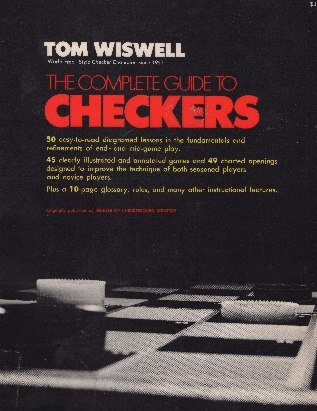
Tom Wiswell was a champion player, noted problemist, and prolific,
best-selling author. He gave the 11-15 opening the name Old Faithful in Learn Checkers Fast.
Wiswell, Tom -- Learn Checkers Fast, 1946, David McKay,
1972, Tartan, 208 pp., paperback, $1.95
Good beginner's guide, including a section on the most
common openings, ratings for all 137 three-move ballots (including
example lines for the most critical ones), traps, problems, basic
endgames (The Golden Dozen [not the formerly barred openings]), and a detailed glossary. Available at the Internet Archive.
Wiswell, Tom -- Checkers In Ten Lessons, 1953, 1959, A.S. Barnes,
126 pp., hardback, $2.95
Lesson 2, Standard Openings and Games, was written with
the assistance of Marion Tinsley, widely regarded as the greatest
player of all time. Includes a useful bibliography.
Oddly, Lesson 4, Charting Your Course, the section on two-move
openings, refers to the 11-16 opening move as Paisley, using Bristol as
the specific term for 11-16 24-20 (modern usage, including Lesson 2 of
the same book, calls all of the 11-16 openings Bristol). Reprinted in 1971 by Wilshire as Checkers Made Easy. Portions were also reprinted as part of a combination book in 1953, Championship Chess and Checkers For All, by Wiswell and Larry Evans.
Wiswell, Tom -- The Complete Guide To Checkers, 1960, Simon and Schuster, 1970, Collier, 128 pp., paperback, $1.95
Originally in hardback (1960) as Secrets of Checkerboard Strategy. After showing
the basic 3x2 and 4x3 king endings, Wiswell gives fifty problems (about
two-thirds by him). The game section starts with a chart of all
49 two-move openings (he comments that he sometimes plays the
Charleston, 21-17 against 9-14 or 10-14, as a handicap against weaker
players). 45 sample games with notes and variations are
presented, with every two-move opening except the four he considered
losses (the two Charleston openings, and 23-19 against 11-16 or
12-16). The final section of the book is a ten page
glossary, which includes a complete listing of the 142 three-move
ballots permitted in 1970 (five of these must have been added in the 1970 edition), indicating that 13 favor Black and 88
White, with 41 balanced.
Wiswell, Tom, and Jules Leopold -- The Wonderful World of Checkers and Draughts, 1981, A.S. Barnes, 176 pp., paperback, ISBN 978-0498022586
The first section consists of short chapters (one or two pages)
on important topics such as The Move, The Dog Hole, Corners and Dyke
Squares, and basics of openings and endings. The remainder of the
book consists of 50 problems, mostly composed, followed by 50 problems
from actual games (the moves leading to each position are included, and
these problems are in order of openings, from 9-13 22-18 to 12-16
24-19. Full solutions are given as usual. The only
negative is that the book appears to have been published and printed on
the cheap: there are only three diagrams in the first section;
positions are given by listing the squares with pieces/kings, and must
be set up on a numbered board. The pages are large, but the
margins are much larger and the print smaller than necessary.
Leopold wrote the puzzle and game section of Yank, the Army magazine, during World War 2, and wrote a book in 1943 called At Ease!, which includes a short section on checkers.
History and Biography
A glaring omission in the literature of checkers is a
biographical dictionary (Who's Who in Checkers?): biographical
information is scattered through hundreds of books.
Stearns' The Draughts Marvel, below, is the closest we have, but over a century out of date, as are Call's Literature and Vocabulary, which help a little too. Wyllie Draughts has decent biographies of more than 20 famous players, which only scratches the surface. Another set of 35 (mostly very skimpy) biographies is at Chinook's website. For chess, Jeremy Gaige's 1987 Chess Personalia is
the closest, but has very limited information on each player. Several of the chess encyclopedias cover the major players
at least. Wikipedia has biographies of nearly every
important chess player and writer, but only a relatively small number
of checkers and draughts players (also skimpy). All
of the checker lists skew heavily toward players, and neglect authors (e.g.
Kear, Boland, Wiswell) and other important contributors such as analysts
and problemists. [There is apparently an Encyclopedia of
Checkers by Anthony Bishop with many photos and biographies, which I
have not seen.]
Call, William Timothy -- Vocabulary of Checkers, 1909,
201pp., $2.00
Detailed encyclopedia of terms used in checkers, including names of
openings
(some of which have faded from use). One of the most useful
books ever written on checkers, containing a wealth of
historical and technical information. But it's a century out of date, and
nothing like it has been written since (Wiswell has 32 pages in Learn Checkers Fast, and 10 large pages in
The Complete Guide to Checkers).
Stearns, Lyman Marshall -- The Draughts Marvel and Twentieth Century
Checker Compendium, 1909, Draughts Marvel, Manchester, NH, 154pp.
Anthology of sketches of dozens of notable players of the
day, with photographs, problems, and games. Stearns was the
champion of New Hampshire, and editor of The Checker World
magazine. Like many books of the era, it was paid for ahead
of time by subscribers (well over 200 for this book). The Library
of Congress has scanned one of their copies, numbered 302.
Advanced strategy
Banks, Andrew J. -- Pictorial Guide to Checkers, 1940, David McKay, 244 pp., hardback
Detailed guide to strategy, including dozens of key positions
and tactical themes, and openings. The opening section is a
collection of very short essays on many aspects of
checkers. 17 illustrative games are annotated in detail with instructions for the beginner. There
are 555 diagrams: the author calls them photographic illustrations, but
they are unfortunately small and ugly, with plain pieces represented by
single dots and kings by double dots. (Surprising, considering how good the diagrams are in his problem collection Checker Board Strategy.) The author notes in
his discussion of books that the Library of Congress held 86 books on
checkers in 1938.
Banks, Newell Williams -- Banks' Scientific Checkers, 1929,
Morris-Systems, 201 pp.
Detailed textbook by a world champion player. Contains
sections on Visualization (Banks was one of the greatest blindfold
players ever), and on Banks' own invention of Eleven-Man Ballot
(including his eight game match with Asa Long, which Banks won with a
win and seven draws). The game section includes examples from all
47 playable two-move openings.
D'Orio, Julius -- Mysteries of Dama, 2nd edition, 1926, D'Orio, Highgrive, California, 206 pp., hardback
Lessons in opening and endgames by the imaginative Italian
player. He leans too heavily on maintaining a triangle of pieces
at 1/2/3/6/7/10 or 23/26/27/30/31/32, but the book is entertaining
reading with many accounts from the author's own play.
Oldbury, Derek -- Move Over, 1957, 2001, 68 pp., digital
Brilliant, idiosyncratic book by the former World Champion.
Oldbury uses his own notation based on the diagonals of the board, but
there are no annotated games, just analysis of 71
positions. Beautifully typeset in 2001 by Mathias Kegelmann, and available at Bob Newell's Checker Maven site. Richard Pask and Richard White published a supplement in 2005 (also available at The Checker Maven), with commentary, and solutions to the 22 problems at the end of Oldbury's book.
Pask, Richard -- Complete Checkers: Insights, 2nd edition, 2024,
Avi Gobbler, Honolulu, 614 pp., paperback, ISBN 978-1542464369, $24.99
One-volume compilation of Pask's five volume series Logical
Checkers
(Checkers for the Novice; Checkers for the Freestyle Expert; Checkers
for the Two-Move Expert; Checkers for the Three-Move Expert
(Balanced Ballots; Unbalanced Ballots)). Available at the Checker Maven.
Endgames and Problems
Banks, Andrew J. -- Checker Board Strategy, n.d., 159 pp.
My copy is a paperback reprint. Except for a short
section giving sample games in the traditional openings, the book is a
collection of middlegame and endgame problems. Excellent
diagrams.
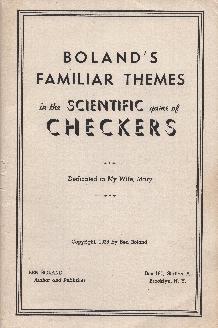
Ben Boland was a renowned endgame specialist as well as a problemist. Marion
Tinsley considered Boland the best writer on checkers.
Boland, Ben -- Familiar Themes in the Scientific Game of
Checkers, 1938, Boland, Brooklyn, 59 pp., paperback
Boland's first book, regarded by some as his best. A very
detailed catalog of endgame positions, annotated with references to
published play and examples from actual games. Most of the
positions have four pieces or fewer for each player, and each theme is
illustrated by multiple examples to help the reader understand the
concept, rather than just memorizing positions and lines of
play. Over 150 diagrams.
Boland, Ben -- Famous Positions, 2nd edition, 1940, 1965,
Boland, Brooklyn, 204 pp.
Large collection of problems, both standard endgames and positions from games, annotated in detail.
Boland, Ben -- Masterpieces in the Game of Checkers, 1947,
Boland, Brooklyn, 208 pp.
Viewable online. Collection of endgame problems, sorted into families of related problems.
Boland, Ben -- Corrections to Boland's Works, 1950, Boland, Brooklyn,
manuscript, 45 pp.
Boland, Ben -- Bridges
in the Game of Checkers, 1954, Boland, Brooklyn, 208 pp.
Definitive work on bridge positions in checkers, with classification
into 11 families, illustrated by games and problems.
Boland, Ben -- Border Classics, 1957, Boland, Brooklyn, 112
pp.
Endgame positions where some pieces are pinned on the sides of
the board, divided into 16 classes, with detailed annotation.
Boland, Ben -- Checkers in Depth, 1974, Boland, Brooklyn,
paperback, 200 pp.
Call, William Timothy -- Midget Problems, All the Ideas in Positions of
2 vs. 2 Pieces in Checkers, 1913, Call, Brooklyn, 72pp., $0.50
Early attempt to analyze and categorize endgame positions with 2 pieces
per side. The author looked at around a thousand positions from
the literature.
Duffy, Joe Mexo -- Duffy's standard positions, showing the proper
method of handling endings, 2 volumes, 1934, Duffy, Chicago, 1937, C.N. Caspar
Recommended by Pask
in Book 4 of Complete Checkers: Insights. Extremely
rare. Volume 1 is a detailed
examination of First through Fourth Position. Volume 2
covers Fifth and a variety of other positions. There are
228 diagrammed positions combined, with references and detailed
analysis.
Gould, Joseph -- Gould's Problems, Critical Positions, and Games, Third Edition, 1895, 382 pp., hardback
Enormous collection of problems from various authors, including
W.J. Wray's Bridge Position Problems. Along with Lyman, the
most important problem collections until the works of Ben Boland.
Hall, L.L. -- Hall's Instructive Positions, 1962, Hall-Martin, Los Angeles, 129 pp., hardback
Over 150 problems, some composed (ranging from 2x2 to 5x5),
others from actual play, with full solutions (except for the cover
problem).
Lyman, Henry Darius -- The Game of Draughts With Selected Problems, Richardson, Worcester, 1881, 421 pp., hardback
A small collection of games sorted by opening., followed by over
a thousand problems with solutions, from well over 200
composers. Includes 16 ornamental problems (under
Curiosities), where the pieces are arranged in geometric shapes or
other interesting configurations, plus eight problems by Thomas Dale in
Giveaway Checkers.
Pike, Robert -- 101 Checker Puzzles, Official American Mensa Game Book, 2000, Sterling, 141 pp., wirebound, ISBN 0-8069-6080-9, $7.95
Problems from opening to endgame, with diagrams and full solutions. None of the problems are credited.
Salot, Bill -- Slocum Strokes, 2011, Salot, 490 pp., PDF
Collection of over 100 problems by George H. Slocum, with annotations (including similar positions) and
references. Valuable information by Slocum and other
notables on techniques of composing checkers problems. Assembled
by Salot with help from "a Coterie of Checker Problemists and
Bibliophiles". Professionally typeset, with diagrams from
the CheckerBoard program. Available on Internet Archive's Wayback
Machine.
Wiswell, Tom -- The Science of Checkers and Draughts, 1973, A.S. Barnes, 136pp., 173 pp., hardback, ISBN
0-498-01600-5, $5.95
Primarily a collection of problems by the author and 28 other noted
problem composers: the main section is titled 101 End-game and Mid-game
Problems. Internet Archive has the large-print edition
which can be read online.
Wood, W.J. -- Draughts: Practical, Scientific Instruction on the Theory of the Move and its Practice, 1916, Waukegan Gazette, Illinois, 94 pp., hardback, $0.50
Despite its title, there is no explanation of the Move. A
collection of 138 problems, some with only partial solutions: "the
solutions were left off where the win is in plain sight."
Wood was the editor of the checker department which appeared on
Saturdays in the Waukegan Daily and Weekly Gazette.
Collections of Games
Carson, Benjamin -- Eight National Tourney of The American Checker Association, 1934, Teetzel, 156 pp., hardback
Edwin F. Hunt won the first national tournament played with the 138 three-move openings (see the notes on the Nutcracker
below). The book includes 225 annotated games with an index
by openings. Also includes photographs and biographies of
many of the players. Unlike the glossy National Tourney
books of the pre-Depression, this is printed on cheaper pulp
paper. Future World Champion Walter Hellman (spelled
here as Hallman) was the youngest player in the tournament at 18.
Chamblee, Maurice -- Checkers and the Experts, 1949, Chamblee, 63 pp., paperback
A detailed section on openings, including a history of
restriction, and an assessment of all 137 three-move
ballots. The remainder of the book contains all 30 games of
the 1947 U.S. Junior Title match, won by Marion Tinsley over Chamblee,
3 wins to 2 with 25 draws. Each game is annotated by either
one of the two players, or one of a group of 12 renowned players and
analysts, including Banks, Fortman, and Wiswell.
Dunne, Frank -- Draughts Praxis, or Modern Match Games, 5th edition, revised, 1911?, David McKay, Philadelphia, 259pp., hardback
Collection of matches and tournaments played between 1901 and
1903, with annotations and a catalog of opening variations.
(See Other Variants below for an earlier book by Dunne).
Finley, John G., ed. -- Sixth American Checker Tourney, 1925, Morris-Systems, Detroit, MI, 294 pp., hardback, $3.00
Full account of the 1924 Championship won by Samuel
Gonotsky. 361 annotated games with index of openings (using
compound names, with Regular for Black's 11-15 and Choice for White's
22-17 reply). The tournament was played under two-move
restriction including the four barred openings, all of which were
played multiple times. Photographs and biographies of all
of the players (including a teenaged Willie Ryan) are included. Nicely printed, like Teetzel's two years earlier.
Finley, John G., ed. -- Second International Checker Match, 1927, Wendemuth, Chicago, IL, 294 pp., hardback, $3.00
Full account of the 1927 team match between America and Great Britain
(12 players, round-robin). 480 games, annotated by a team of
analysts directed by August J. Heffer, with index of openings.
Another nicely printed book with glossy paper and sharp, clear
diagrams. The match was played under two-move
restriction without the four barred openings (43 openings in
all). Short biographies of all
of the players are included. The U.S., with a legendarily
strong team including Samuel Gonotsky, Newell Banks, and Asa Long,
scored an overwhelming victory, winning every day's play and eventually
winning 96 games to Great Britain's 20, with 364 draws. Every
American player had a plus score, led by Gonotsky's 13 wins, 0 losses,
and 27 draws.
Fraser, William R. -- The Inferno of Checkers, 1959, 2021, ed. and pub. L.L. Hall, 212pp., typewritten, hardback
Fraser walks the prospective
student through what he calls the heaven of go-as-you-please, the
purgatory of two-move restriction, and the hell of three-move
restriction and eleven-man ballot, with 68 analyzed games.
Only a small number of two-move openings and 42 three-move openings are covered. Available from Coachwhip
as an inexpensive e-book in EPUB format, good except for a botched table of contents.
Gonotsky, Samuel -- The Game of Checkers, A Record of the Thirty-Game
Match Between Samuel Gonotsky and Louis Ginsberg, 1925, Wendemuth, 50
pp.
Gonotsky won the 1925 match with 2 wins and 28 draws; the games are annotated by him.
Gould, Joseph, and others -- The Game of Draughts, Historic
and Memorable Matches..., 1898, 311 pp., hardback
Collection of 19th century games from various matches; very
little annotation.
Lieberman, Harry, and Louis Ginsberg -- The Third American Tourney, 1915, E.H. Greene, 368 pp.
Full account of the 1915 Checker Championship of America, the
second in a row won by Hugh Henderson. There was also a
consolation tourney held using only Edinburgh openings. There are
343 annotated games; the index of openings is in left-to-right order
for Black (12-16 first, 9-13 last), not uncommon for the two-move era
(see Kear's Encyclopaedia).
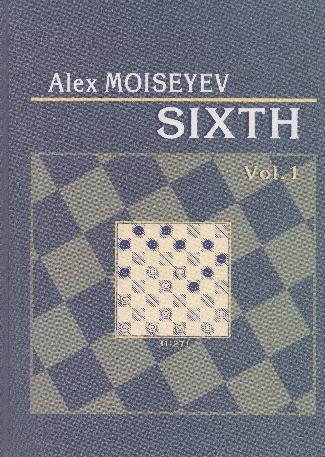
Moiseyev, Alex -- Sixth, Volume 1: The Way to the Crown, 2006, Torsing Plus, Kharkiv, 375pp., hardback, ISBN 966404-175-0
Moiseyev became a grandmaster in both Russian and International
draughts before switching to American checkers in 1996. The
title is a reference to Moiseyev being the sixth person to hold the
championship of three-move restriction checkers (starting with Asa Long
in 1934, who was succeeded by Hellman, Tinsley, Oldbury, and
King). The
book contains all of Moiseyev's games from his successful world
championship matches against Ron King and Elbert Lowder, plus 50 of his
games from other events. All of the games are superbly annotated
with references to published play, and in some cases private analysis:
Moiseyev is very generous in giving credit to others. Many
of the games are supplemented by other games with the same opening, and
there is an index of three-move ballots. There is also
plenty of information on endgames. By luck I bought the last copy of a limited run of 500, directly from
the author.
Ryan, William F., ed. Leonard L. Hall -- Big League Checkers, 1961,
Hall, Los Angeles, 197 pp., hardback
Annotated games from three of Ryan's matches. Part
Three also contains Corrections and Improvements to the second edition
of Ryan's Modern Encyclopedia, edited by by Frank Warren from Ryan's manuscript.
Seelbach, E.J. -- Seventh American Checker Tournament, 1929, Seelbach, Chicago, 48. pp, hardback
Much skimpier than most tournament books. The games
are presented as notes to a trunk game in each two-move opening, with
little annotation. Page 48 includes a list of 16 newspapers
carrying checker columns.
Smith, Erroll A. -- Checker Classics, 1922, Stewart Kidd, Cincinnati, 165pp.
Collection of annotated games.
Teetzel, M.D. -- Fifth American Checker Tourney, 1923, E.H. Greene, Hannibal, MO, 398 pp., hardback
439 annotated games from the 1922 American Checker Championship
in Boston, won by 18-year-old Asa Long, who lost only one game (to
third-place finished Louis Ginsberg). The tournament
was conducted under two-move restriction with 43 openings (the 1924
championship added the four barred openings; see Finley's book above),
which are indexed. Nicely printed on glossy paper.
Wiswell, Tom, and Millard Hopper -- Checker Kings in Action, 1952,
David McKay, 160 pp., hardback, $2.75
Collection of annotated games from the Wiswell-Hopper 1951
world championship match in go-as-you-please. Avalable at Internet Archive.
Wiswell, Tom, and Robert L. Shuffett, M.D. -- America's Best Checkers, 1957, David McKay, New York, 177pp., hardback
112 games from world championship matches in three-move
restriction, annotated by a variety of expert players and
analysts. Includes an index of openings and biographies of the
players and authors. Hassell Street Books made a photographic reprint in 2021 (ISBN 9781013957574).
Wiswell, Tom, Dr. Marion Tinsley, Professor W.R. Fraser, Derek Oldbury -- International Draughts and Checkers, 1959, A.S. Barnes, New York, 191 pp., hardback
The Restricted (three-move) world championship match between
Tinsley and Oldbury (won by Tinsley +9-1=24), and the Unrestricted
(go-as-you-please) world championship match between Wiswell and Fraser
(won by Wiswell +2-0=37), with each game annotated by one of the four
authors (not necessarily one of the players in each game). There
is also a collection of 21 problems by Wiswell and Oldbury, some from
play or analysis, and some composed.
Chapters in Hoyles and other Compendia
Most games compendia are not worth listing here, as their sections
on checkers or draughts give little more than the rules to a few
variants, and perhaps very elementary strategy that can be found in any beginner's book.
Cady, Alice Howard -- Checkers, Spalding Home Library, Vol. 1 Num. 9, 1896, American Sports Publishing, New York, 57 pp.
Elementary survey of checkers, with history, openings, and
endgames. I suspect this of being the source for the misstatement on the Second Double Corner in the New Complete Hoyle. There is a section on the Losing Game with a sample game and a few problems. The second half of the book covers Polish,
Spanish, Italian, and Turkish Draughts, with openings, problems, and
sample games (most of this comes from Dunne's 1890 Guide and Companion).
Cady wrote a series of books on various games, including backgammon,
patience, dice and dominoes, and various card games including patience.
Morehead, Albert H., Richard L. Frey, and Geoffrey Mott-Smith --
The New Complete Hoyle, 1947, 1956, 1964, Garden City, New York, 740 pp., hardback
Checkers
(Draughts) is covered from pages 616-640: mostly the Anglo-American
version,
with a survey of basic strategy, trunks for the 47 playable
two-move openings (which contain several typos), and five annotated
games, including an example of
three-move restriction. A handful of variants (including
Giveaway) are described. The section on National Variants
gives
rules for five variants, but the terminology (e.g. Polish Draughts) is
out of date, there is no mention of Pool Checkers or Russian Draughts,
and the rules for German and Turkish Draughts are wrong.
The brief introductory section gets two names wrong, giving William
Prynne for William Payne, and James Pillsbury for Harry Nelson
Pillsbury. See the historical notes on the Second Double Corner for another odd mistake. [The 1991 edition, The New Complete Hoyle
Revised, cut out the illustrative games and the variants other than the
national ones, and failed to correct any of the cited mistakes, which
have been there at least since 1956.]
Openings
Anglo-American Checkers
Appendix 1 gives an outline of the openings in
Anglo-American checkers.
Go-as-you-please
Anderson, Andrew -- Anderson's Guide to the Game of Draughts, 1848, Lanark, 73 pp.
Anderson's first edition is a collection of 55 games, with
footnotes to alternate lines of play, with a result given for each line
(draw or Black or White win). There is one page of seven Critical
Positions; there are no diagrams except a numbered board on page
6. Some of the games are presented with White moving first,
not unusual for the time. A few opening names are listed at
the bottoms of pages. A relatively unimportant work compared to
his groundbreaking Second Edition...
Anderson, Andrew -- The Game of Draughts Simplified, Second Edition, 1852, Glasgow, 154 pp.
The author notes "... it may be looked on rather as a new work
than a new edition." This was the first publication
of the Standard Laws, drawn up by Anderson after consulting with a
number of clubs and leading players, and still mostly in force.
Anderson recommends using red and white pieces for better
visibility. A trunk game is given for each of fifteen
openings, for which he lists names and their origins. These are
all still in use, although Bristol is now used to refer to all 11-16
openings, and Suter is now usually spelled Souter. The
book builds on the work of Payne, Sturges, Hay, and Sinclair, with
more than 20 other credited contributors. He credits James
Neilson with the idea of presenting every branch line in a separate
column, which became standard in later books. The book closes
with a long explanation of The Theory of The Move by John
Paterson. Anderson's book was revised several times, notably by
Robert McCulloch in 1878 and Julian Darragh Janvier
in 1881. (It's not clear to me why Janvier did separate
revisions of both Anderson and Sturges, instead of combining them into
one volume.)
Barker, Charles Francis -- The American Checker-Player, 1880, 1888, Henry A. Young, Boston, 179 pp. (plus 32 pp.), hardback
Subtitled "comprising Twenty-Two Openings, with Five Hundred and
Thirty-Four Variations of the Best Analyzed Play, together with
Thirty-Five Critical Positions, Twenty-seven of which have been
contributed by the best composers". Barker uses the now obsolete terms New Thirteenth through New
Sixteenth in his analysis to refer to the opening moves 9-13, 10-14,
10-15, and 12-16. He gives two variations of the 26x17 Single Corner and four of the 27x20 Second Double Corner.
The 1888 edition attached the 49 games (with hardly
any annotations) of the 1887 match between Barker and Robert Martins,
won by Barker three wins to one, with 45 draws. Only nine
different openings were played, and only one game (a Double Corner) did
not start with 11-15. Martins played the Fife as Black 15
times, 14 of which resulted in exactly the same drawn game from start
to finish. Barker played the Old Fourteenth 14 times as
Black, with all games drawn and one game exactly repeated six
times. Barker won one game against the Alma, which was the only win by
White in the entire match.
Denvir, John T. -- Traps and Shots, 1905, Denvir, Chicago, 115 pp.
228 examples of opening traps, and shots in the midgame and
endgame. Portions appeared in 1904 in pamphlet
form. Along with Ryan, the most notable such
collection. Rare and out of print; a reprint from around
1980 is also out of print.
Drummond, John -- The Scottish Draught Player, 1838, Drummond, Falkirk, 66 pp., hardback
Subtitled "The Theory and Practice of That Scientific Game,
Familiarly Illustrated According to the Latest and Most Approved
Mode...". 49 games with over 700 variations, including
corrections of Sturges' first edition. Black is at the top,
but moving second according to Scottish custom at the time, so the
moves are 33-complements (22-18 instead
of 11-15). None of the openings are named.
Drummond, John -- The Scottish Draught Player, 2nd edition, 1851, 1853, Drummond, Glasgow, 108 pp., hardback
Expansion of the first volume, with 1730 variations on fifteen
openings. The Cross, Fife, Glasgow, and Kelso are named here for
the first time. Other names did not catch on (Stirling for
Maid of the Mill, Provost for Will o' the Wisp, Joe's Game for
Edinburgh).
Drummond, John -- The Scottish Draught Player, 3rd edition, 1861, Drummond, Glasgow, 70 pp., hardback
New volume with many new openings; the Alma was named here for
the first time, along with no less than ten variations of the Single
Corner which Drummond gave (mostly) female names, including celebrities
such as Jenny Lind. Few of these caught on, though Fortman
mentions Lucy Long.
Drummond, John -- The Scottish Draught Player, 4th edition, 2 volumes, 1866, Drummond, Glasgow, 80 pp. each, hardback
Two new volumes with more whimsical names for Single Corner
variations, and two extra names for Old Fourteenth lines (Old
Thirty-Ninth and Old Forty-First), by analogy for the numbers of their
games in Payne and Sturges. New names still in use are
Denny (for 10-14, named after the
Scottish town he lived in for most of his life),
Flora Temple, Nailor, and Wagram. His lines for the
Denny, however, all begin with 10-14 22-18 11-16 24-19 8-11, which
transposes to the trunk line he gives for the Bristol (what would now
be called the Paisley).
Drummond, John -- The Scottish Draught Player, 2nd edition, 1853, J.A. Kear, Bristol, 300 pp., hardback
Kear's reprint, dated 1895, of Drummond's Second, one of
four volumes (actually five books) of opening analysis. This was
revised and corrected by James Lees. This volume
includes trunk games in 18 openings, with a total of 2390
variations. It has nearly three times the page count of the
original, as there is a tiny diagram at the top of each column giving
the position at the start of each variation, with five columns per
page. There is also a section with 151 positions
taken from the games, with solutions. Call's Literature of
Checkers has more details on the various editions of Drummond, one
of the most important 19th-century analysts.
Hay, William -- The Draught Player, in Four Parts, 1838, 1862, Edinburgh, 36 pp.
Subtitled "containing upwards of five thousand variations, with
critical situations, and instructions for playing the game, including
its laws, and the theory of the move, practically demonstrated".
The first part of the 1862 edition (given as 1842 in Roman numerals on
the title page), 20 pages with 1575 variations of four trunk games, is viewable online at Google Books.
He refers to the Single Corner opening as Bannockburn, and variations
of the Souter as Pioneer (unrelated to the modern Pioneer), The Needle,
and The Shuttle. See the notes on the Souter for details. All of his games have Red moving first (from the 32 end of the
board) and 33-complement moves.
Hill, James -- Hill's Synopsis of Draughts Openings, Fifth Edition,
1890, 1894, 1908, Warne, 49 pp., hardback
58 annotated games sorted by opening. Available at Internet Archive.
Jensen, Anker -- Forced Checkers, 1921, Courtney, Los
Angeles, 219pp., $2.00
Selection of openings and problems, leaning towards forcing
lines to limit the opponent's options, to reduce the amount of
memorization needed.
Ketchum, P.H. -- Checkers, The Handy Manual, 1923, Ketchum, Milwaukee,
48 pp., paperback
Games, with variations and analysis, for all of the
traditional
openings. The last two pages include some puzzles in
what is essentially peg solitaire. Available at Internet Archive.
Lees, James -- Lees' Guide to the Game of Draughts or Checkers, 1893,
New Edition Revised and Enlarged by J.W. Dawson, 1915, David McKay, Philadelphia, 208
pp., hardback, $0.75
One of the most important opening compilations of the late 19th century: 40 games in all of the traditional openings, with detailed annotations and variations. It went through numerous revisions: the Ninth Edition Improved of 1907/1909
(Frederick Warne, New York) included three pages showing how the new
two-move openings transposed into traditional openings. I have two editions: an undated
edition (from 1915 according to the Library of Congress), and a much longer (271 pp.) tenth edition expanded by John Gregg, published in 1931 by David McKay (the appendix has many corrections to play).
Livermore, S.T. -- Checkers Improved; The New Board, 1888, Cazse,
Lockwood & Brainard, Hartford, 71 pp.
Standard collection of games and variations, mainly to promote
Livermore's uncheckered board, consisting of numbered dots connected by
grid lines (an orthogonal board turned 45 degrees). The same idea can
be seen in Golomb's article on Cheskers, and dates back at least to
J.G. Lallement in 1802 (see Call's Vocabulary
of Checkers;
Call also did his own version called the Roundsquare board).
Livermore added dozens of fanciful new names for opening variations, which
did not catch on.
Robertson, John -- Guide to the Game of Draughts, 1888, Dick & Fitzgerald, New York, 308 pp., hardback
Opening guide with over 3000 variations.
Root, Stephen E. -- From Novice To Expert, 1897, Root, 22 pp.
Tabulation of opening names (a few of which have faded from
use), with six moves given for about 45 openings.
Ryan, William F. -- Tricks, Traps & Shots of the Checkerboard, 1950, David McKay, 151 pp.
Collection of checker traps, mostly illustrated by games, sorted
by openings.
Scattergood, D. -- The Game of Draughts or Checkers, 1859, A.L. Magilton, Philadelphia, 1864, Dick & Fitzgerald, New York, unnumbered, about 32pp.
Analysis of many of the standard openings, and 12 critical
positions. Oddly includes a game with the Edinburgh opening, but
completely omits Denny and Dundee: "The opening moves, 10,14 and 12,16
are not noticed in this work, as they are regarded as
weak." [Nowadays Edinburgh is understood to be the weakest
first move for Black. This was the first book to use the name Edinburgh for 9-13, although it was so named by Julian Janvier according to Call's Vocabulary.]
Various Authors -- The British Draughts Player, 1883, 1896, 1900, 1906, 432 pp., hardback
Articles on various openings, with annotated
games. William Strickland wrote the first articles in 1883 for the Leeds Mercury,
covering the traditional openings Old Fourteenth, Single Corner,
Ayrshire Lassie, Laird and Lady, and Souter. Other authors including
Tescheleit added many other openings. The Third Edition
includes a brief description of two-move restriction, merely showing
how the two-move ballots can transpose into standard openings.
Wendemuth, Frank R. -- Wendemuth's Checker Companion, 1922, 168 pp., hardback
Wendemuth was a champion player in Illinois, and edited
the checker column in the Chicago Daily News. He eventually
became a publisher of checkers books. This introductory guide
opens with a lecture on checkers and its history by Harvey L. Hopkins.
The next part of the book consists of some basic problems and
endgames, then a section of annotated games (the first few explain the
purposes of many of the moves, useful for a beginner), including some
opening traps (one of these was the Steel Stroke, a win in 1905 by
Robert Stewart against Ajeeb, the fake chess and checkers automaton,
which had a human player concealed inside). Ralph D. Banks gives
sample games in the four two-move barred openings (9-14/10-14 23-18, and
11-16/12-16 23-19). P.H. Ketchum later gives analysis of the
12-16 23-19 opening, believing it to be a loss for White (this was
proved correct in 2007 by Chinook). Wendemuth himself gives
original analysis of 9-13 22-18 11-16, believing it to be a loss for
Black (this proved incorrect; the opening became known as the Wilderness 1
(a difficult draw) and was added to three-move restriction in
2003.) The book concludes with a collection of 139 problems and
solutions.
The Two-Move Era
Denvir, John T. -- Denvir's Guide to Checkers, Third Edition,
1934, Denvir, 272 pp.
82 annotated games, sorted by openings, with hundreds of
variations. Denvir was a prolific author and publisher, and
his work is still cited today. This book is mostly
devoted to go-as-you-please and two-move openings; his 1936 guide
(below under Three-Move Compilations) covers three-move openings, but with many references back to this book.
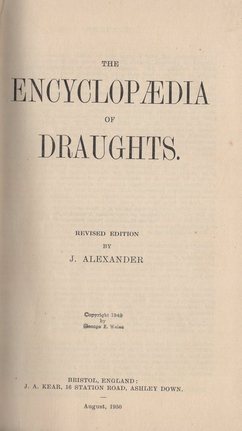
Kear, James A., and Richard Atwell; revised by John Alexander -- The Encyclopaedia of Draughts, 7 volumes, 4th Edition, 1901-1950, Kear, Bristol, 512 pp., hardback
Detailed guide to all 47 playable two-move openings.
The original seven volumes were published between 1901 and 1915, and
revised several times thereafter. Usually referred to as Kear's Encyclopaedia in the literature (James A. Kear Sr. was co-author of the original editions. His son was publisher
of later editions). Out of print and fairly
expensive. The 4th edition (1949/1950) is
viewable online at Internet Archive. The openings are
given in reverse numerical order for Black (12-16 first, 9-13 last, looking
left-to-right from Black's viewpoint), and numbered sequentially to
page 452. A separate section, The Study of Problems,
includes 186 problems (including the standard ones) with solutions,
divided into endings, devices, sacrifices, and strokes, running 52
pages. An 8-page supplement has additions and corrections,
and an index of openings. The Laws of the Game are revised from
Anderson's 1952 edition, for once including how the pieces move,
capture, and promote. Probably the best book on checkers at
the time of its publication. An underrated virtue of the book is a running head
printed at the top of most pages, showing what opening is covered,
making it easy to leaf through and find a two-move opening (compared to
the useless ones in Fortman and Pask).
Kear, James A, Jr. -- The Game of Draughts, Guide to the Two-Move Openings, 1909, Kear, Bristol, 64 pp., hardback
Very condensed guide to the 47 two-move openings (including
11-16/12-16 23-19), with every opening on one page. Each
opening has between 7 and 12 numbered variations, with almost no
annotations except a result and source, or a reference to a
transposition. A short selection of 28 problems is on pages
57-64. Available at Internet Archive.
Shearer, Henry F. -- The Modern Draughts Handbook, 1912, John Leng, Dundee, 271 pp., hardback
Compilation of two-move openings. Section 1 is
compiled from a large correspondence tournament in Great Britain, run
by Shearer, between 1907 and 1911, and sorted by openings (11-15 23-19
was deliberately omitted, probably due to overfamiliarity).
There is also a collection of 72 endgames from the tournament.
Section 2 is an analysis of the 47 two-move openings (excluding
9-14/10-14 21-17, but including the other four barred openings).
In this book, Shearer says the Edinburgh Single (9-13 22-18 11-15)
"only admits of the narrowest of draws"; he changed his view in his
1914 booklet (see below).
Tescheleit, M. Francis -- Master Play of the Draught Board, 1926-1933,
E. Marlborough, London, 484 pp.
Rare six volume series on openings: 1: Edinburgh, 2: Double Corner and
Double Corner Dyke, 3: Denny, 4: Kelso, 5: Black Dyke, Boston, Douglas,
Maid of the Mill, Pioneer, White Dyke and Switcher,
6: Single Corner. The page numbers are numbered sequentially
through the six volumes. The moves are presented in columns;
Tescheleit frequently uses X as a space-saving shorthand to indicate one
or more pairs of forced exchanges. This series was well-regarded in its day, although it covers less than half of the
11-15 repertoire and none of the Bristol and Dundee openings. Volume 6 was completed by J. M. Dallas.
Three-Move Compilations
Case, Basil -- Three-Move Checkers, My Best, 1954, C.C.C Publishing, Los Angeles, c. 116pp., spiralbound
Covers 27 of the 3-move openings, with corrections and
improvements to published play. Viewable
online. His ballot numbers don't exactly match the current
system, and he doesn't list all the ballots, so I don't know what
caused the divergence. This is an expansion and update of
analysis by Case
which appeared in Hall's Three-Move Manuscript.
Churchill, Ernest R, C.O. Skaar, and Herbert Richter -- Churchill's Compilations, 1962-1986, mimeographed pages
Ambitious attempt to collect all published play on the openings,
published in monthly installments in unbound pages. Lovell's
entry says there were 322 main installments through the completion of
12-16 in August 1981, running over 2400 pages; the index alone runs 200
pages. [Nowadays one would compile these in an electronic
database.]
Denvir, John T. -- Denvir's Three Move Guide to Checkers, 1936, 162pp., 2011, Coachwhip, ISBN 978-1616461027
Supplement to Denvir's earlier work, covering the three-move
openings. Terribly disorganized, with the openings not
listed in numerical order; the index at the beginning (at least in the reprint version) is missing
almost all of the 11-16 openings. Many of the three-move
openings point
back to the older book, but analysis is given for two of the barred
openings (now called Inferno and Wilderness 1). An 11-page appendix gives dozens of corrections, but these are not in order either. Coachwhip's
2011 reprint is still available, but it would have been better to edit
the book, put everything in order, and incorporate the
corrections. [If I were taking on the project, I would combine
both books.]
Hester, Gordon -- Transposition Studies in 3-Move Checkers, n.d., 31pp., paperback
41 positions and 113 annotated games, which can be reached from multiple openings (with index of openings).
Hall, L.L. -- Hall's Three-Move Manuscript, L.L. Hall, 1948, about 80 pp., hardcover
Covers all 137 three-move openings of the time. "Containing 50
"Cooks" and Corrections By Basil Case and Other Works on the Three-Move
Openings."
Hall, L.L., ed. -- The Nineteenth American Checker Tourney, 1956, Hall, 324 pp., typewritten, hardback
Games from the 1954 tournament, won by Marion Tinsley
without losing
a single game. The book is actually presented as a
three-move guide, as the games
are sorted by openings, with annotations and variations from other
games. The 22 openings which were not balloted are
presented with analysis by Hall, Richard Fortman, and other experts.
Hanson, Jesse B. -- Three Move Checker Chart, 1941, Hanson, pamphlet, 11pp.
Miller, William M. -- Miller's Three Move Checker Chart: A
Synopsis of the 137 Three-Move Openings, 1946, Rex B. Wood, Gary,
Indiana, 142 pp., hardback
Frankly disappointing. One page for each ballot, with 7-10 variations for each, and
cross-references on transpositions. No evaluations are given;
most lines end with a bibliographic note referencing more than 20 other
works, which is not very useful without a large library. Miller
uses *, contrary to most modern practice, "to indicate the better move, not
necessarily the only move."
Reisman, Arthur -- Championship Checkers, The Pioneer
System, Second Edition, 1942, American Photographic, Boston, 130 pp., hardback, $1.50
Opening system which can be reached, by transposition,
from almost a quarter of the 137 three-move ballots of that
era. Originally published in manuscript form by the author
in 1936. Also called How To Win At Checkers.
Ryan, William F. -- Championship Checkers Simplified, 1937, 2nd
edition 1951, Kenmore
Some history, followed by a detailed guide to the Ayrshire Lassie,
Dodger (named by Ryan for his friend Sam Schiller), and Defiance
openings. The second edition is viewable at Internet
Archive.
Ryan, William F. -- The Modern Encyclopedia of Checkers, 1940, Ryan, 195pp., 1943, American Checkerist, 236 pp., hardback
The first edition starts with an interesting autobiographical
section (My Checkered Career), and closes with a
selection of problems (especially featuring Tom Wiswell and Milton
Johnson). The bulk of the book is analysis of 11 three-move
openings,
starting with the Octopus, which was named by Ryan (32 variations,
covering 27 pages!). The 1943 second edition replaces
My Checkered Career with Ryan's fable about himself (Temoc the Titan:
Ryan was nicknamed the Bronx Comet), and drops the problem
section. But the opening section is more than twice as
long, and covers 18 (mostly difficult) three-move ballots, including the Edinburgh Single, Dreaded Edinburgh, Heebie-Jeebies, Tyne, and Ryan's Cross.
He also gives the name Oliver's Twister
to 11-16 21-17 8-11, after analyst Oliver J. Mauro. Later
corrections to the 2nd edition appeared as Part Three of Big League Checkers.
Stiles, John B. -- The Expert's Manuscript, Times Publishing (J. Hall Thompson), Minneapolis, MN, 1938, 1940, 62 pp.
Oft-cited work covering all of the three-move openings, mostly
typewritten. The first two sections (11-15 and 11-16) were
updated several times therafter, including a version called Stiles' Improved Manuscript
in 1943. In the interim Stiles published a much more
detailed guide to the 12-16 openings (see Individual Openings below).
Walker, L.D. -- Checkers Three Move Guide and Chart, a Compilation of
Checker Games Selected From Thirty-Two Sources, 1958, Walker, 55pp., spiralbound, cardboard cover and pages
Commentary on all 137 three-move openings, with one trunk for
each, and notes on transpositions. A silly flaw is that
each opening is a single column of moves, but split between two pages,
which are on opposite sides of the same sheet instead of being on
facing pages. Each opening is described briefly by an
expert (among them Banks, Fortman, Ryan, and Wiswell), and given a
rating from 1 to 3 stars favoring either Black or White.
Wood, Rex B. -- Wood's Checker Studies, Number One, May 1934, Wood, Gary, Indiana, 26 pp., paperback, $0.50
Wood, Rex B. -- Wood's Checker Studies, Number Two, August 1934, Wood, 26 pp., paperback, $0.50
Wood, Rex B. -- Wood's Checker Studies, Number Three, November 1934, Wood, 26pp., paperback, $0.50
Wood, Rex B. -- Wood's Checker Studies, Number Four, March 1935, Wood, 27 pp., paperback, $0.50
Wood, Rex B. -- Wood's Checker Studies, Number Five, June 1935, Wood, 22 pp., paperback, $0.50
Wood, Rex B. -- Wood's Checker Studies, Number Six, September 1935, Wood, 49 pp., paperback, $0.50
Wood, Rex B. -- Wood's Checker Studies, Number Seven, January 1936, Wood, 50 pp., paperback, $0.50
Wood, Rex B. -- Wood's Checker Studies, Number Eight, April 1936, Wood, 54 pp., paperback, $0.50
Wood, Rex B. -- Wood's Checker Studies, Number Nine, October 1936, Wood, 54 pp., paperback, $0.50
Wood, Rex B. -- Wood's Checker Studies, Number One, 9-13 Openings, 2nd
ed., August 1938, Wood, Gary, Indiana, 50 pp., paperback, $0.50
Wood, Rex B. -- Wood's Checker Studies, Number Two, 9-14 Openings, 2nd
ed., September 1939, Wood, 106 pp., paperback, $0.50
Nine-volume series with analysis of all of the three-move openings as
of 1939. The first eight volumes roughly correspond to the
openings from each of the seven opening moves (except that 10-15 is
split between numbers four and five, and 11-15 appears as number
eight). Later volumes also included corrections from
earlier ones; numbers one and two were later revised, cutting material
on 11-15 openings from the original number one (this was moved to
number eight). Number nine included new play on two 9-13
openings (A4E and A4I) and the traditional 11-15 openings.
Modern works
Cayton, Dennis -- A Compilation of the Barred Openings, 1996, 1997
Analysis of a number of three-move openings, some of which may be
losses for Black. Most of them were tested in the ACF's
Star Wars postal tournament, and analyzed by expert players (especially Cayton, Al Lyman, and Brian Hinkle) and
computers, including Chinook. Seven had already been approved
for postal play, and were added to the standard three-move deck in
2003. This was groundbreaking work when it was published,
though the volatile nature of many of these openings inevitably led to
later improvements (see Pask's The Golden Dozen and Complete Checkers:
Repertoire
below). It covers all of the 2003 additions except Denny Dodger,
Garter Snake, and the three Wilderness openings. It also
has analysis of some openings which proved untenable, including the
Shark, Cheetah, Rattlesnake, Nutcracker, and Barred Dundee.
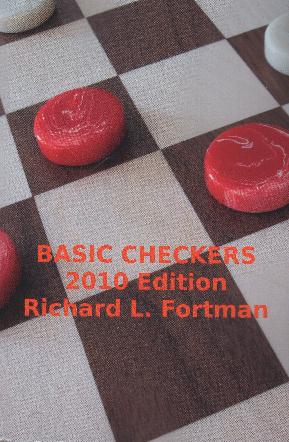
Fortman, Richard L. -- Basic Checkers: The First Twenty Moves,
1978-1983, 2010, CreateSpace, 504 pp., paperback, ISBN 978-1453619698,
$30.00
Single volume edition of Fortman's seven part series on the seven
opening moves. Comprehensive work covering the 144
three-move openings as of 1994; deeply annotated; no diagrams. Used
as a guide for creating the opening book of early versions of
Chinook. Not as comprehensive or up-to-date as Pask's Repertoire,
but explains the ideas behind the moves, has more historical content,
and is more fun to read. Any serious player needs both
Fortman and Pask. Jim
Loy published corrections in 2010 (see below).
Loy, Jim -- Basic Checkers, Part 8, Corrections, 2010, Loy, 95 pp., PDF
Electronic version
of Jim Loy's corrections to Fortman's Basic Checkers. Includes possible
refutations of the Kentucky Glasgow and Old Paraffin openings, though Kingsrow's opening book seems to find both openings sound.
Loy, Jim -- Transpositions, 2003, Loy, 46 pp., PDF
Compilation
of 34 important early landings which can be reached from multiple three-move
ballots, and a list of transpositions between different ballot
openings (showing, for example, eight other ballots which can transpose to Switcher lines).
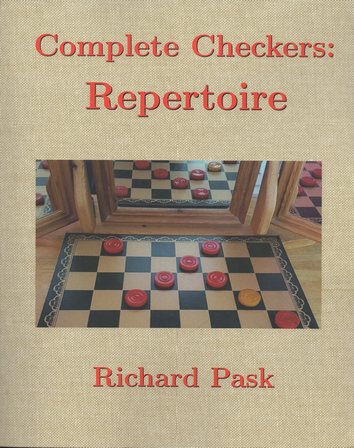
Pask, Richard -- Complete Checkers: Repertoire, 2nd edition, 2024, Avi
Gobbler, Honolulu, 458 pp., paperback, ISBN 978-883954518-2, $24.99
Now widely considered the definitive guide to three-move
openings, covering all 156 ballots in detail. It is the
most accurate opening book ever, because lines have been checked by
powerful modern computer programs like Chinook and Kingsrow.
Originally
published in
seven volumes as 21st Century Checkers.
There is a numbered diagram or two for almost every ballot, showing an
important position. Among its features is a postscript called Rambles with the 4th move,
which covers White second moves suggested by Kingsrow which are
probably sound, but not yet in the standard repertoire of published
play (many of these transpose into known lines). There is
also a list of 53 plausible moves which definitely lose, with winning
lines against them (useful for avoiding traps). Repertoire does not
explain the concepts behind the moves: those are covered in Pask's
Complete Checkers: Insights, an excellent companion volume.
If there is
one flaw, it is in the organization of variations: it can be hard
sometimes to keep track of long
alternate lines in parentheses. Italicizing branch lines in a
note
would probably help, but arguably any variation more than a few moves
ought to be separated out. As a random example, Variation 30 of
Ballot 64 which analyzes 6-9, has a parenthetical analysis of 6-10
which runs over 10 lines (containing two more subvariations in nested
parentheses), and would be clearer as Variation 31. Fortman
does this less often, and never adds parenthetical comments in his
trunk lines. It would also be clearer to me if all the
variations for a moves were listed together in parentheses, rather than
propagating them from one variation to another (e.g. Ballot 90 gives
alternates to 17-14 in varations 6, 7, 8, and 15). Fortman
doesn't mind breaking off subvariations and even subsubvariations to
make the structure easier to follow. Finally, the constant [R]'s
give the text a cluttered look; isn't everything in the trunk other
than forced moves a recommended move? If necessary, an
exclamation point or even boldface could emphasize highly recommended
moves.
Pask, Richard -- The Golden Dozen, The Twelve New Ballots,
2005, Checkered Thinking, 55 pp., ISBN 1-872796-22-2
Analysis of the 12 three-move openings which were added in 2003
to the ACF's list of playable openings. Obviously most of the analysis was incorporated into Complete Checkers: Repertoire, but the brief commentaries (including the names of the openings) were not.
Pask, Richard -- Key Landings, 1990, Checkered Thinking, 49 pp., ISBN
1-872796-00-1
Volume 3 of Total Checkers covers 25 landings
(key positions in the late opening or early midgame, each of which can
be reached from a variety of openings). Some landings are
balanced, other favor either Black or White. Many can
later develop into other landings.
Pask, Richard -- Key Openings, 1999, Checkered Thinking, 90pp., ISBN 1-872796-15X
Condensed guide to openings, starting with GAYP and continuing
through two- and three-move ballots. Includes indexes of landings and
transpositions.
Reno, Carl W. -- The Work of the Pentium, Creating New Lines of G.A.Y.P. Play, Reno, n.d., about 115pp., paperback, plastic bound
Analysis of many openings by computer (Checkers 3.0, Colossus, and Sage), cited in a number of
references. Plain typewritten manuscript, very light print, with no diagrams. The
author warns that many lines are computer generated and have not been
tested in play. Over 300 principal lines, plus annotated
variations, and references to games and published play. Very
rare nowadays: it is not listed on Amazon,
Google
Books, Library of Congress, or Worldcat. I managed to
obtain a copy of the 1st edition from eBay; there is a second edition
(2008) with corrections and new material.
Individual Openings
Openings in draughts were already being
analyzed in detail by the late 19th century (see Riley below for an
extreme case). Older opening compilations (into the early 20th century) use a system of presentation with each individual line of play given
in a numbered vertical column, with branch lines indicated by footnotes
giving the number of the column where a branch line continues.
(In the Alexandrian system, dots extend to variations on the same or a
facing page.) A short branch line may appear in the
same column if there is room, but frequently a branch line may appear
dozens of pages later. Each line of play may be from an
actual game, or published analysis of likely lines of play. The
bottom of
each column usually has an actual or predicted game result (Black wins,
Draw, or White win), and a source reference to the analyst (or book)
who first published a variation, or the players
involved if it came from a game).
Atkinson, Matthew -- White and Coloured Doctors, 1892, Bristol, 48 pp.
743 variations and 12 positions of the White Doctor and a slight
variation, named the Coloured Doctor by Atkinson. Rare.
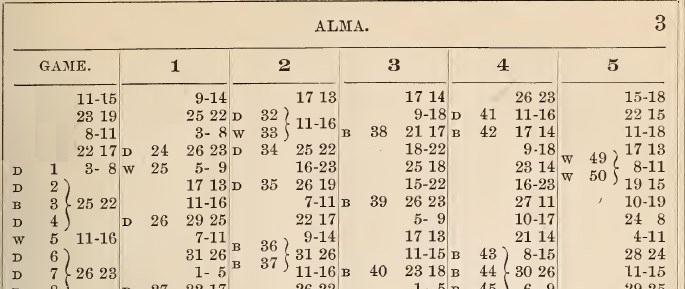
Baker, E.T., rev. James P. Reed -- The Game of Draughts, The
Alma Opening, 1888, 74pp.
431 lines of the Alma opening (11-15 23-19; 8-11 22-17; 3-8) with some
additional variations. One valuable feature is an indicator
(B, D, or W, for Black win, Draw, or White win) in front of each
variation number, so you can see the (probable) result before turning
to the column indicated. In the scan above, B 3 in front of
25-22 in the Game column indicates that the variation in column 3
(17-14 instead of 25-22) leads to a Black win. W 5 in front
of 11-16 indicates that column 5 (15-18 instead of 11-16) leads to a
White win. Why this useful innovation wasn't copied in
later works is unclear.
Boatwright, Bruce C. -- "Black" & "White" "Doctors", 1968, Boatwright, 11 pages, cardboard cover
Typewritten manuscript giving one trunk game (with variations)
for each opening, attempting to prove a Black win with the Black
Doctor, and a White win for the White Doctor. Two pages
have correction pages (no longer) glued on. In the Black
Doctor trunk, 29-25? should lose badly, but 1-6 just before note G
gives away the win, until 30-26? also loses: note G gives the
correct 28-24 and good play thereafter, but assesses the position at
the end of the note as a
Black win, when a forcing line leads to an easy draw. The
White Doctor
trunk (from the 10-14 22-18 6-10 transposition) has similar flaws, with
10-15? losing in the trunk, and in variation 7, 11-15? losing to a
three-for two or four-for-three shot via 16-11.
Boland, Ben -- White and Black Doctors, 1984, Boland, 112 pp., hardback
Boland's only book on opening analysis. It appears to be
his rarest book, and I was lucky to obtain a copy. A detailed
historical survey of both Doctor openings, with transpositions from different ballots, and two dozen landings for
each opening. The first half (pp. 5-53), on the White
Doctor, is beautifully and consistently printed. The second half (pp. 55-112), on the
Black Doctor, is a dizzying assortment of different typefaces and
smaller diagrams, pasted together from different manuscripts
and notebooks. It is mostly based on analysis from the Canadian Checker Player.
Bowen, Roland Edwin -- Cross Opening, 1878, Worcester, 196pp.
1001 lines of the 11-15 23-18 Cross opening. The pages from 197-220 are blank
except for ruled columns, presumably to allow the reader to add
notes by hand on alternate lines. Page 179 includes
some transpositions to lines of the Cross from other
openings. The last section includes 13 endgame
positions with solutions. Bowen draws on the major sources
up to that time: Payne, Sturges, Sinclair, Hay, Drummond, Anderson, and
Spayth (those seven covering about half the book), and adds analysis from himself and more than 60 other contributors.
Bowen, Roland Edwin -- Checkers, The Author's Bristol, 1886, 1889, M.F. Clouser, Worcester, 44 pp., hardback
Subtitled "A Combined Analysis of the Play of All the Authors,
from 1756 to 1880 on 24-20, 24-19 and 22-18 Lines". Rarer
than Bowen's other two compilations. The 1889 reprint is part
four of a larger work covering 2608 variations, itself volume 2 of a
series called Bowen's Authors (see Call's Literature for more details).
Bowen, Roland Edwin, M.F. Clouser, ed. -- Fife Opening, 1886, Clouser, Philadelphia, 65pp. plus blanks
Similar to his book on the Cross; 600 opening lines.
Call, William Timothy -- Rambles with the Switcher, 1916, 73pp., $0.50
Historical view and analysis of the 11-15 21-17 9-13 opening, compiled from the
existing literature. At the end he gives nine different landings the opening may reasonably be played into.
Cantor, Conrad -- The Kentucky Glasgow, 1957, L.L. Hall, Los
Angeles, 40pp., paperback
Analysis of the Kentucky Glasgow defense (see the historical notes below). The booklet is undated, but Lovell gives it as 1957. Also covers what
he calls the Glasgow Refused, claiming Black wins after 11-15
23-19; 8-11 22-17; 11-16 26-23; 15-18! (or 11-16 27-23; 16-20!).
Clow, Albert E. -- Winning Checkers, Part One (Black Wins), n.d., 64 pp, L.L. Hall, paperback
Clow, Albert E. -- Winning Checkers, Part Two (White Wins), n.d., 49 pp., L.L Hall, paperback
Each volume contains variations from the Bristol opening 11-16
(11-16 24-20 in Part Two). Part One gives 159 variations
showing wins by Black, Part Two 235 variations with White
wins. Both parts have guides showing transpositions from
other openings.
Courtney, William M. -- The Alma, A Serial Compilation; 1946, Courtney, Long Beach, CA, 68 pp.,
paperback
300 variations of 11-15,
23-19, 8-11, 22-17, 3-8. The dealer listing gives 1938 as the publication date, but my copy is dated 1946. The first page gives a supposed trunk line, but it difficult to follow and contains typos.
Courtney, William M. -- Old Fourteenth, 1946, Courtney, Long Beach, CA, 96 pp., hardback
No date: the listing I bought it from gives 1946 as the
date. Over 300 variations of the 25-22 line of the Old
Fourteenth: most of the variations cover the longer trunk 11-15 23-19;
8-11 22-17; 4-8 25-22; 9-13 27-23; 6-9 23-18; 9-14 18x9; 5x14
26-23. Confusing organization. Four pages in
the introductory section give the start of an "ABC of Checkers",
apparently the author's plan for a comprehensive glossary of terms,
players, analysts, and publications.
Courtney, William M. -- Souter, unknown, Courtney, Long Beach, CA
I have not seen this: it is cited in the literature as Courtney's Souter, and seems to be the rarest of the three.
Denvir, John T., and Percy M. Bradt -- Second Double Corner Book, Part 1 and 2, 1891, Denvir, Chicago, 38 pp., hardback
Over 500 variations of the Second Double Corner Opening,
covering 11-15 24-19 15x24 28x19, followed by 9-14 or 8-11. Parts
3 and 4 do not seem to have ever appeared.
Denvir, John T. -- Single Corner number 2, 1892, Denvir, Chicago, 122 pp., hardback
Collection of games including "wild or irregular
lines". A 20 page pamphlet by Denvir on the Single Corner
appeared earlier in 1892.
Doran, Peter -- Doran's Old 14th, 1936, Wendemuth, Chicago, 62 pp., paperback
146 principal variations of the Old Fourteenth opening, with
annotations (over 500 variations in all) and diagrams.
Reprinted in 2013 by Coachwhip (ISBN 978-1616461805).
Duffy, Joe Mexo -- Duffy's Single Corner, 1934, Frank R. Wendemuth, Chicago, 128 pp., hardback
134 principal variations of the Single Corner Opening, with annotations and many diagrams.
Durgin, Edwin A. -- Durgin's
Single Corner, 1894, John T. Denvir, 148pp., $0.50
Durgin was draughts editor for the Boston Globe. In addition to
Durgin's analysis, there are independent sections by several other
analysts. The book "also
contains Swan and Adamson's line of the Switcher". The last 12
pages (149-160) are reviews and listings for books published by Denvir, one of the major checker publishers of the era.
Fay, David A. -- The Checker Variant, A Useful Guide to Opening, Middle, and End-Game Play, 1965, Hayman, 30 pp., cardboard cover
Typewritten analysis of a rare branch of the Fife Opening: 17-13
1-5 (the author does not mention the name Fife), with hundreds of
variations. Also includes many of the standard endgames,
possibly pasted in from another book: they look they were included just to fill blank space. If the variations are meant to lead to the standard positions, it isn't made clear.
Frazer, Robert -- The International Draughtplayer, Part 1: The Ayrshire Lassie game, Frazer, 1887, Glasgow, 76 pp., softcover
447 numbered variations (and some notes giving over 500
variations in all) of the 11-15 24-20 opening. No further
parts of the series seem to have appeared, though the Draughts World later published a booklet of corrections.
Ginsberg, Louis C. -- Principles Of Strategy In The Game of Checkers, 1945, 2010, Ryan, 48 pp., paperback
Examination of the Dyke formation, one of the most important
landings.
Hester, Gordon -- Checkers, The Cross Choice Opening, 1963, Hester, 96 pp.
Detailed analysis of the Cross Choice opening, 11-15 23-28 9-14,
with well over 300 variations, as well as a transposition guide showing
how more than 60 of the three-move openings can reach the same
positions as lines of the Cross Choice.
Hester, Gordon -- Tournament Checkers: Defiance System, 1960, Hester, 142 pp., hardback
Detailed guide to the Defiance opening 11-15 23-19 9-14
27-23, including 444 variations, and an index of 57 three-move openings
which can transpose into the Defiance.
Typewritten. The last page is an announcement for Hester's
upcoming book on the Slip Cross, which I have not seen.
Ketchum, Preston -- The Game of Draughts, Flora Temple Branch of the Single Corner Opening, 1898, Ketchum, Madison, WI,
Analysis of the most famous variation (named after a racehorse)
of the Single Corner, with 280 variations of 11-15 22-18; 15x22 25x18;
12-16 29-25; 9-13. "Numerous corrections and improvements
upon published play appear here, for the first time, and this book will
be the exception if the critics do not, in, turn, discover some errors
in the play presented." 70 analysts are credited.
Includes seven transpositions and ten problems from play.
Downloadable from the Library of Congress.
Lawson, Charles -- Lawson's Switcher Guide on the Game of Checkers, 1899, Providence, RI, 141 pp.
Analysis of the Switcher opening 11-15 21-17 9-13, with 642
variations (and corrections), plus a transposition guide from the
Switcher to other common openings. Also a selection of
problems, and the usual: Standard Laws, first five standard positions,
and poems.
Lockhart, Charles Jordan -- The Black Doctor, 1995, Whitefork Press, 39 pp.
Compilation of analysis by eight analysts on a complex branch of
the Laird and Lady opening, with dozens of variations and 18
illustrative games.
Richmond, John Liddell -- The Game of Draughts: Over 150 Games and
Variations on the "Single Corner" and "Alma" Openings, 1901, Gould, Middlesborough, 57pp., 62 pp.
I have an undated Second Edition, which includes five pages of
corrections. Most of the book covers various lines in the Single
Corner: he ignores the 26x17 capture, and advocates 29-25 (nowadays
considered weak) after 25x18 12-16, giving 18-14 as a variation and
omitting 24-19 entirely. He gives the Flora Temple variation
(25x18 12-16 29-25 9-13), but omits the older 25x18 9-13 line give by
Drummond, after which White can allow the Flora Temple with 29-25, or
evade it (notably with 23-19, which transposes to a Will o' the Wisp
line good for White: see Ketchum's Flora Temple).
The section on the Alma (pp. 41-47) covers the 11-16 lines. There
is also a collection of two dozen problems with solutions.
Riley, Thomas J. -- The Game of Draughts, The 31-27 Line in "The Souter", 1892, Laurence Gilbertson, Nottingham, 36 pp.
Analysis of an alternate 20th move(!) in the Souter opening, reprinted from the West Lothian Courier (see the historical notes).
Ryan, William F. -- Streamlined Checkers, 1938, Ryan, New York, 46 pp., paperback
Analysis of the Bronx Express opening (9-14 22-18 5-9 18-15) named and advocated by Ryan (see the historical notes). Available at archive.org.
Schaefer, A., M.D., and Charles Kelly -- The Game of Checkers, Paisley, 1886, Evening Reporter, Woonsocket, 22 pp.
Dr. Schaefer was a prolific author and publisher, who edited the New York Checker Monthly in the 1880's, Schaefer's Checkerist
(with Call) in 1900-1901, and the checker column of the Newark Sunday Call in the early 1900's. This was the first of a series of pamphlets on
various openings, including original play. It was followed
by the Single Corner (Brooklyn, 1887) and a two-part series on
the Ayrshire Lassie
(Woonsocket, 1887). These four are quite rare: see details in Call's Literature.
Schaefer, Dr. A. -- The Dyke, 1900, Schaefer, New York, 26 pp., pamphlet
155 variations on the 27-23 variation of the Dyke (11-15 22-17; 15-19 24x15; 10x19 23x16; 12x19 25-22; 8-11 27-23).
Schaefer, Dr. A. -- Will o' the Wisp (7-11 Line), 1902, Schaefer, New York, 27 pp., pamphlet
Over 150 variations on the 7-11 variation of the Will o' the Wisp (11-15 23-19; 9-13 22-18; 15x22 25x18; 7-11).
Schaefer, Dr. A. -- Will o' the Wisp (26-23 Line), n.d., Schaefer, New York, 30 pp., pamphlet
Over 175 variations on the 26-23 variation of the Will o' the Wisp (11-15 23-19; 9-13 26-23).
Welen, Wendemuth, and Gilday -- Fife, 1903, Schaefer, 1903, 27 pp., pamphlet
Over 140 variations of what the authors call the Chicago Fife
(11-15 23-19; 9-14 22-17; 5-9 17-13; 15-18). After 26-23
1-5 31-26, the authors give 14-17 as the "Only move to draw at this
stage", but Kingsrow shows White very strong
after 14-17 and the double X exchange, recommending 8-11 instead of 14-17.
Schaefer, Dr. A. -- Fife (26-23 Line), 1906, Schaefer, 1903, 27 pp., pamphlet
93 variations of the 26-23 variation of the Fife (11-15
23-19; 9-14 22-17; 5-9 26-23). Also includes eight annotated
(non-Fife) games from a 1903 team match between Massachusetts and New
York.
I bought a copy of a bound volume published by Schaefer and W.T. Call (unknown date: it does not appear in Call's 1908 Literature of Checkers)
containing these five pamphlets. The analysis in the first
four of these booklets is unhelpfully divided into independent
sections, with no master trunk showing where each section
diverges. Very little stands up to modern analysis.
Shearer, Henry F. -- Studies of the Two-Move Openings, 3 volumes, 1914, 68 pp. total
Rare: I had only seen it mentioned in The Draughts Review, which puts the publication date at 1914. Shearer was a well-regarded analyst, who edited a column in the Dundee People's Journal, and published the Modern Draughts Handbook
in 1912, which covered the 47 two-move openings. These pamphlets
were evidently updated versions of a few of those, and the analysis is
deeper and more carefully explained. Part 1 covers 9-13
21-17 (Switcher) and 9-14 24-20. Part 2 covers 10-14 22-18 and 11-16 21-17 (which
Shearer mistakenly calls Leeds, supposedly following Dunne's 1890 Guide,
but Dunne actually applied the name Leeds to 11-16 22-17 and Newcastle
to 11-16 21-17). Part 3 covers 9-13 22-18. I do not
know if
there were any volumes after the initial three. Shearer
believed the Edinburgh Single (9-13 22-18 11-15) was a loss for Black (pp. 67-68): see the historical notes. Available at Internet Archive.
Stearns,
Lyman Marshall -- The Granite State Checker Series, 3 volumes bound
together, 1889-1890, Stearns, Derry Depot, New Hampshire, 52 pp.
Mostly analysis of the Laird and Lady
(35 variations) and the Single Corner (26 variations by Chris.
Pickering). Games (with variations) in a few other openings
are also included. Each volume also includes some
endgame problems with solutions. Downloadable at the Library of Congress. See also the historical notes on the Laird and Lady.
Stiles, John B. -- Stiles' Checker Guide, Part One, 12-16
Openings, 1939, Rex B. Wood, Gary, Indiana, 64pp., hardback
Part One of an intended series. As far as I can tell, no
further volumes were published. This covers all of the
three-move Dundee
ballots except the Skunk, plus four transpositions which are now listed
under other openings (G3N, G3D, G4E, and G7E). This may
have been a further update to The Expert's Manuscript (see
Three-Move Compilations above), whose section on 12-16 only ran eight
pages. Unlike its predecessor, the Checker Guide is professionally printed with clear diagrams and a clean layout.
Computers
Bryant, Martin -- The
Colossal Canadian Checker Caper, Colossus v Chinook 1993, Checker
Solutions, 25 pp., ISBN 1-874483-02-7
Brief account, with all 54 games annotated, of a friendly
match between the top two computer checkers programs of the day, won by Chinook +9
-2 =43. Bryant's Colossus program was running on an ordinary
IBM-compatible PC; Chinook on a powerful Silicon Graphics
workstation. Chinook's enormous database of endgame
positions allowed it to escape with draws from three losing positions.
Fogel, David B. -- Blondie24, Playing at the Edge of AI,
Morgan Kaufman (Academic Press), 2002, 406 + 16pp., paperback, ISBN
1-55860-783-8
The programmer's own account of Blondie24, an ambitious but only
partially successful attempt at a self-learning checkers program (using a neural
network), designed by Fogel and his partner Kumar Chellapilla.
The book is viewable online at the Internet Archive.
Includes a history of game playing computer programs, including
Deep Blue, Chinook, and Samuel's program. Schaeffer
was in contact with Fogel while it was being developed, and gives a
brief account in the revised edition of One Jump Ahead.
The program never reached the level of a strong human player,
and the programming community seemed more impressed than the checkers
community.
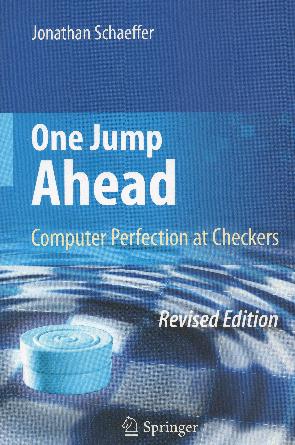
Schaeffer, Jonathan -- One Jump Ahead: Challenging Human Supremacy in
Checkers, 1997, Springer, 496 pp., hardback, ISBN 978-0387949307
Schaeffer, Jonathan -- One Jump Ahead: Computer Perfection
at Checkers, 2008, Springer, 585 pp., paperback, ISBN 978-0-387-765754, $54.95, PDF $39.99
Detailed account by the lead developer of Chinook of its
development, and in the revised edition, the result that go-as-you-please 8x8 American
checkers is a draw with best play. It is also the most
carefully researched account of the history of computer checkers ever
written: Schaeffer had access to unpublished material from Arthur
Samuel and others, and the book corrects a number of published
accounts. Uses algebraic notation with x for
captures (with Black at the top), and moves numbered and paired as in chess. Springer sells a PDF as well as a paperback edition.
Walker, Charles C., and Richard L. Fortman -- Checkers, International Checker Hall of Fame, 216 pp., spiralbound
The 1992 annual is mostly devoted to computer checkers, with
games from several matches and tournaments in which Chinook and other
programs played, several articles on computer checkers, and
descriptions of several other checkers programs.
Magazines and Newspapers
The magazines highlighted in pale blue are ones of which I own physical copies.
The Cleveland Public Library's John G. White Collection has a
notebook of magazines and newspaper columns on checkers which runs 117
handwritten pages. No author or date is given for the
notebook. There have been dozens of checkers columns
in newspapers, particularly in the United States, but these seem mostly
impossible to find online, even in large newspaper
archives. I have listed only a couple of the most notable
of these below.
ACF Bulletin -- Jim Loy, ed., American Checker Federation, bimonthly, July 1952 - present, 20 pp., $52 annual membership
Official publication of the American Checker
Federation. Games, problems (including a composing
contest), tournament schedules and results, news, and marketplace.
The American Checker Monthly -- Teetzel, M.T., publisher, bimonthly,
1920-?, 32pp., $3.00 annually
The official publication of the American Checker Association,
containing news, annotated games, and problems. I have Volume 1 (October 1920-December 1921) and most
of Volume 15 from 1935; in the November-December 1935 issue W.B. Reynolds
reported that his column in the Louisville Herald-Post had been
discontinued, and that there were only a dozen checkers columns left in American
newspapers (this was during the Depression).
American Checker Player -- Thomas Phelan, ed., et al., monthly, New York, March 1875-October 1876, 216 pp. (sequential)
Opening analysis (reprinted from various sources), games, and
problems. Succeeded by Phelan's Checker Player in 1877.
American Checker Review --
Reed, James P. ed, et al., 1888-1890
Twice monthly (later monthly) American magazine, with the usual mix of
opening analysis, games, and problems. The American Checker
Review was succeeded in 1891 by The Weekly Checker Journal, which after
a hiatus became the Checker Journal. James Patrick
Reed, the main editor, was a noted player (including blindfold) and
author, including a revision of Drummond's
book on the Alma Opening. Internet Archive
has all three yearly volumes of the Review, and a single volume with
the full run of the Journal.
The American Checkerist -- Ryan, William F., ed., January 1939 - June 1950, monthly, 28 pp., paperback, $0.50
I own all of Volume 4 (November 1944-December 1945), and the February 1950 issue (Vol. 6, Num. 2), containing news,
annotated games, letters, problems, brief biographies, and photographs (of both celebrities and checker notables).
Badger Checker Player -- James J. Lalor, ed., September 1946 - January 1967, monthly, Wisconsin
21 volumes were published. Cited and recommended by
Fortman and Hester among others. The magazine also ran a
prestigous ladder competition for mail play (players are ranked, and can move up the ladder by beating higher-ranked players).
Canadian Checker Player -- Manson D. Teetzel, ed., Teetzel, Chatham, Ontario, Canada, 1907-1912 (6 volumes)
News, history, and opening analysis, including synopses of some of the two-move openings. Google Books
has volume 2 (264 pp.), which includes analysis of the Black Doctor,
with 100 variations (spread over five issues), and four of the two-move
Edinburgh openings.
California Checker Chatter -- Leonard L. Hall, publisher, California Checkers Association, 1950-?? (Vol. 8, 1957), monthly/bimonthly, 12-24 pages
Previously published in 1949 in ditto form (purple ink). I
have volumes 1 and 2 in a bound edition. The early
issues were printed, but later they switched to typewritten. Very
few diagrams. Mix of news, games, and opening
analysis.
The Checker Clipper -- Rex B. Wood, ed., 1912-1913?, Corunna, IN, weekly newspaper, 8 pp.
I obtained a batch of issues (August 24, 1912 - February 15, 1913)
printed as Volume 1, numbers 1-25, although handprinted corrections
indicate this might be volume 2. Contains news and
commentary, correspondence, and annotated games.
The Checkergram -- Ryan, William F., ed, monthly, 36 pp., paperback
with cardboard cover, December 1929 - December 1931 (vol 2, num 9),
$0.25
Heavier on news and lighter on problems and games. I have the first five issues of volume 1.
Checkers Magazine -- International Checkers Hall of Fame, 1987-1992
Marion Tinsley was a notable contributor.
The Draught Board -- ed. by J. Tonar, later W. Patterson -- 1869-1872, Newcastle-on-Tyne
According to Call, the first magazine devoted to checkers. Extremely rare.
Draughts Razoo -- Nick McBride, ed., four issues, 2003-2004, McBride, Kingston-upon-Thames, Surrey, 24-28 pages.
Beautiful and well-received magazine from England which
unfortunately only lasted four issues. Feature articles on
openings, standard positions, and events. Excellent typography
and diagrams (Black at the bottom). Still available from the American Checker Federation.
The Draughts Review, ed. by W. G. Parker, various publishers, Hull, England, November 1924 - October 1934?, monthly, at least 20 pages
The Official Publication of the English and Welsh Draughts
Associations. The Internet Archive has the first three volumes
(Volume 1 contains 14 issues). It included frequent features on
Polish (that is, International 10x10) Draughts, and occasionally
Italian and Canadian. I bought a batch containing most of volumes
2-4 and 6-8, and part of volume 10 (up to vol, 10, num. 10, October
1934).
Elam's Checker Board -- ed. by Emin Elam, Mt. Sterling, Kentucky,
January 1947 - July 1971 (Vol. 25, Num. 7), monthly, 36 pages
Long-running American magazine with a mix of problems (by such notables
as Ben Boland and Tommie Wiswell), solving contests, opening analysis,
annotated games (including some Eleven-Man Ballot), tournament results,
and other news. The pages (except for four cover pages per
issue) are numbered sequentially from
the magazine's founding: I recently obtained a complete set of all
volumes, totalling 8140 pages. It was professionally
printed through January 1970, then returned in June 1970 with poorly
reproduced typewritten pages. It was the successor to Wood's Checker
Player: Elam had published a column in the Mt. Sterling Advocate, from 1936-1946, and
merged it with Wood's (None of the newspaper archives I searched has any issues of the Advocate from this time period).
The Empire -- various editors, New York State Checker Association, 1979-1982, bimonthly, 4-6 pages
Short-lived newsletter with news and games (some lightly
annotated), and a few problems by Tom Wiswell. Only of interest
to collectors.
English Draughts Journal -- edited by E.C. Whiting and others (most
recently P. Braithwaite), English Draughts Assocation, December 1961 -
December 2019 (v. 59 n.4), about 20 pages
The official publication of the English Draughts Association, including
news and annotated games. Richard Pask was editor from 1987-1991
and 1996-1999.
Games Digest -- ed. by Ely Culbertson, September 1937 - December 1938, 64 pp., monthly, $0.20
Bridge expert Ely Culbertson edited Games Digest,
which included a regular column on checkers edited by Newell Banks,
with problems by Thomas Wiswell and other composers, annotated games,
and opening analysis. The May 1938 issue (pp. 45-46) has
John G. Finley's analysis of the Octopus, showing 9-14 on Black's fourth move to be a
loss. The June 1938 issue (pp. 28-29)
includes an article by Bernard Talis on Stricker's Contract Checkers, including a sample game.
International Draughts Magazine -- conducted by J.A. Kear, monthly, 12 pages.
Volume 1, number 1 was dated January 1st, 1888. [International here does not refer to the modern 10x10 game.] Kear, the renowned author, analyst and publisher, had previously edited the Bristol
Draughts Player and the English Draughts Player.
Contains annotated games, opening analysis, problems,
news, and announcements of new publications. A digitized version
of the first three volumes (running through May 1892) is available online.
It suspended publication at that time, and apparently never resumed. The last issue of Volume 3 announced the formation of
the British Draughts Association, which fizzled out within a year.
Journal of the Outdoor Life -- Emil G. Gabler, checker editor
Volume 22 (1925), available online,
contains a regular feature, Our Checker Corner, with games, problems,
and analysis. This started in September 1924 and continued
at least through 1926. The 1925 columns were marred
by typos and atrocious layout (parallel vertical columns split between
pages by advertisements); the 1926 columns were on two clean
pages.
Keystone Checker Review -- Fernie Moffett, later James E. Reed, ed., bimonthly, 1956-1995
In 1994 Mr. Reed gave me four sample issues during a personal
visit. Recently I obtained a bound set of the last six
volumes, 1990-1995, numbered consecutively, 984 pages in all. Originally the official magazine of the Pennsylvania State Checker Association (under various names: see Lovell), it
began in April 1956 and was edited by Fernie Moffett from
1967-1989. One of the highlights of the 90's issues was
Dennis C. Cayton's three-part history of the barred openings.
King-Row Review -- William F. Ryan, ed., March and April 1936, 16 pages
In 1936, Willie Ryan split from the American Checker Association
and formed the North American Checker
Association. This was the official publication, but only lasted
two issues.
New England Checker Bulletin -- Cambridge, MA
North American Checker Board
Straight Master Checkers -- Edward L. Ebert, ed., Master Checkers, Detroit, MI, monthly, 20 pages, July 1973 - October 1975
I have a single bound book containing the full run under this title (through Vol.
5, Num. 4). It included problems (including cover problems by Tom
Wiswell and others), game and opening analysis. Other staff
included Jack Cox, Eugene Frazier, Richard Fortman, and Don Lafferty. Possibly
associated with NOST-Algia of the same period: the exact same size and
style (colored cardboard covers, etc.). See Lovell for details on its predecessor and successor.
Midwest Checkers -- ed. by Richard L. Fortman and Louis Van Deven, February 1979 - ??? (Vol. 12, 1990), bimonthly, 10 pages
I have the first two volumes (through December 1980, Vol.2 Num. 6) in a
single spiralbound booklet. News and games, mostly
annotated by Fortman. The June
1980 issue (Vol, 2, Num. 3, p.85) published two 21-move captureless blocked games, composed by Alan Malcolm Beckerson on March 15th and 16th, 1980. Successor to The Sixth District Newsletter (1971-1979).
Morris-Systems Checkerist -- Banks, Newell Williams, ed., monthly, 24
pages
I have several issues from 1925 (Volume
3). In addition to the usual mix of news, games, and problems, there is a
Spanish Pool Department edited by S. Herskowitz. Internet Archive has all 11 issues from 1926 (September/October was a single issue).
New British Draughts Journal, quarterly, ISSN 0966-1549
BDF, 384a Wells Road, Knowle, Bristol BS4 2QP
New Draughts World -- G.H. Snailham, ed., November 1936 - April 1950, monthly, Blackburn
Endorsed by Willie Ryan in The American Checkerist.
Rare. A listing for volume 2 of the new series gives the page
count for 1941 as 383, so the typical issue was 30-32 pages.
Recreationist -- J. Hedley, checkers editor, Leeds, monthly, 1873-1874, 168 pp.
Short-lived but influential publication, frequently cited in Call's Vocabulary of Checkers. Analysis by Dunne (who mentioned it in his Guide and Companion) and others. The important position Tregaskis's Draw
was first published here in August 1874. Several
opening names were first
proposed here, including Albion, Cross-Choice, Erin, Sunderland, and
Virginia. Other proposed names turned out to be for lines which lose [Hermit
(11-15 23-19 8-11 22-17 10-14; see Pask's Repertoire p.420, #21) and Thames (11-15 23-19 8-11 24-20; see
Pask's Repertoire p. 419, #37)] or are very weak [Mersey (11-15 22-17 9-14
17-13) and Delaware (11-15 23-19 9-14 22-17 15-18)].
Roseville Citizen -- John G. Finley, checkers editor, weekly, Citizens Publishing Company, Newark, NJ, 1915-???
I
have not been able to find out much about this periodical, which was a weekly (Thursday) newspaper, according to the Ayer Directory of Newspapers
listed in Google Books. The checker column was edited from 1921-1940 (according to Ben Boland's Bridges) by John G. Finley, an author who was secretary of the American Checker Association from 1922-1927.
None of the other usual bibliographic sources have any information
(it's not even listed in Newspapers.com), but it is one of the four
periodicals recommended in Held's 1935 Guide, and was influential enough to be cited by authors such as Boland and Willie Ryan. An regular ad in the Draughts Reviewsays
the column ran four 20-inch columns every week (about a third of
the whole paper!), calling it the "Largest Weekly Column in the
World". By accident I obtained a few pages from one issue,
folded up inside another book purchase.
The Square World -- Derek Oldbury, ed., Draughts Players' Guild, bimonthly, 16 pages, January 1965 - December 1966
Texas Longhorn Checker Bulletin -- William V. Scott, ed., Texas Checker
Association, Bowie, TX, quarterly, July 1949 - April 1952 (10 issues),
144 numbered pages
Wood's Checker Player -- ed. by Rex B. Wood, Gary, Indiana, monthly, 24
pages, December 1936 - September 1946
Successor of sorts to Wood's Checker Studies (see Three-Move Compilations above).
Other Variants
International Draughts (10x10)
Goedmoed, Tjalling -- A
Course in International Draughts, 2008, 166 pp., PDF
Kacher, Jake -- The Secrets of International Checkers, 90 pp., PDF
Westerveld, Goevert -- Beautiful Introductory Forcing Moves and Hidden
Combinations, Years 1885-1933; 2021, Academia de Estudos Humanisticos,
234 pp., hardback, 978-1-716-170156-7
Combinations taken from games, featuring history and profiles of
many top players. Many photographs and
diagrams. Available as a PDF.
Westerveld, Goevert -- Draughts is more difficult than chess, 2020, Lulu Editors, 80 pp., hardback, 978-1-716-43612-3
Bilingual text (English and Spanish). Quotations from
notable players (in both English and International) on the superiority
(or at least equality) of checkers over chess.
International draughts openings (10x10)
Babić, Mirko -- Damopenings Encyclopedie (Enciklopedija
Damistićkih
Otvaranja), Book 1 (1. 35-30, 1. 32-27), 1989, Mirko Babić, 86 pp.,
paperback
Babić, Mirko -- Damopenings Encyclopedie (Enciklopedija
Damistićkih Otvaranja), Book 2 (1. 31-27), 1989, Mirko
Babić, 168 pp., paperback
Babić, Mirko -- Damopenings Encyclopedie (Enciklopedija
Damistićkih Otvaranja), Book 3 (1. 31-25), 1990, Mirko
Babić, 113 pp., paperback
Babić, Mirko -- Damopenings Encyclopedie (Enciklopedija
Damistićkih Otvaranja), Book 4 (1. 34-30), 1990, Mirko
Babić, paperback [missing]
A collection of 10x10 games, sorted by openings, along the lines of the
Encyclopedia of Chess Openings.
World Draughts Federation, The Opening of the Game, 44 pages,
World Draughts Federation, PDF
Detailed
guide to openings in International Checkers on the FMJD website.
Pool checkers (8x8)
Black,
Clyde "Kingrow", and Archie "Checkerboard" Waters -- The Secrets
of Spanish Pool Checkers, Book 1, 1947, paperback, ISBN 978-0685208632
Black, Clyde "Kingrow", and Archie "Professor" Waters -- The
Secrets of Spanish Pool Checkers, Book 2, 1950, 173pp., hardback
Faal, Momodou, reassembled by Jake Kacher -- The "NOW" Checkers, 2024,
103 pp., numeric notation, PDF
Professional version of Faal's handwritten original.
Hanauer, Milton L. -- Checkers Made Simple, 1963, Doubleday, 175pp., large pulp paperback, $1.45
Rare book by an author who also wrote several introductory books on chess. Introductory
work on
American checkers; there is also a substantial chapter (pp. 145-163) on
Spanish Pool, including rules, tactics, endgames, and openings. The
rule differences in Russian, and Polish (i.e.
International) Checkers are also explained, and a few books on Russian
checkers are listed.
Hines, Theodore P. -- Pool Checkers or Spanish Pool, 1947, 1969,
University Place Book Shop, 125 pp., 2024, Coachwhip, ISBN 9781616465834, $22.22
49
annotated games with opening variations, and a selection of
problems. The author uses the compound names for most of the two-move openings.
Kacher, Jake -- Encyclopedia of Endings, The American Pool Checkers,
2024, 249 pp., PDF
Kacher, Jake -- Pool Checkers Collection, Strategy and Analysis, 2023, 204 pp., PDF
A series of books (mostly self-published, seemingly
all out of print and hard to find) by
Vladimir Kaplan, a grandmaster and champion player, on American Pool
checkers:
Kaplan, Vladimir -- American checkers : The Middle of
the Game, Kaplan, 1996, 233 pages, ISBN 978-0961143640
Strategy in the midgame, including restrictions and clamps, and
blockades and separation of the flanks.
Kaplan, Vladimir -- The Art of American Pool Checkers, Kaplan,
New York, 1983, 277 pp., paperback, 978-0961143602
Detailed textbook on tactics, combinations, and strategy, with hundreds
of problems and full solutions.
Kaplan, Vladimir -- The key to a success at
American checkers : Master the middle
of the game, Book 2, 1999, Kaplan, 224 pages, ISBN 978-0961143657
Among the topics are backward, hanging, and isolated pieces; pieces on
opposite flanks; encirclement of the center.
Kaplan, Vladimir -- Play Checkers and Win,
Kaplan, New York, 1988, 254 pages, ISBN 978-0961143626
The first section covers sacrifices, the remainder openings.
Kaplan, Vladimir -- Pool checkers: Theory and
Practice, 1980, David McKay, hardback, 978-0679512769
Kaplan, Vladimir -- Strive to be Superior in American Checkers,
1994, Kaplan, New York, 214 pp., ISBN 978-0961143633
Roughly half the book is a general introduction
to strategy; the rest is a detailed guide to openings. Most
of the openings are listed at the Lidraughts website.
Kaplan, Vladimir
-- The Tactics of American Pool Checkers, Book 1: Typical Sacrifices,
1984, Kaplan, 256pp., paperback, ISBN 978-09611436
Nearly 700 examples of sacrifices in pool checkers, divided into ten
categories, followed by some illustrative games.
Kaplan, Vladimir -- Tournament checkers: An introduction to pool
checkers, 1980, Taplinger, 220 pp., ISBN 978-0800842055
Basic tactics and positional strategy, with an annotated selection of
complete games and endings played by the author.
Kaplan, Vladimir M., and J. Myrick Frazier -- Pool checker
games
featuring Russian Grandmaster Vladimir Kaplan : shots, draws, wins;
1978, Pool Checker Masters, Detroit, Mich., 40 pp.
Book 5 of a series on Pool checker games.
Ramsey, George, and William Richardson -- The Amazing World of American
Pool Checkers, 218 pp.
Turkish draughts
Mamoun, Dr. John S. -- Turkish Checkers or Dama, 2021, Mamoun, 319 pp.,
paperback, ISBN 9798488793125, $11.99
Basic strategy in Turkish draughts, with hundreds of diagrams, covering
opening, middle game, and endgame tactics.
Miscellaneous
Abstract Games -- Kerry Handscomb, ed., 2000-present, quarterly/irregular, usually 32 pp.
The best magazine ever on the entire field of abstract games (excluding
orthodox chess and checkers). Periodic coverage of Bashne and Camelot, plus features on specific checker variations:
Hexdame (8), Croda (9), Dameo and Frisian (10), Lasca (11), Emergo
(13), and Sleeping Beauty Draughts (14). More details on
the magazine as a whole are on our Abstract Games page.
Babbitt, Warren Morris, M.D. -- Directions for Playing Trangle Chess and Checkers, 1897, 9 pp.
Three-handed versions of chess and checkers (also playable by
two), played on a triangular board eight triangles wide in each
direction. Each player in Trangle Checkers has 12 pieces,
on both colors; pieces can move and capture forward in three
directions, and promote on any white triangle along the farthest row.
Beasley, John -- The Classified Encyclopedia of Chess Variants, 2007, Beasley, PDF, ISBN 978-0-9555168-0-1
Second edition of David Pritchard's The Encyclopedia of Chess
Variants, reorganized by category and expanded. The
definitive work on chess variants, it includes details on several
combination chess-checkers games.
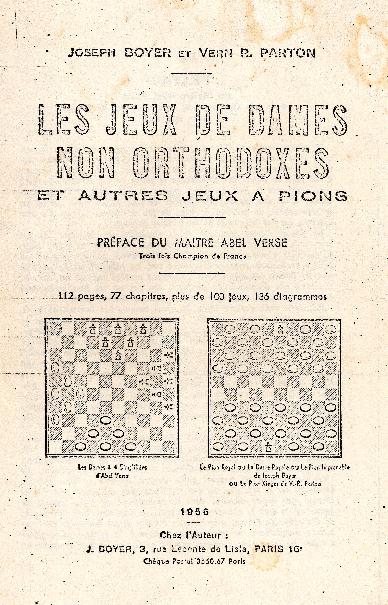
Boyer, Joseph, and V.R. Parton -- Les Jeux de Dames Non
Orthodoxes, et Autres Jeux a Pions, 1956, 112 pp.
A compendium in French containing 100 variants, at the time the
most comprehensive collection of checker variants, although some of
the games (go, reversi, mancala) are not at all variants of
checkers. Some of the games were devised by the
authors (both of
whom wrote multiple books on chess variants). There are
versions for three and four players, and versions played on three- and
four(!)- dimensional boards.
Dale, Thomas -- The Sheffield Draught Player, or The Theory and Practice of the Losing Game, 1866, F.R. Spark, Leeds, 30pp.
Apparently the first guide to Giveaway Checkers.
Dale gives rules, general theory, eight sample games, and 12 problems
with solutions, including four (impossible) positions with a single man
or king against 12 pieces in their initial positions.
Donovan, Tristan -- Great Board Games of the Ancient World, 2022, Wondrium, DVD
Chapter 11, King Me! Alquerque and Checkers (about 30 minutes),
is a brief video history of checkers, and its probable forerunner
Alquerque.
Dunne, Frank -- The Draughts-Player's Guide and Companion, 1890, Dunne, Warrington, 212 pp.
One of the most interesting 19th-century books.
More than half the book covers the English game, including the usual
sections on The Move, endgames, openings, and sample games.
There is also a section of Literary Miscellanea with stories and poems
(it is remarkable how many checker publications include poetry), five
pages on The Losing Game (mostly from T. Dale's 1886 book The Sheffield Draughts Player),
and Curious Games and Positions, which includes block games won by both
players, and T.J. Brown's 172-move Interchange, which ends with no
captures and the
positions of both players reversed (but with 6 kings each). [An
improved solution of 120 moves was published in 1968: see the Gardner
article below in Last Recreations.] There are also substantial (and complimentary)
sections on four regional variants, which include problems and sample
games: Spanish (flying kings, but no backward capture by pawns),
Italian, Polish (10x10 International; Dunne gives a few 10x10 openings
with names), and Turkish. Downloadable from the Library of Congress.
Gardner, Martin -- The Last Recreations, 1997,
Copernicus, 392 pp., hardback, ISBN 0-387-94929-1
Chapters
13 and 14, Checker Recreations Part I and II, pp. 207-232 cover
checkers, including regional and modern variations.
Part I has a number of errors which are corrected in Part II, including
the shortest known game (20 total moves with
captures, and 21 without, by Alan Malcolm Beckerson (one of a number he
discovered in
1977). Martin Bryant later proved,
using his program Colossus, that 20 total moves was the shortest
game possible.
Only one of 32 possible positions ends with a Black piece left (and
blocked); it can be reached by: 9-14 22-18; 11-15 18x11; 7x16 24-20;
2-7 20x2; 3-7 2x18; 1-6 21-17; 10-15 18x9; 5x21 23-19; 12-16 19x3; 4-8
3x12.
Gardner, Martin -- Mathematical Magic Show, 1977, 1989, The
Mathematical Association of America, 302 pp., paperback, ISBN
Chapter 14, Knights of the Square Table, pp. 197-202, covers Cheskers,
including a five move foolsmate by Wilfred H. Shepherd.
Gardner, Martin -- The Unexpected Hanging and Other Mathematical
Diversions, 1969, 1991, University of Chicago Press, 264 pp.,
paperback, ISBN 0-226-28256-2
Chapter 8, A Matchbox Game Learning Machine, pp. 90-102 describe
minicheckers variants on 4x4 and 5x5 boards. 4x4 is a draw
with best play; 5x5 with 3 checkers a side on the first and last ranks
is a win, though Gardner does not say who wins. Minicheckers on 6x6 boards was investigated at least as early as 1901
(see Minor Boards in Call's Vocabulary of Checkers).
Gibson, Walter -- Family Games America Plays, 1970, Barnes & Noble, 275 pp., paperback, ISBN 978-0064633765, $2.50
Chapter 3, Board Games, gives a brief introduction to
checkers (pp. 45-60), and a couple of pages on giveaway checkers, including an instructive illustrative game.
Golomb, Solomon W. -- "Of Knights and Cooks, and the Game of Cheskers",
Journal of Recreational Mathematics,
Vol. 1, Number 3, July 1968, pp. 130-38.
Goren, Charles H. -- Goren's Hoyle Encyclopedia of Games, 1950, 1961,
Greystone Hawthorne (Chancellor Hall), 656 pp., hardback
Includes Contract Checkers and other variants.
Knight, Damon -- Charles Fort: Prophet of the Unexplained, 1970,
Doubleday, 224 pp., hardback
Describes Fort's game of Super-checkers on pp. 177-178.
Parlett, David -- The Oxford History of Board Games, 1999, Oxford University Press, 386 pp., hardback, ISBN 0-19-212998-8
Draughts variations are covered on pp. 250-275 (most of Chapter15, Take
That!), including history, and a brief survey of regional and modern
variants.
Schmittberger, Wayne -- New Rules For Classic Games
Chapter 12, Beyond Checkers, pp. 169-184, covers 20 variants (a few of
which appear
in Boyer & Parton); it does a good job of covering regional
variants, but is very dismissive of Anglo-American checkers.
Tapalnitski, Aleh -- Meet Dameo!, 55 pages, free
PDF download
Excellent introduction to Freeling's variant, with rules, strategy,
problems, and sample games.
Twiss, Richard -- Miscellanies, Volume II, 1805, London, 391 pp.
On pages 135-240 is a long, rambling essay mostly on 10x10 Polish
(International) Draughts, with historical notes, endgame problems, and
a few variants (including a three-player variant on a triangular board,
from an 1802 book by J.G. Lallement). This was panned by
George Walker in his 1845 revision of Sturges: "His leaves smell less
of the midnight lamp, than of the paste and scissors ... whenever Twiss
is original, he is almost always found to be wrong."
Organizations
The World Draughts Federation
(Fédération Mondiale du Jeu de Dames), founded in 1947, is
an international organization uniting various national federations in
numerous forms of the game, particularly International Draughts.
The website has a great deal of information, including books and other
instructional material, on several different forms of checkers, including an opening guide to 10x10 International Draughts in PDF format. There are also downloadable books (bilingual Portuguese/English) on Brazilian draughts by Alexander Loureiro. There are also links to sites by noted historians Arie van der Stoep and Govert Westerveld. There is also an International
Draughts Federation devoted to the 64-square International game.
Among the best sources of information on the Anglo-American
game are:
The American Checker
Federation (founded in 1947
by the merger of the American Checker Association, founded in 1906,
and William F. Ryan's rival 1937 organization the National Checker
Association).
The English Draughts
Association (founded 1898); there is also a World Checkers Draughts Federation.
Websites
The Checker
Maven
(Bob Newell) is one of the richest information sites on American
checkers, with many strategy articles, reviews, and links, and
downloadable copies of numerous books, including the superb books by Richard Pask.
The North Carolina Checker
Association has
a huge website with news, history (including an archive of
newspaper articles), and instructional material.
Particularly valuable is The 1st 20 Best Published Play "Book" Moves in
3-Move Checkers, a detailed summary of all 156 ballot openings, compiled from fifteen different sources, and Abbreviations and Definitions. Another guide to openings is at the Albion High
School Alumni website.
The Checker Cruncher is
an online database of problems and games, with a clean graphical
interface. The Opening Explorer acts as a convenient interface to the Open Checkers Archive, a collection of over 22,000 games sorted by opening, developed by Hans l'Hoest, Jim Loy, and others. It gives frequencies and statistics (Black win, draw,
White win) for each move in any position, and complete historical games, similar to databases for chess openings.
Start Checkers contains introductory guides to openings, book reviews, and biographies of some
notable players.
John Savard's
website
has useful information on openings (including a history of
restrictions), and also on other variants of checkers, including his
own invention English
Gothic Double Checkers.
Checkers USA has a sizable
library of downloadable books in both checkers (Anglo-American,
International, Pool, and Russian) and chess.
The World of Pool Checkers has
links to many downloadable books in both English and Russian
(the Russian books deal with Russian checkers, very similar to American
Pool; they are in algebraic notation with diagrams, and can be followed
to some degree without any knowledge of Russian).
Many books in Dutch on 10x10 International draughts, as well as equipment (boards, pieces, and clocks) can be purchased at Damboeken.NL.
Mats Wither's Board Games
site is a rich source of information on many abstract board games,
particularly chess and draughts variants. He has
produced playable versions of many games for the Zillions
system.
Eric van Dusseldorp runs Eric's Damsite
(in Dutch, but with some content also in English and several other
languages) is a rich source of information on 10x10 International
draughts, including problems, world records, and history. (This may be out of date: the animations (probably in Flash) don't run on modern browsers.)
Sultan Ratrout has compiled a very detailed taxonomy of checkers variants, A Guide to Checkers Families and Rules.
Lidraughts is an open server for
International Draughts and six other variants; instructional material is
available, in both text form and interactive lessons (using the online
app).
PlayOK is an open server for nine variants, including Anglo-American checkers
A good video series on YouTube is by azcheckers.
Appendix 1: Anglo-American (8x8)
Checker Openings
Two-Move Ballot
The unrestricted form of Anglo-American checkers
(sometimes called go-as-you-please or GAYP) has had a world champion since 1840.
Eventually, the number of draws became so high that openings in each
game were drawn at random from all of the playable pairs (later trios)
of opening moves, forcing players to be familiar with a much wider
range of openings. [A
notorious game in the 1863 Wyllie-Martins
match was played 28 times from start to finish with exactly
the same moves. The 1887 Barker-Martins match had one game played 14 times and another five times. Martins may have done more to bring about two-move restriction than any other player.] The first system for selecting
openings at random chose
the first move for each player from a random deck of 43
possibilities, omitting six opening move pairs that produce forced exchanges which were thought to lose for
White. Four of the two-move openings formerly barred were
reinstated in 1915, with some controversy (see Banks' Scientific Checkers);
only the
21-17 reply to 9-14 or 10-14 was
still barred (these two are collectively called the Charleston, and are sometimes played by experts against novices as a handicap). 46 of the two-move openings are
part of three-move ballots [12-16 23-19 16x23, which was believed to be a
loss for White (see Cayton's A
Compilation of the Barred Openings)
is barred; in 2007, Chinook confirmed that it is in fact
lost.] Part 1 of Dennis C. Cayton's "A History of the
Barred Openings" (Keystone Checker Review,
vol. 4, num. 6, pp. 629-633, December 1993) gives much more
detail on the history of these openings between 1893 and
1931. Parts 2 and 3, covering three-move, continue in vol.
5, nums. 1 & 2.
Three-Move Ballot
Three-Move
Ballot (Three-Move Restriction) is
a later development, starting in 1931, and introduced into
the U.S. Championship in 1934. The original version (which chose
Black's first move, White's first move, and Black's second
move) was selected by a panel of five experts (A.J. Heffner, John F.
Horr, Louis C. Ginsberg, Asa Long, and H.B. Reynolds), who chose 150
openings (the American Restriction). Details and a full list can be found in the Draughts Review, Vol. 7, Num. 3, March 1931. After being tested in tournaments, it was reduced to 138 openings. The Draughts Review
reported this, almost joyfully, in Vol. 10, Num. 8, August 1934 (p.
128): "As they are rather a sorry lot their elimination rather improves
this style of restriction, and for practical purposes they may well be
definitely and permanently sunk into oblivion. There are still a
few openings left on the approved list which might appropriately follow
them to the limbo of forgotten things." [Great Britain was
slower to accept three-move restriction, and leaned toward the view
that openings should not be too unbalanced, while the American view was
generally that any tenable opening should be allowed.] In
1937, the
opening now known as the Nutcracker (10-15 22-17 9-14), soon to be shown as a loss by Willie Ryan, was voted out, leaving 137
possibilities.
In 1952, in Elam's Checker Board,
Marion Tinsley listed eight openings (four of which were rejected in
1931, and the other four were dropped shortly thereafter) which he
thought might be
drawable. He was proved correct on all eight, which were eventually reinstated.
After decades of analytical work, the permitted openings were increased
to 142 in 1970, and 144 in 1994 (both in orange
below) as more lines
were analyzed more deeply and found playable. In
1992, The American Checker Federation began a play-by-mail ladder,
under the direction of Dennis C. Cayton, to investigate the 24
three-move openings which were still barred at that time, but had
potential to be drawable. In
2003, The American
Checker Federation added 12 more playable openings (highlighted
below in light green), for a total of 156 (see Pask, The Golden Dozen). (The Black Hole was added later than the other 11.) The
156 ballots include 8 of the 12 openings which were eliminated from the
original 150, and 11 which were not even in the original
150.] Cayton and the other analysts did a remarkable job, as modern computer analysis
indicates that all of the playable three-move ballots have been
found. Alex
Moiseyev devised a special deck of 13 cards
which are shuffled before each game begins. The first card
drawn tells which line to read on the second card, giving 13 x 12 = 156
possibilities. In 1994, the world championship was split into two versions: go-as-you-please and 3-move, both still played today.
With the first three moves, there are 302 sequences, of which 86 are
transpositions [either swapping Black's first
two moves, or reaching identical positions such as 11-16/8-11 and
12-16/8-12], leaving 216
unique positions. 42 of these result in the imminent
loss of a piece, leaving 174 playable positions.
(The 1931 panel looked at 186 openings, but 12 of these were simple
swaps of Black's first two moves, which were all eliminated). Richard Atwell was
advocating for three-move
restriction as early as 1905, stating in his book Scientific Draughts
that there were "218 absolutely sound Openings",
though he was not counting exchanges, so some of his openings are actually five moves.
Four-Move Restriction
This was being discussed not very long after three-move restriction began (see Held's Guide and Banks' Checker Board Strategy), but has not been tried in any serious tournaments I am aware of. Ed Gilbert has laid a foundation
by using Kingsrow to find 542 playable positions after the first two
moves by each player. These are more favorable to Black than
three-move ballots: about 234 give Black at least a small edge,
compared to 176 for White, with the remaining positions
balanced. [In the first four moves, there are 1469 possible
sequences, yielding 805 unique positions. However, Kingsrow eliminates one of each pair of double X exchanges which yield the same position (e.g. treating 10-15 22-17 6-10 17-14 10x17 as a duplicate of 10-15 22-17 6-10 17-14 9x18), so there are only 794 essentially different four-move ballots.]
Opening names
In the 19th
century, when all play was go-as-you-please, there were two dozen or so
named openings, most of them from the 11-15 opening move, long
understood to be Black's best initial move. All of these
traditional names are still in use, and most of the openings are still
played frequently. At least nine openings are named after cities, towns, or counties
in Scotland: Denny, Dundee, Edinburgh, Fife, Glasgow, Kelso, Montrose,
Paisley, and Tillicoultry. Some sources insist that Bristol
only applies to the 24-20 reply to 11-16 (or even 11-16 24-20; 16-19), but it seems preferable to
have a single name for each Black opening move (although the strongest
and most common move, 11-15, had no accepted name until Tom Wiswell suggested the name Old Faithful,
which has become standard). Wiswell uses Paisley as the
name for 11-16 in several of his books; generally Paisley is now used
specifically for 11-16 24-19 (or even 11-16 24-19 8-11). Similarly, some sources define the Ayrshire Lassie as 11-15 24-20; 8-11 28-24,
but it nowadays refers to all 11-15 24-20 openings. Many openings
in Brazilian, Czech, Italian, and Russian Draughts, and American
Pool correspond to well-known
lines in Anglo-American checkers, though they have different
names.
In variations with backward capture (Brazilian, Russian, and American
Pool), some lines of opening theory are altered or eliminated.
Compound Names
Attempts have been made to
standardize the names for White's first move in order
to give compound names to the two-move ballots, but most of these have not
been widely adopted (they are derided by Tescheleit in his Master Play of the Draught Board). Usually White replies are designated as follows: 21-17
Switcher, 22-17 Choice (or Regular), 22-18 Single, 23-18 Cross, 23-19 Book,
24-19 Second, and 24-20 Lassie, and most two-move openings (except the
11-15's) have a compound
name: e.g. 9-14 22-18 is termed Double Single; 10-15 23-19 is Kelso
Book; 11-16 24-19 is Bristol Second (though usually called Paisley).
White's first move 11-15 was sometimes called Regular; other sources
used the traditional names like Second Double Corner and Ayrshire
Lassie. Among the books that use most of these names are
Erroll Smith's 1922 Checker Classics, the 1922 and 1924 Fifth and Sixth American Checker Tourney books, Ryan's 1929 It's Your Move, and Hines' 1947 Pool Checkers. [Atwell's 1905 Scientific Draughts
uses different terms for most of the replies.] Probably
three-move restriction caused most of the compound terms to fade from
use: Double Cross and some of the other Crosses are the most notable still in standard use.
Transpositions and Landings
There are many transpositions in the checker openings.
Learning key positions called landings
can avoid memorizing dozens of transpositions. Richard
Pask's Key Landings is a
valuable reference.
We use numerical notation with captures indicated by x; many
sources, including most older
books, do not specifically indicate captures. Underlined sets of moves are simple transpositions (different move orders). Star moves (denoted *) are moves
necessary to hold a win in winning positions, or a draw in other
positions. Forced captures are given in boldface. Openings marked AP are untenable in American Pool and other variants with backward captures, because they allow a double capture. Openings marked 150 are the twelve openings approved in 1931 but dropped when they were reduced to 138.
Barred
New 1970 and 1994 Ballots New 2003 Ballots
Traditional
Names Official
ACF Names Other 8x8 Names
[Transpositions] <Traps>
9-13 Edinburgh
Petrov's Game
9-13 21-17
9-13 21-17 5-9 5-9 Switcher (25-21 best)
9-13 21-17
6-9
6-9 Switcher (25-21 best; 24-20 is a very difficult draw; all
other moves lose)
9-13 22-17 13x22
9-13
22-18 Downfall
9-13 22-18
6-9
Dreaded
Edinburgh (historical notes)
9-13 22-18
10-14 18x9 5x14 Inferno (historical notes)
9-13 22-18 10-15
Henderson (historical notes)
9-13 22-18 11-15 18x11 Edinburgh
Single (historical notes)
9-13 22-18
11-16
Wilderness 1 (historical notes)
9-13 22-18 11-16 18-14 10x17 21x14 Australian Opening
9-13 23-18
Edinburgh Cross
9-13 23-18 10-14 Inferno 2 (historical notes)
9-13
23-18 11-16
Wilderness 2
(historical notes)
9-13 23-19 5-9 22-18 10-14 27-23 6-10 25-22 1-5 Paxton defense
9-13 23-19 10-14
9-13
23-19 10-15 19x10 Garter
Snake (historical notes)
9-13 23-19 11-15
[Will O' The Wisp]
9-13
24-19 10-14 New Edinburgh (historical notes) 1994 150
9-13 24-20
9-13 24-20 11-15 22-17 [Wagram]
9-13
24-20 11-16 20x11 Twilight
Zone (historical notes)
9-13 24-20 12-16
150
9-14 Double Corner
9-14
21-17? 14x21 Charleston
9-14 22-17
9-14 22-17 11-15
25-22 15-19 Double Corner Dyke
9-14 22-17 11-16 24-19 [Pioneer]
9-14
22-18
Kaulen's Game, or Bay State
9-14 22-18
5-9 18-15?! Bronx Express (historical notes)
9-14 22-18 11-15 Double Corner Choice
9-14 22-18 14-17
Pluto
9-14 23-18 14x23
Double
Cross (historical notes)
9-14 23-19
9-14 23-19 5-9 22-17 11-15 [Fife]
9-14 23-19
10-15? 19x10 6x15 Rattlesnake (historical notes)
9-14 24-19
9-14 24-19 10-15? (historical notes)
9-14 24-20
10-14 Denny
10-14
21-17? 14x21 Charleston
10-14 22-17
10-14 22-17
7-10
Dubious Denny (historical notes)
10-14 22-17
9-13 17x10 Black
Hole (historical notes) 150
10-14 22-17 11-15 17x10 7x14 Tinsley's Denny, or Denny
Dodger (historical notes) 150 AP
10-14 22-17 11-16 17x10 Gemini
1 (historical notes)
10-14
22-17 14-18 23x14 9x18 Heebie-Jeebies (historical notes)
10-14 22-18
10-14
22-18 7-10 Fraser's Inferno 1970 (historical notes) 150
10-14 22-18 12-16
[White Doctor] 1970 (historical notes)
10-14 23-18 14x23
Denny Exchange (historical notes)
10-14 23-19
10-14 23-19 6-10
1970 (historical notes) 150
10-14
23-19 7-10
Diabolical
Denny 1970 (historical notes) 150
10-14 23-19 7-10 19-15 Wolfville
10-14 23-19 11-15 19x10
6x15 Virginia 1994 (historical notes) 150 AP
10-14 23-19 11-15 19x10 6x15 22-18 Grand Canyon Attack
10-14 23-19 11-15 19x10 6x15 22-18 15x22 26x10 7x14 25-22 8-11 Bermuda Triangle Attack
10-14 23-19 11-16 26-23
9-13 24-20?? 14-17 21x14 6-10 20x11 10x26 31x22
8x31 <Denny trap> (or 14-17 20x11 17x26 31x22 8x31)
10-14 24-19
10-14 24-19
6-10
Nemesis (historical notes)
10-14 24-19 7-10 28-24 11-16 32-28 Hartshorn Attack
10-14 24-19 11-15? 19x10 6x15 Rattlesnake
2 (historical notes) AP
10-14 24-20
10-15 Kelso Fillipov's Game
10-15
21-17
10-15 21-17 6-10 17-13 1-6 Albion (historical notes)
10-15 21-17 7-10
Octopus (historical notes)
10-15 21-17 9-13
Tyne (historical notes)
10-15
22-17
Dyke
10-15
22-17 9-14? 17x10
7x14 Nutcracker (historical notes) AP
10-15 22-17
15-19
Skull
Cracker (historical notes)
10-15 22-18 15x22 Kelso
Single or Kelso Exchange (25x18 is best)
10-15
23-18
Kelso
Cross
10-15 23-18 6-10
Goatgetter (historical notes)
10-15 23-18 7-10
Strickland's
Cross (historical notes)
10-15 23-19
10-15 23-19 6-10
22-17 11-16?? 17-13 16x23
13x6 2x9
27x2 <Fool's
Trap>
10-15
23-19
7-10
[current ballot equivalent to older 11-15 23-19 7-11]
10-15 23-19 11-16 19x10 Gemini
2 (historical notes) 150
10-15 24-19 15x24
10-15
24-20
Kelso-Lassie
11-15
Old Faithful
11-15
21-17
Switcher (historical notes)
11-15 21-17
9-13
Reverse Game of
Bodyansky
11-15 21-17 9-13 23-18 Squirrel (historical notes)
11-15 21-17 9-13 25-21
8-11 Switcher
11-15 21-17 9-14 25-21 15-19 Switcher Dyke
11-15 21-17 10-14? Neutron Star 150
11-15
22-17
Dyke
11-15 22-17 8-11 17-13
4-8 21-17 Albemarle
11-15 22-17 8-11 17-13
4-8 23-19 [Old Fourteenth]
11-15 22-17 8-11 17-13
4-8 25-22 Douglas
(Lady of Lorna)
11-15 22-17 8-11
17-13 9-14 Erie
11-15 22-17 8-11
17-13 11-16 21-17 15-19 24x15 10x19 Kiev Defense
11-15 22-17 8-11
17-13 11-16 24-20 Leningrad Defense
11-15 22-17 8-11
17-13 11-16 25-22 15-19 24x15 10x19 New Leningrad Defense
11-15 22-17 8-11
17-13 15-18 23x14
Maid of the Mill
11-15 22-17 8-11
17-14 White Dyke
11-15
22-17 8-11
23-19
[transposes to Orthodox trunk]
11-15 22-17 8-11
25-22 11-16 Pioneer
(many transpositions)
11-15 22-17 8-11
25-22 11-16 24-19 Dyachkov's Defense
(23-18? instead is weak according
to Kaplan)
11-15 22-17 8-11
25-22 4-8 23-19 9-13 Medkov's Game
11-15 22-17 8-11 26-22
Sokov's Defense
11-15 22-17 9-13
17-14 10x17 21x14
Boston
11-15 22-17 9-13
17-14 10x17 21x14
8-11 23-19 [Laird and Lady] (historical notes)
11-15 22-17 9-13
24-20 13x22
25x11 Wagram
11-15 22-17 9-13
25-22 [Switcher]
11-15 22-17
9-14
Central Game
11-15 22-17 9-14 23-19
7-11 [Whilter]
11-15 22-17 9-14
25-22 Laurieston
11-15 22-17 9-14
25-22 15-19 [Double Corner Dyke]
11-15 22-17 15-18 Wellington
11-15 22-17 15-19
Dyke trunk
11-15 22-17 15-19 24x15 10x19 23x16 12x19 17-13 Header
11-15 22-18 15x22
Single Corner Romanicheva's Game
11-15 22-18 15x22 25x18 8-11
29-25 4-8 25-22
10-15 24-20 12-16 27-24? (or 28-24?) 15-19 24x15 16-19 23x16 9-14 18x9
11x25 <Goose Walk>
11-15 22-18 15x22 25x18 8-11
29-25 4-8 24-19? 10-15 19x10 6x29 <alternate>
11-15 22-18 15x22 25x18 8-11
29-25 4-8 18-14 10x14 21x14 9x18 23x14 Will Borland line
11-15 22-18 15x22 25x18 8-11 29-25 4-8
24-20 10-15 25-22 12-16 21-17 8-12 17-14 Maize
line
11-15 22-18 15x22 25x18 8-11 29-25
10-14 25-22 7-10 24-19 Annie Gray
11-15 22-18 15x22 25x18 8-11
23-19
[Tillicoultry]
11-15 22-18 15x22 25x18 9-13
23-19!
[Will O' The Wisp]
11-15 22-18 15x22
25x18 12-16
18-14
Lucy Long
11-15 22-18 15x22 25x18 12-16 29-25
9-13 Flora Temple
11-15 22-18 15x22 25x18 12-16 29-25 10-14 24-19 16-20 28-24 8-12 19-15 Single Corner Fife
11-15 22-18 15x22 26x17 26-17 Single Corner (weak for White; see the historical notes)
11-15
23-18
Cross
11-15 23-18 8-11
18-14 Waterloo
(or Boston Cross)
11-15 23-18 8-11
26-23 Crescent Cross (or Witch)
11-15 23-18 8-11
26-23 10-14 Crossing
11-15 23-18 8-11
26-23 9-13 Return Crossing
11-15 23-18 8-11
27-23 10-14 Short Cross (historical notes)
11-15 23-18 8-11
27-23 11-16 18x11
16-20 Slip
Cross (historical notes)
11-15 23-18 8-11
27-23 12-16?? Firehouse Cross (loses: historical notes)
11-15 23-18 9-14
Cross Choice Little Fork (historical notes)
11-15 23-18
12-16 18x11
Ryan's
Cross (historical notes)
11-15 23-18 15-19 24x15 10x19
Montrose
Cross (historical notes)
11-15
23-19
Orthodox
11-15 23-19 7-11
22-18 15x22 Whilter
Exchange
11-15 23-19 7-11
26-23 3-7 23-18 Whilter Cross
11-15 23-19 8-11
22-17 The City Game
11-15 23-19 8-11
22-17 3-8 Alma
11-15 23-19 8-11
22-17 3-8
25-22 11-16 26-23 7-11 23-18
16x23 17-13 Alma Doctor
11-15 23-19 8-11
22-17 4-8 Old
Fourteenth
11-15 23-19 8-11
22-17 9-13 Laird
and Lady (historical notes)
11-15 23-19 8-11
22-17 9-13 17-14 10x17 19x10 7x14 Black Doctor (historical notes)
11-15 23-19 8-11
22-17 9-13 17-14 10x17 21x14
Laird and Lady trunk
11-15 23-19 8-11
22-17 9-13 25-22?? Laird and Lady Refused {loses:
see p.93-94 of Lees' Guide}
11-15 23-19 8-11
22-17
9-14 Buffalo
11-15 23-19 8-11
22-17
9-14 25-22 11-16 26-23 Glasgow-Whilter
11-15 23-19 8-11
22-17
9-14 25-22 14-18? Chicago {loses}
11-15 23-19 8-11
22-17 11-16 Glasgow
11-15 23-19 8-11
22-17 11-16 24-20 16x23 27x11 7x16 20x11
3-7 28-24 7x16
24-20 16-19 25-22 4-8 29-25 9-14
22-18 14x23
Martin's Rest
11-15 23-19 8-11
22-17 11-16 24-20 16x23 27x11 7x16 20x11
3-7 11-8 African Glasgow
11-15 23-19 8-11 22-17 11-16 25-22 16x23 27x11 7x16 32-27
Kentucky Glasgow (historical notes)
11-15 23-19 8-11 22-17 11-16 26-23
15-18* Glasgow Refused (see Cantor)
11-15 23-19 8-11
22-17 15-18 Center
11-15 23-19 8-11
22-18 15x22 Tillicoultry (or Cuckoo) (historical notes)
11-15 23-19 8-11 26-23
Nailor (or New York) Old Game
11-15 23-19 8-11
27-23 Dodger (historical notes)
11-15 23-19 8-11
27-23 9-14 [Defiance]
11-15 23-19
9-13
Will O' The Wisp (historical notes)
11-15 23-19 9-14
22-17 5-9 Fife (historical notes)
11-15 23-19 9-14
22-17 5-9 17-13 15-18 Chicago Fife
11-15 23-19 9-14
22-17 6-9 Souter (historical notes)
11-15 23-19 9-14
22-17 6-9 17-13
2-6 25-22 14-17 Pioneer
11-15 23-19 9-14
22-17 7-11 Whilter
11-15 23-19 9-14
22-17 14-18 Sunderland
11-15 23-19 9-14 26-23 Erin
11-15 23-19 9-14
27-23 Defiance (historical notes)
11-15 23-19 10-14 19x10 6x15 [Virginia]
11-15 24-19 15x24
Second Double Corner (historical notes)
11-15 24-19 15x24 28x19 8-11 22-17
New
Opening
11-15 24-19 15x24 27x20 27-20 Second Double Corner (historical notes)
11-15
24-20
Ayrshire
Lassie
11-15 24-20 8-11
27-24 Old Paraffin
(historical notes)
11-15 24-20 8-11 28-24 Ayrshire Lassie trunk
11-15 24-20 15-19 23x16 12x19 [Bristol trunk]
11-16
Bristol
11-16
21-17
Newcastle (historical notes)
11-16
21-17 7-11 17-13 Baby Octopus, or Octopus Refused (historical notes)
11-16 21-17 8-11 Oliver's
Twister (historical notes)
11-16 21-17 9-14 25-21 16-19 Paisley-Dyke
11-16
21-17 10-14 17x10
Shark 150
11-16
22-17
Leeds (historical notes)
11-16 22-17
9-13
Wilderness
Companion (historical notes)
11-16 22-17 9-13 17-14 10x17 21x14 [Wilderness 1, or Australian opening]
11-16 22-17
9-14 Cheek
11-16
22-18
London
11-16 22-18
8-11
Millbury
11-16 22-18
8-11 18-14 9x18 23x14
10x17 21x14 Reverse Header
11-16 22-18 9-13
18-14 10x17 21x14
Reverse
Picket (see Aron
Zlobinskiy's study in Russian)
11-16 22-18 10-14
25-22 Refused Reverse City Game
11-16 22-18 10-14 25-22 Reverse City Game
11-16 22-18 10-14 25-22 8-11 24-20
16-19 23x16
14x23 26x19 White Doctor
11-16
22-18 10-15 18x11 8x15
Cheetah 150
11-16
23-18
Bristol Cross
11-16 23-18
7-11
Manchester
11-16 23-18 8-11 New Bristol
11-16 23-18 16-20
three-move Bristol Cross
11-16 23-18 16-20 24-19 Spanish opening (see Louriero)
11-16 23-18 16-20 24-19
8-11? 19-15 10x19
18-14 9x18
22x8 4x11
27-24 20x27 31x8
<Canalejas stroke>
11-16
23-19 16x23
Black
Widow (historical notes)
11-16
24-19
Paisley
11-16 24-19 8-11
22-17 Cheek
11-16 24-19 8-11 22-18 10-14 25-22 16-20 29-25? Paisley Pickle Barrel
11-16
24-19 8-11 22-18 10-14 26-22 16-20 22-17
7-10 30-26 11-16 26-22 Paisley trunk
11-16 24-19 8-11
22-18 4-8 26-22 16-20 Jaywalker
11-16
24-20 7-11 1970
11-16 24-20
9-13
[original version of Twilight Zone]
11-16 24-20 9-13 20x11 8x15 Liverpool (much weaker than 7x16 according to Kingsrow)
11-16 24-20 16-19 23x16 12x19 Bristol trunk Russian Opening (see Louriero)
11-16 24-20 16-19 23x16 12x19 22-18 8-11? [Bristol Trap]
11-16 24-20 16-19 23x16 12x19 27-23 8-12* Knockdown Bristol
12-16 Dundee
12-16
21-17
Dundee-Switcher
12-16 21-17
9-14
Minotaur (historical notes)
12-16
22-17
12-16
22-18
[8-12 Millbury]
12-16 23-18
12-16
23-19 16x23 (historical notes)
12-16 24-19
12-16 24-19
8-12
[Paisley]
12-16
24-20
Bodyansky's Game
12-16 24-20 8-12
Bonnie
Dundee (historical notes)
12-16 24-20 10-15
Skunk (historical notes)
Synopsis of Three-Move Openings
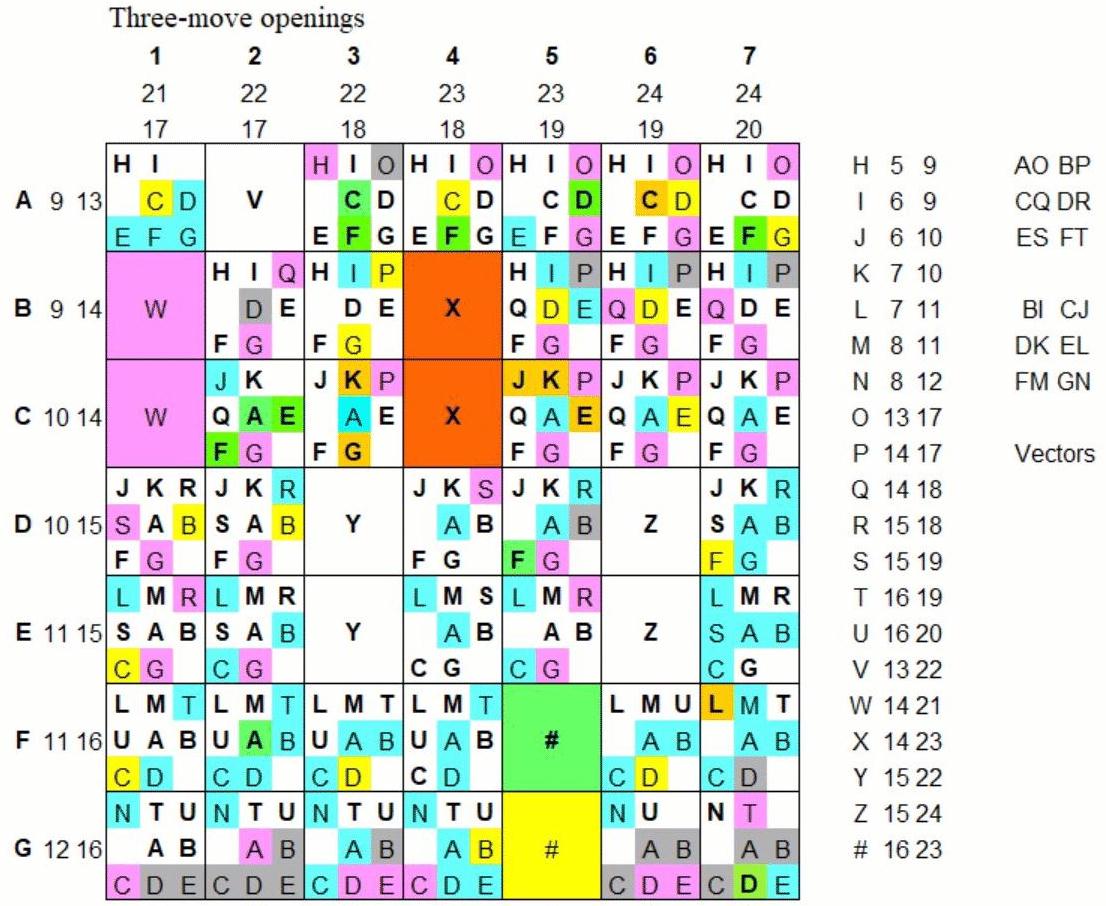
The chart above shows all 302 possible three-move
opening sequences in Anglo-American checkers. The opening
Black moves are lettered A-G, and White's responses numbered 1-7
(following Kear's 1895 revision of Sturges and Newell Banks' Scientific
Checkers). Letters H-U continue for Black's second move
(Rex Wood's extension from the last issue of Wood's
Checker Studies, 1939, 2nd edition of number 2); W through # are logical designations for the
six forced captures. There are 216 unique positions. The 86 transpositions consist of 59
reversed transpositions from swapping Black's first two moves, 11 from outside vectors
where a piece moves twice by different routes (e.g. 11-15 22-17 15-19 =
11-16 22-17 16-19, or E2S = F2T), and 16
from inside vectors where
a
piece moves and a second rank piece takes its place (e.g. 11-16 22-18
8-11 = 12-16 22-18 8-12, or F3M = G3N, the Millbury). 66 of the
transpositions (light blue) are equivalent to playable openings; the
other 20 (gray) are equivalent to one of the 42 pink openings which
lose a piece
without
compensation, or to a barred opening (yellow).
Openings in boldface are
the 156
approved ACF openings;
the seven shaded in light orange were added in 1970 or 1994, increasing
from 137 to 144; the twelve in green (the Golden Dozen) were added in 2003, increasing to
the current
156. The 18
openings
shaded yellow are barred: positions that do not immediately lose a piece, but are nevertheless thought to lose
(for Black, except G5). Modern
computer analysis indicates that none of the 18 are drawable, so the
current 156 ballots represent all of the sound
openings. The two openings shaded in dark orange were
initially barred from two-move restriction, but were later added; both
were included in the first set of three-move ballots. The
widely-used ACF system numbers the original 137 ballots in order from 1
(9-13 21-17 5-9 or A1H) to 137 (12-16 24-20 8-12 or G7N). The
additional ballots have been inserted with sub-letters (45C is 10-14 22-17 11-16 or C2F, called Gemini 1; 50C is 10-14
23-19 11-15 or C5E; called Virginia), except the Skunk
(12-16 24-20 10-15 or G7D), which is simply called 138 because it is
last in order and doesn't require renumbering any existing ballots.
Openings that lose a piece immediately
B1W, C1W -- Black captures 14x21
A4O, A5O, A6O, A7O, C5P, C6P, C7P -- White captures 22x13
C3P -- White captures 21x14
A5G, A6G, B5G, B6G, C5G, C6G, D5G, E5G, G6D, G6E -- White captures 19x12
B2Q -- White captures 23x14
G7T -- White captures 23x16
E5R -- White captures 22x15
D4S -- White captures 24x15
A3H -- 18-15 sets up two-for-one (11x18 23x5 or 10x19 24x15 11x18 23x5)
D1G, D2G, E1G, E2G, G2A, G3D -- 24-19 sets up two-for-one (15x24 28x12, or 13/15x22 19x12 and 22 falls)
B6Q -- three-for-two (22x15 11x18 23x14 10x17 21x14)
D1S -- three-for-two (23x16 12x19 24x15 11x18 22x15)
E1R -- three-for-two (23x14 9x18 22x15 10x19 24x15)
C2G, G1C -- three-for-two (17x10 6x15 24-19 15x24 28x12 or 17x10 7x14 23-18 14x23 26x12)
G3E -- three-for-two (18x11 8x15 24-19 15x24)
B2G, B7G, C7G -- two-for-one (23-18 14x23 26x12)
G4C -- two-for-one (22-17 14x23 26x12)
B7Q -- two-for-one (23x14 10x17 21x14)
In Brazilian, Russian, or Pool checkers, B5D, B6D, C2E, C5E, C6E, D1B,
D2B, and E1C (and their reversed transpositions) are untenable, since
they allow White a double capture (17x19 or 19x17) with no compensation
on the
second move (among these, only C2E and C5E are playable in
Anglo-American checkers).
Strongest to weakest openings
Strategy
guides rank Black's first move in the following order from
strongest to weakest, with White's strongest response(s) in
parentheses:
Old Faithful 11-15 (23-19 or 22-17 or 22-18)
Double Corner 9-14
(22-18)
Bristol 11-16 (22-18 or 23-18): at one time this was thought superior to the Double Corner for Black.
Kelso 10-15 (21-17)
Denny 10-14
(24-19)
Dundee 12-16 (24-20) [Denny and Dundee are very close, and some sources rank
Dundee better, but 12-16 24-20 perhaps puts Black in a worse position than any
of the Denny replies.]
Edinburgh 9-13
(22-18): In The Modern Encyclopedia of Checkers (2nd edition),
Willie Ryan says of 9-13 22-18: "Black must wage a relentless and faultless defense
to dodge disaster."
Best First, Second, and Third Moves
The chart below shows the strongest first, second, and third
moves. The best first (from Black's point of view) and
second (from White's) moves are pink (note the darker pink for A3) and
yellow,
the weakest light green (darker for F5) and blue, along the color scale
shown. Losing moves are light gray
for eventual losing positions, and dark gray for immediate losses of a
man. The best move (or sometimes two) for Black
in each two-move
opening are shown; boldface indicates clearly superior moves (A1 and E1); forced
moves are on white backgrounds (including A2); italicized moves (G6)
show that
all other moves in that two-move opening lose. This chart, and
the two that follow, were compiled as a consensus from a variety of
sources: Chamblee, Fortman, Fraser, Gilbert (Kingsrow), Miller, Moiseyev, North Carolina Checkers Association, the Open Checkers Archive, Pask, Walker, and Wiswell. Any errors are mine.
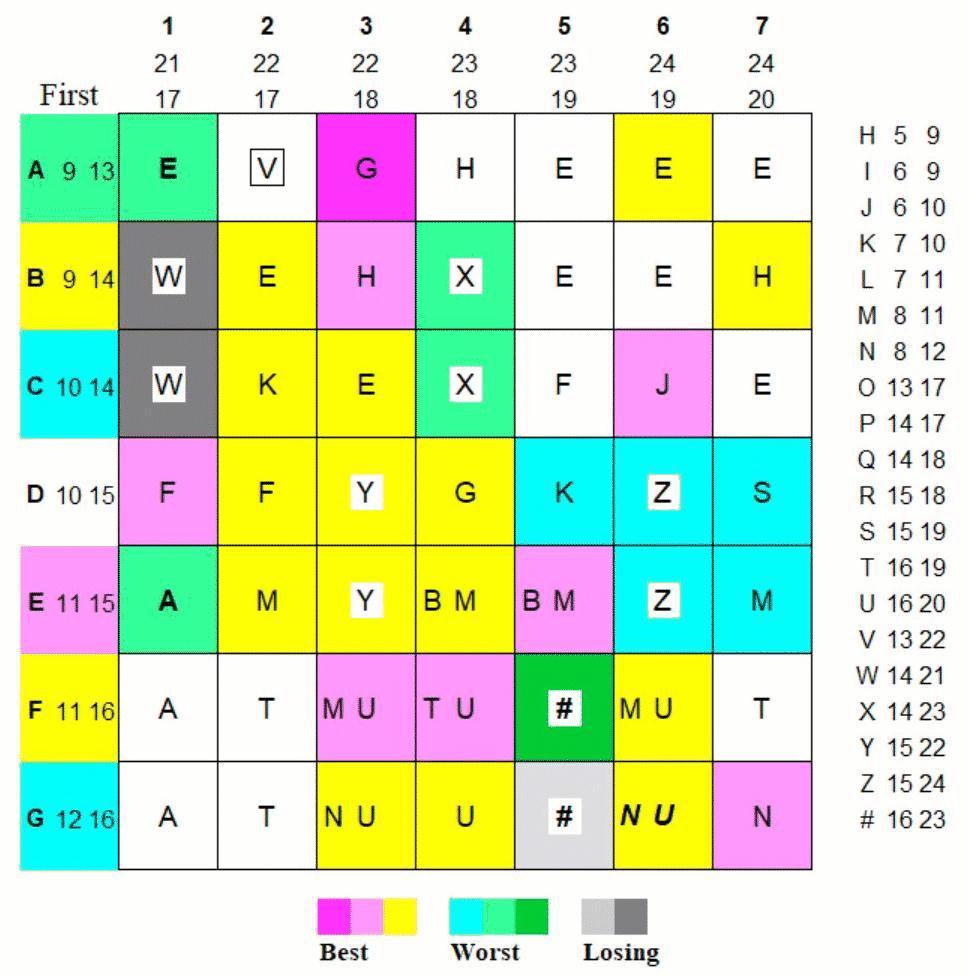
Strength of the Three-Move Ballots
The chart below shows the approximate relative strength of the 156
three-move ballots. Red and orange openings
are strongest for Black; Green are strongest for White, along the spectrum (unshaded ballots are balanced).
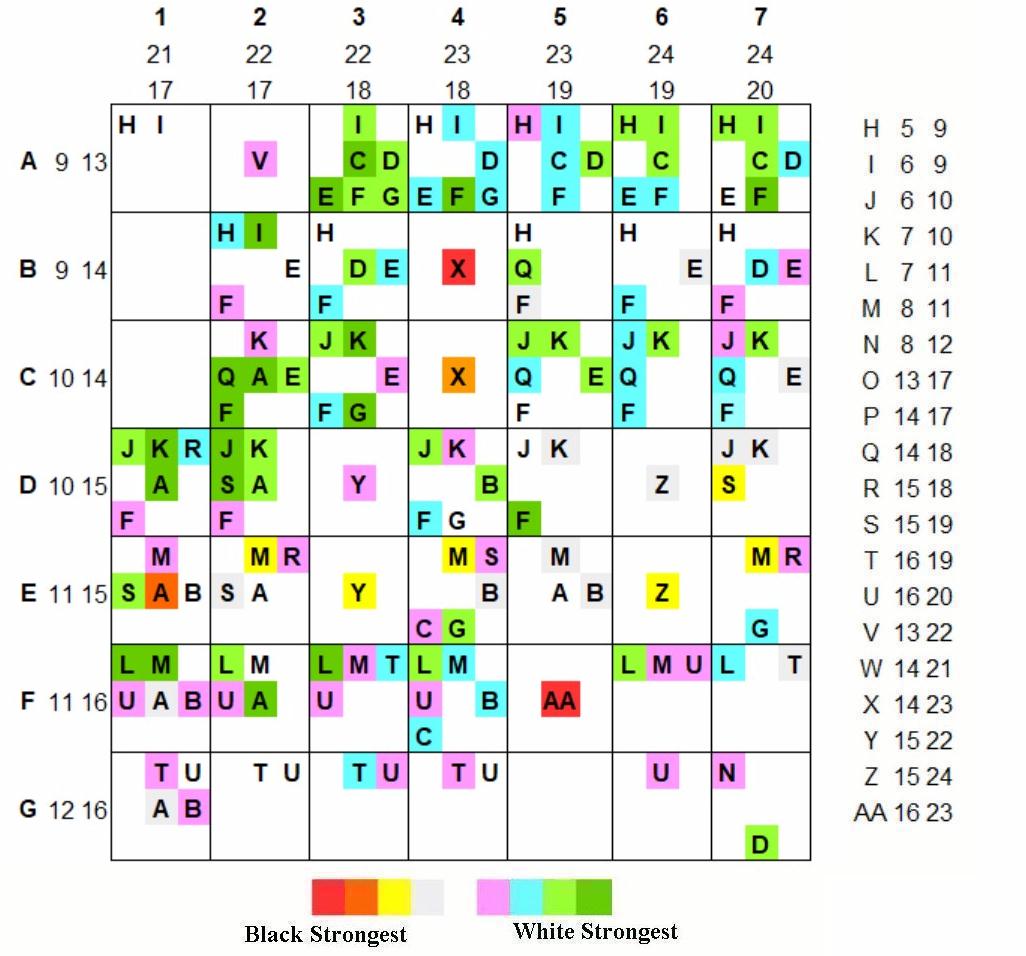
The Best Fourth Moves
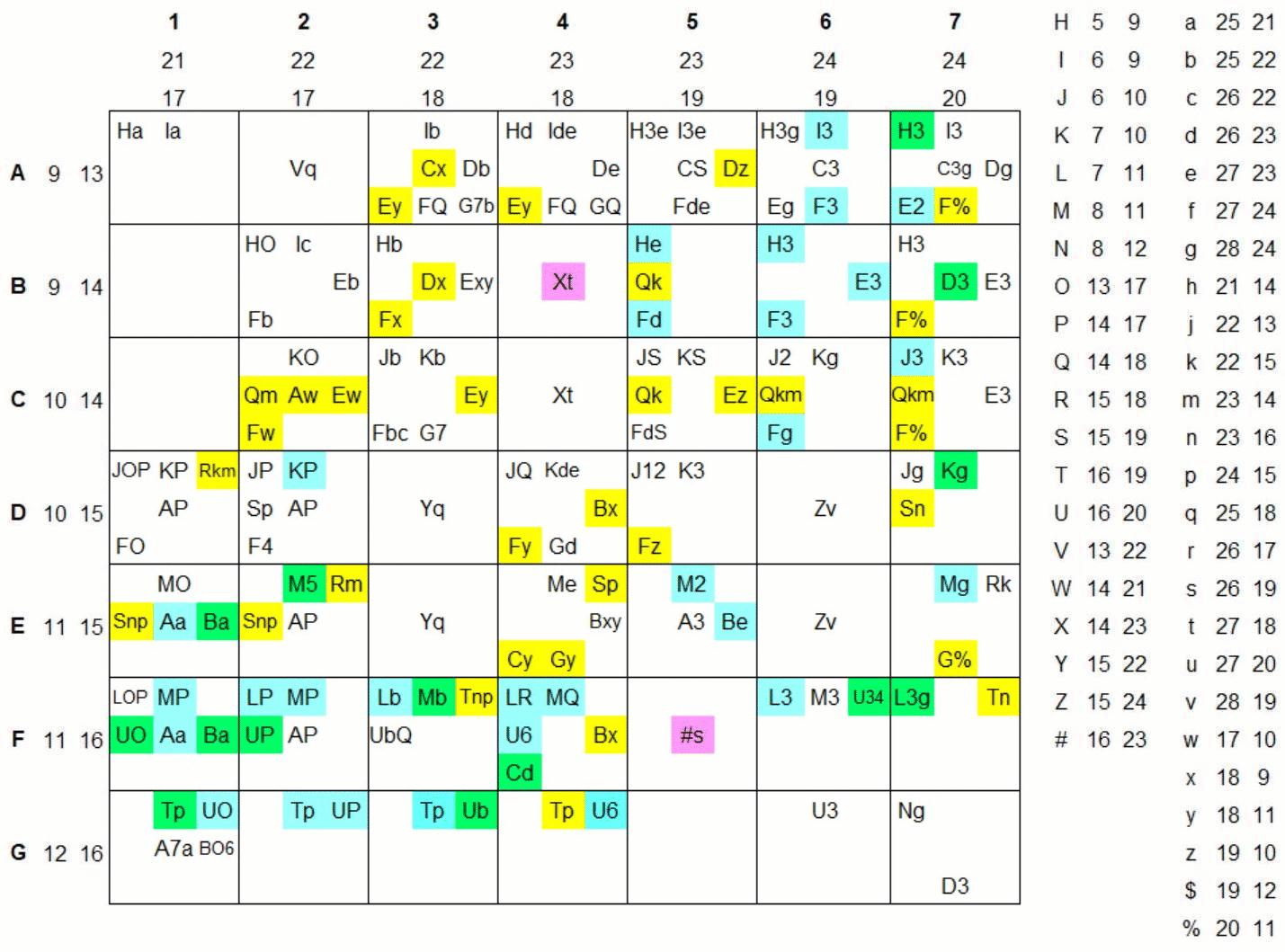
This is an experiment, partly to see how much
information can be packed into one chart, partly for my own education, and partly to see how often
different sources agree. I have marked the consensus best move(s) for each of the 156
three-move ballots. Codes for additional possible White second moves are
given in the chart on the right: capital letters for the 4th move indicate the reverse
of a Black move (A3FQ indicates the reply 18-14). Replies
marked in green transpose to other ballots (see Pask for
details). Replies in yellow are forced (multiple options indicate double X exchanges). Replies in pink are star moves, in this case the
only move for White to draw (there are only two of these: B4 and F5). For a
number of ballots, there is a clear consensus among the human
sources: I have used that even where Kingsrow prefers a different
move (light blue). In some cases two moves are given
when there is a split opinion (sometimes there is a choice between a transposition and an
independent line). Again, all errors are mine.
Appendix 2: Historical Notes on Some Individual Openings
These are listed in numerical order, from 9-13 to 12-16,
except for a few openings which are grouped together. Green
highlighted moves in the text yield the diagrammed positions in each
opening (some characteristic moves are highlighted in pink). References to Kear, Fortman, and Pask are for Kear's The Encyclopaedia of Draughts, Fortman's Basic Checkers, and Pask's Complete Checkers: Repertoire, unless otherwise specified.
Edinburgh Openings
The Dreaded Edinburgh
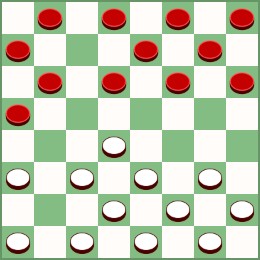
To some degree, the entire 9-13 22-18 opening is dreaded for Black:
it's the best White response to the worst Black opening, and there
aren't any pleasant second moves for Black (12-16 is the least
unpleasant of the six playable ballots, followed by 10-15). But
the name Dreaded Edinburgh has become attached to the specific three-move ballot 9-13 22-18 6-9 (diagram above; ACF ballot 4, or A3I): about as good as 11-16, and better than 10-14 and 11-15.
25-22 is regarded as the strongest response (diagram above): Alex
Battersby, in the book of the 1910 Fifth International Match, says:
"18-14 again throws away any advantage White has in the
opening". 25-22 allows only two tenable Black
replies.
The older move is 11-15 18x11 8x15*, which leaves White two moves which
keep the advantage: 24-20 or 23-18 (Pask does not cover 11-15 at
all, and Ryan only mentions it, but see Fortman for detailed analysis).
In the 24-20 line, known as the J. Kirk attack, Fortman has note
K at the end of his trunk (pp. 20-21), mentioning unpublished analysis
by Bob Flood on 3-7 as an alternate to 13-17 which had been considered
a star move. Flood's defense appeared in Midwest Checkers (vol. 1, num. 5, pp. 45-46) and is sound: much of it can be found in Kingsrow's opening book.
The other possibility is 1-6, possibly introduced by R.T. Ward
in the 1910 Scotland vs. England match (Kear). This has the
difficulty that White has many attacks (Fortman: "all requiring detailed
knowledge"): the most often played is 30-25, best met by
11-15. Ryan concentrates on this line, while Pask mainly covers 24-19, also followed by 11-15. Arza B. Fogle suggested 30-25 9-14 instead of 30-25 11-15 as the Fogle defense in Midwest Checkers
(1979, vol. 1, num. 1, p. 5), but gave up after Bobby Martin showed an
apparent win in vol. 1, num. 4, p. 40. However, there is a
saving move all the analysts missed (11-15 instead of 11-16 on Black's
8th), and the Fogle defense is sound.
The superiority of 25-22 is is not a universal view: 18-14 is often played, and Ryan analyzes both in the 2nd edition of The Modern Encyclopedia of Checkers, as does Fortman in Basic Checkers. It is followed by a forced double X exchange, after which 12-16 is probably best for Black, although 11-15 and 1-6 both draw.) A third playable alternative is 26-22, transposing to 9-13 23-18; 6-9 26-23 (A4Id).
The Inferno
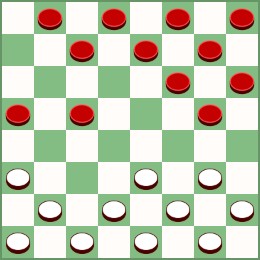
In the 1930's, analyst John T. Bradford showed play on the opening 9-13
22-18 10-14 (followed by the forced captures 18x9 5x14) to Louis
Ginsberg and A.J. Heffner, who were on the committee drawing up the
initial list of playable three-move ballots. Bradford's play
seemed to show a White win, and the opening was removed from the
initial list of candidates under consideration (for which Bradford felt
responsible). He later collaborated with John T. Denvir to
show drawing lines in both Denvir's Guide (1934) and Denvir's Three Move Guide (1936), but some of the analysis was faulty, and it took
two-thirds of a century for the ballot to finally be reinstated, under the name The Inferno (ACF ballot 4A, or A3C).
It is rated as one of the hardest Black three-move ballots,
and the trunk was still evolving even as it was on the verge of
acceptance in the late 1990's. The best attack for White
seems to be 9-13 22-18; 10-14 18x9; 5x14 26-22 (diagram above), after which various
lines have been tried. Cayton's 1997 Compilation
recommended 7-10, but later analysis showed a loss after 22-17*; 13x22
25x9; 6x13 29-25 (even Chinook missed the winning line). It turns
out that 6-9* is the only drawing move, originally recommended in the
1934 Guide, but in the 1936 Three Move Guide they switched to 1-5, which turns out to lose to 24-19*. Another solid move on White's third is 25-22: only 11-15* draws. (See Pask's Complete Checkers: Repertoire
for more detailed analysis of the various lines). The
apparently similar opening 9-13 23-18 10-14 18x9 5x14, was unofficially named
Inferno 2, but proved untenable, failing against three different
attacks: 22-17, 24-19, and 27-23.
The Henderson
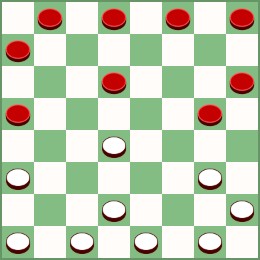
Widely considered the second best reply to the Edinburgh 22-18 opening, 9-13 22-18 10-15 is named after Hugh Henderson,
a noted analyst who developed a lot of the play on the opening (Kear,
on p. 410, credits a line in note V to "H. Henderson, whose many
studies have elucidated this line".) Henderson was also a strong player, originally from Scotland, who won the Second and Third American Tourneys in 1912 and 1915, edited the checkers column in the Pittsburgh Leader, and has a shot (see Ryan's Tricks, Traps, and Shots) and an endgame (Henderson's Draw) named after him. One common option for White is to play 18-14, transposing into the trunk of opening 69: 10-15
22-17 9-13 17-14. But the trunk
of the Henderson proper, dating back to the 19th century, is 25-22;
6-10 23-19; 11-16 18x11; 16x23 27x18; 8x15 18x11; 7x16 22-18 (diagram
above). This is a solid line which is still recommended today
(see Pask): Open Checker Archive has 65 games played with this variation.
At this point 4-8 is the dominant move, and almost a star move: the
rarely played 3-7 is possibly the only other drawing move.
In the go-as-you-please days, 5-9 was sometimes played instead of 6-10
(Lees called 5-9: "a favorite line with some players, but it leads to a weak
endgame"), but was mostly abandoned because of the reply 29-25 (Kear:
"After this, only the sport of being chased."), and there is little
published play. Kingsrow rates this as an extremely hard
draw: all of Black's options after 25-29 probably lose except 6-10* (11-16 is
unclear): then after 18-14 and the double exchange 9x18 23x14; 10x17 21x14, Shearer's Modern Draughts Handbook plays 15-18 here, which probably loses. John
B. Stiles revived this line twice in the 1934 Nationals, playing the
correct 11-16 instead of 15-18, and eventually getting a win and a
loss. The Henderson is considered a hard ballot for Black, but
much less so than several of the other Edinburgh ballots.
The Edinburgh Single
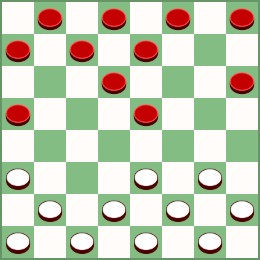
This early exchange in the Edinburgh opening (9-13 22-18 11-15 18x11)
is one of the most difficult three-move openings: H. F. Shearer
believed it to be a loss for Black (Studies of the Two-Move Openings,
pp. 67-68), and it was still in doubt in 1926 (Morris-Systems Checkerist, Vol. 4, Num. 3, p.60). Later analysis found that Black could draw, and
it was one of the 137 three move ballots in 1934 (ACF number
6, or A3E). The trunk line is 9-13 22-18 11-15
18x11 8x15* (diagram above) [7x16 loses to 25-22 (see Fortman)]. Ryan analyzes this opening in detail in the 2nd edition Modern Encyclopedia of Checkers. Richard Pask and Jerry Childers rate this as the hardest ballot for Black; Brian Hinkle puts it second only to the Black Hole. The official ACF rankings have it about equal with the Inferno
(9-13 22-18 10-14 18x9 5x14) as Black's hardest. [Technically,
the compound name should refer to the two-move opening 9-13 22-18, but
it has become associated with this particular three-move opening.] Some older publications (e.g. The Draughts Review:
see Volume 3, Number 8, April 1932, p. 59) call the 8x15 line the
Liverpool opening, but Frank Dunne used Liverpool to refer to a related
opening, the 8x15 capture in the Twilight Zone.
The Wilderness Openings
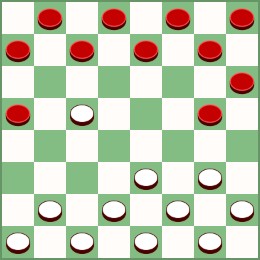
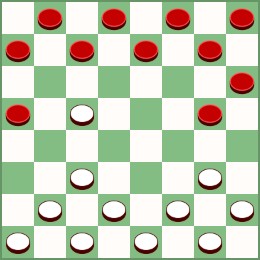
Three closely related openings, which share the same two opening moves
for Black, were long thought to be losses for Black. The first two are now known as Wilderness 1 (9-13 22-18 11-16, A3F) and Wilderness 2 (9-13 23-18 11-16, A4F); the third is the Wilderness Companion (11-16 22-17 9-13, F2A; called Oldbury's Offering in Pask's The Golden Dozen). Frank Wendemuth analyzed Wilderness 1 in his 1922 Checker Companion, believing it to be a loss (Kear says "A draw after this is doubtful"). Denvir's 1936 Three Move Guide to Checkers,
however, gives play by A.M. Peteck (pp. 79-80) suggesting that Black
can draw. Marion Tinsley thought Wilderness 2 to be a loss
for Black (Pask's The Golden Dozen, p.50), but a defense involving many star moves was found. The best attack in the first two is 18-14 10x17 21x14,
leading to similar very strong positions for White (diagrams above). The corresponding
attack in the Wilderness Companion (17-14 10x17 21x14) transposes
directly to the same position in Wilderness 1 (above left).
[Other White second moves transpose to easier lines for
Black.] In Wilderness 2, 6-9* is the only move to draw; in Wilderness 1 6-9 is best, but 16-20 also draws (see analysis
in Pask's The Golden Dozen or Repertoire). [6-9* 22-18
in Wilderness 2 transposes to 6-9 23-18 in Wilderness 1.] All three were among the 12 ballots added in 2003 by the ACF to
three-move restriction (as 6A, 11A, and 111A respectively); analysts Brian Hinkle and George Miller rate all three among the 10 hardest ballots for Black. The trunk line of Wilderness 1 (or Companion) is also a common opening in Brazilian draughts (IDF 10 XXVII), where it is known as the Australian opening (see the bilingual Portuguese/English book by Alexander Louriero); of course the analysis diverges because of backwards captures: 16-20 is the dominant fourth move for Black.
The Garter Snake and various Rattlesnakes
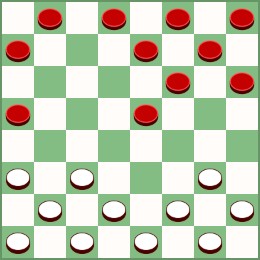
The opening 9-13 23-19 10-15 19x10 (A5D) was named the Garter Snake
by Richard Fortman (see the booklet of the 2002 Inter-District Mail
Tourney), for its similarity to the barred Rattlesnake. It
was one of the 36 three-move ballots originally rejected when the first
American Restriction of 150 ballots was approved in 1931.
After years of analysis, it was approved for mail play in 1989,
and added as part of the last set of ballots (ACF 15A) in
2003. Despite taking decades to find it tenable, it is not
even rated among the 40 hardest ballots. In The Golden Dozen,
Pask says: "...with correct play, Black appears to be presented with
few real endgame problems." After 19x10, Black has a
choice of captures, but 6x15 (diagram above) is much stronger (7x14 was
shown by Kingsrow to be a difficult draw). White's two strongest attacks after 6x15 are 22-18 and 26-23 (which is the same as a milder branch of the Black Hole). Other than Pask, there isn't any analysis in the major reference works.
The Rattlesnake, 9-14 23-19
10-15 19x10 6x15, despite its similarity to its Edinburgh cousin,
remains barred; the White move 22-18* is followed by a two-for-two
exchange 15x22 (or 14x23) 26x10 7x14, and 27-23* wins against all Black
defenses. It was approved for mail play, but no draw for
Black was found. There is also a Denny opening called Rattlesnake 2, 10-14 24-19 11-15 19x10 6x15, which fails against the attack 22x17* (22-18 here would allow a draw). [Both of these Rattlesnakes would allow a double capture 19x17 in American Pool after 6x15.] The opening 9-14 24-19 10-15 reaches the exact same position as
the Rattlesnake after the same sequence of moves, but ending in 27-24 (25-22 would also win).
All three of these openings were also rejected in 1931, and remain
barred. Details of attempts to find draws in these openings can
be found in Dennis C. Cayton's Compilation of the Barred Openings.
The New Edinburgh
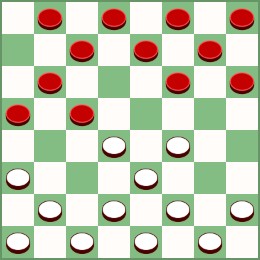
Another of the 12 three-move openings barred after 1931, 9-13 24-19
10-14 does not seem to have an official name. It was little
played before three-move days, but Shearer's Modern Draughts Handbook
gives two games (both drawn) between J. Archer and J. Ferguson in a
correspondence tournament which ran from 1907-1911. Eugene Frazier called it
The New Edinborough in an analysis in Master Checkers
(Volume 1, Number 3, September 1973, p. 8), and Fortman spelled it New
Edinboro in Midwest Checkers (Volume 1, Number 1, p.8) so it is
reasonable to call it (using the standard spelling) the New Edinburgh. It had been approved for mail play as early as 1968, but was not officially added until 1994 (along with the Virginia,
the last two additions before the Golden Dozen). It is ACF ballot
18A (A6C); Fortman describes it as "unjustly barred for almost 40
years". The White attack 22-18 was at one time thought
sufficient to win, but Black can reply 5-9 with a playable position
(diagram above). White's best is 25-22 (then only 6-10* maintains
a draw), with several good attacks available (see Fortman and
Pask). Instead of 5-9, 6-10 transposes to a line of the
Inferno (see Game 20 in Denvir's Guide to Checkers, pp. 92-93) or Nemesis (from an 1894 Ferrie-Wyllie game) and a difficult
draw; 7-10 probably loses after 18x9; 5x14 25-22*; 3-7 27-24*
(Kingsrow's move correcting a PP draw with 29-25); 11-15 24-20*. Analysts rate the New Edinburgh about as difficult as the Henderson.
The Twilight Zone
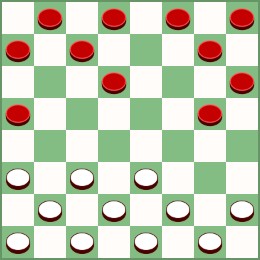
Another of the Edinburgh ballots added in the Golden Dozen (ACF 25A), 9-13 24-20 11-16 was analyzed and named Twilight Zone by Dennis Cayton. (Originally the transposition 11-16 24-20 9-13 was used as the ballot). In Cayton's Compilation, after the forced capture 20x11, only the natural 8x15 capture toward the center was analyzed. Richard Pask, in The Golden Dozen,
recommended the 7x16 capture, which he says "has significantly eased
Black's defensive task" (diagram above). [As noted above, 7x16 loses in the related Edinburgh Single opening.]
Black must follow 7x16 with 16-19* against any of White's three
strongest attacks (22-18, 28-24, or 27-24). Both captures
are playable, but it is still among the
most difficult ballots for Black. Frank Dunne, in his
Guide and Companion, gave the name Liverpool to the 8x15 line (in the original move order 11-16 24-20 9-13 20x11 8x15). The IDF ballot
21 V also uses the older transposition, with a second ballot 22 V continuing
20x11 8x15 23-18 (one of White's strongest responses, along with 22-17).
Double Corner Openings
The Bronx Express
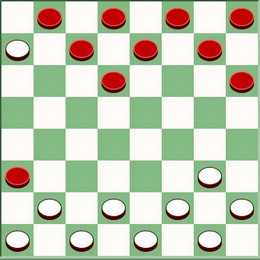
This reply to the Double Corner opening (9-14 22-18 5-9 18-15) was named and analyzed by Willie Ryan in his 1938 booklet Streamlined Checkers. Ryan claims White has an even game and "the greater number of winning chances". The
capture 11x18 is strongest for Black: White should follow with 21-17*, regaining the piece after 14x21 23x5 (diagram above). I can't find any
published play on the alternate capture 10x19 (IDF ballot 1 XXV in Brazilian), which gives a somewhat similar position after
24x15; 11x18 21-17; 14x21 23x5 (Black has only a slight edge according to Kingsrow). Most opening guides omit 18-15, or only mention it in passing. Tescheleit's 1927 Master Play Part 2 has some analysis of 21-17 (var. 29, p.127) on
White's second move, which transposes after 14x21 18-15; 11x18 23x5; he
calls it "Very weak; weakest of the 2's for 2, an unexplored
4-move." Kear's Encyclopaedia
gives one variation on p.355 (var. 64), but says: "A.B. Scott thinks it
quite good. It has been little explored." Modern analysis holds it as "hazardous" (Fortman and Pask) for White, but
definitely drawable.
The Double Cross
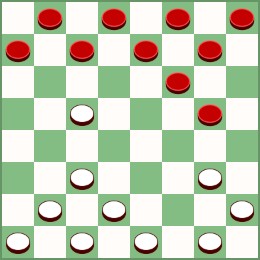
In the early days of two-move restriction, 9-14 23-18 was one of the
six barred openings, but was later added when viable defenses were
found; it was played eight times in the 1924 Sixth American Tourney. Double Cross
is one of the compound names still in use (9-14 Double Corner, 23-18
Cross reply). By the time of three-move restriction, it was
well
established, and 9-14 23-18 14x23 was one of the initial 150 (and later
137) ballots (ACF ballot 34, or B4X; IDF 14-17 XXIII in Brazilian draughts). It is still widely considered to be the most difficult three-move ballot for either side.
After 9-14 23-18; 14x23, White has a choice of captures, 27x18 or 26x19. In Scientific Checkers,
Banks analyzes only 27x18, but in a footnote says "26-19 opens up some
beautiful play". Later analysis established, however, that
26x19 loses to 11-16. After 27x18, Black's strongest move is
probably 12-16, requiring two star moves by White: 12-16 18-14*; 10x17
21x14* (diagram above). On Black's third move, 5-9 is
also strong: at one time 26-23 was thought necessary to hold a draw,
but Ed Gilbert found a very difficult draw with Kingsrow after 5-9 24-20 (the status of 5-9 21-17 is unclear).
Denny Openings
The Dubious Denny
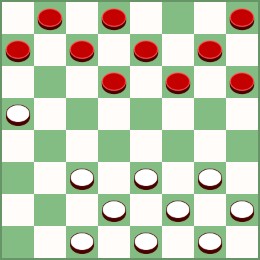
In the late 19th century, 22-17 was considered the strongest reply to 10-14, and the trunk
10-14 22-17; 7-10 17-13; 3-7 25-22; 14-17 21x14 9x25 29x22 (diagram
above) dates back at least to Kear's 1895 revision of Sturges. It can also
be found in the earliest edition of Lees I have seen, the improved 9th
edition (by J. Richards) in 1907, and all the way to modern works by
Fortman and Pask. (The alternate capture 10x17 instead of
9x25 loses for Black and isn't even mentioned in opening
guides). At this point, older guides give 10-14 as the
trunk, but modern play recommends 11-15. There is a sound
alternate line with 24-20 instead of 25-22, given as trunk by
Kear's Encyclopaedia, Tescheleit and Miller among others, and preferred by Kingsrow.
As a three move ballot, 10-14 22-17 7-10 (ACF ballot 45, or C2K) was analyzed and named the Dubious Denny
by Walter Hellman. A major alternate line is 11-15 instead of
3-7, recommended by Derek Oldbury, which can transpose into a variation
of the Souter better for Black after 23-19 2-7, but the stronger reply
25-22 makes 8-11* necessary. Kear's Encyclopaedia gives 24-20 2-7 (variation 60, p.
274), which is probably Black's strongest reply. Fortman
incorrectly labels 4-8 instead of 2-7 as a loss, attempting to correct
Tescheleit (variation 21P, p. 174), but makes a losing capture [4-8
20-16; 12x19 23x7; 2x11 29-25; 3-7 27-24; 15-19 24x15; 11x18? 22x15
10x19 31-27* wins, but the correct capture is 10x19
first.] Carl Reno gives 4-8 as the trunk and analyzes
it in some detail in The Work of the Pentium,
showing it to be a playable line. Kingsrow recommends (in the
Oldbury 11-15 line) that White
bypass the entire 24-20 line, with a sequence that does not seem to
appear in published play: 8-11 24-19; 15x24 27x20 (28x19 has been
played, transposing to other lines of the Denny). 10-15* is
then necessary, and after 22-18; 15x22 26x10; 6x15 13x6; 2x9 (1x10
probably loses), White has a better position than the other main lines
(Kingsrow is still in its opening book at this point, and has more analysis).
The Black Hole
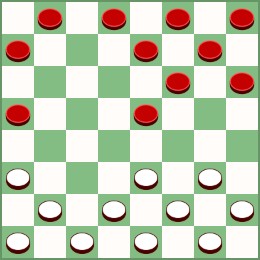
Another of the most difficult three-move ballots for Black, 10-14
22-17 9-13 (ACF 45A) was named The Black Hole
because of the three empty squares in Black's position after the
captures 17x10 and 6x15* (diagram above). [It became the third
opening to share a name with a common card solitaire, after Will O' The
Wisp and Bristol.] The alternate capture 7x14 is known to
lose to 25-22 (24-20 also probably wins). Like The Inferno, the trunk was changing as it was being proposed for
adoption. After White's third move 25-22, Cayton's Compilation
recommended 5-9, but eventually that was found to lose. A defense
found by Chinook, 15-19*, was found to be the only viable move: several
star moves in a row from Kingsrow's opening book rescue a line previously
given as a loss: 15-19*
24x15; 11x25
29x22; 8-11 22-18; 1-6 28-24; 6-10* 24-19; 11-16* 26-22;
4-8*. If White plays 26-22 instead of 25-22 on the third move, it transposes
into one of the two main variations of the less dangerous Garter Snake. The Black Hole was the last
three-move ballot
to be approved: a chart by Brian Hinkle
which dates from the early 2000's lists every opening in order: 10-14
22-17 9-13 (60th of 174) was among 19 openings still believed to be
losses at the time.
Tinsley's Denny (The Denny Dodger)
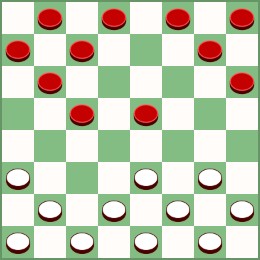
The opening 10-14 22-17 11-15 17x10 7x14 (diagram above) does not seem
to have been recorded before the three-move era: the earliest games in
the Open Checkers Archive are from the 1989 Inter-District Mail Tourney
(mostly under the transposition 11-15 22-17 10-14).
It was one of the 12 ballots initially approved in 1931, but dropped
before 1934. It was one of eight openings suggested in 1952
by Marion Tinsley as potentially drawable (see Diabolical Denny below), and Pask calls it Tinsley's Denny in The Golden Dozen. Its official ACF name is the Denny Dodger (ballot 45B), but as there is another well-known opening called the Dodger, naming it after Tinsley seems preferable. Analysis can be found in Pask (either The Golden Dozen or Repertoire);
it seems to be one of the least often discussed of the Golden
Dozen. It's only a mildly difficult ballot for Black,
barely cracking the top 50. After the exchange, several
attacks have been tried: 23-18 triggers a double exchange; 26-22 is
recommended in The 1st 20 Best Moves;
Pask recommends the exchange with 24-19. It's one of only
two tenable ballots in Anglo-American checkers which fails in American
Pool (to the double capture 17x19).
Gemini 1 and 2

Two closely related openings are named Gemini 1 (10-14 22-17 11-16 17x10) and Gemini 2
(10-15 23-19 11-16 19x10). Oddly, the 1931 committee failed to see the similarity between the two: Gemini 1 was rejected when the
150 American Restriction ballots were approved, while Gemini 2 was
initially selected, but was among the 12 ballots dropped to reduce to
138. After decades of analysis and mail play, both ballots were approved in 2003 as part of the Golden Dozen: Gemini
1 (ACF 45C; C2F) and Gemini 2 (ACF 79A; D5F). Both are rated as
very hard ballots, but not among the very hardest (Brian Hinkle rates
them about the same as the Dreaded Edinburgh).
In both openings, Black can capture 6x15 or 7x14, but analysis
showed that 7x14 loses in both cases: 7x14 25-22 is best in Gemini 1,
although other moves also win for White; 7x14 22-17* wins in Gemini
2. After
6x15*, White's best in Gemini 1 is 23-18; this gives the same position
in Gemini 2 if White plays 22-18 (also recommended), followed in both
by the forced capture 15x22 (diagram above). White
should capture 25x18 to maintain an advantage (26x17 leads to an even
position); Black should reply 7-10 or 1-6 (16-20 is a difficult draw, and other moves lose). There
are alternate lines where the openings diverge (and sometimes converge
again!), but these are less advantageous for White (see Pask's The Golden Dozen, and Cayton's Compilation).
The Heebie-Jeebies
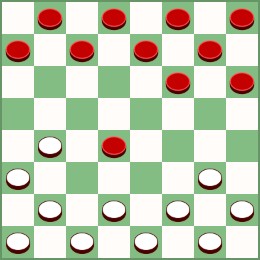
An opening with a long history, played in the Martins-Wyllie match in
1867, is 10-14 22-17 14-18 23x14 9x18 (diagram above). Despite
being quite a difficult ballot for Black, the move 14-18 has a good
reputation. Lees' Guide (p. 45) says "Quite as good as 7-10, and
admits of a great variety of play." Shearer's The Modern
Draughts Handbook (p. 194) says: "may prove the most satisfactory
defence." In go-as-you-please or two-move, 10-15 22-17
15-18 also transposes. Although it has no official name, Derek Oldbury named it the Heebie-Jeebies, a pun on the moves in his oddball notation from Move Over (see Pask's Insights, p. 83). There is an interesting account in One Jump Ahead
(p. 153-156) of two games played by Chinook vs. James Morrison (White
won both games). Since it was well-established in
go-as-you-please days, it was one of the original three-move ballots
(ACF number 46, C2Q), and is covered in all the comprehensive
three-move guides. In addition to the standard sources, there are long analyses in Ryan's 2nd edition Modern Encyclopedia of Checkers (pp. 106-122) and Fraser's The Inferno of Checkers (pp. 116-127, with new analysis by Arza B. Fogle, and an Addendum on pp. 211-212 by Walter Hellman). The strongest attacks for White are 26-23 (against which only 6-9* draws) and 17-13 (5-9 best; 11-16 probably draws also).
Fraser's Inferno
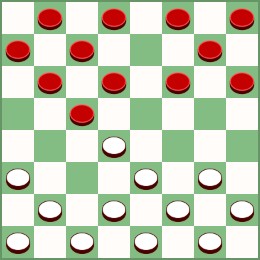
Another of the 12 ballots removed after 1931 but suggested by Tinsley in 1952 for reinstatement (see Diabolical Denny),
10-14 22-18 7-10 (diagram above) was played in the go-as-you-please era, but seemed to
wane in the two-move era, and is barely mentioned in early published
play. Canadian master W.R. Fraser tried it twice,
unsuccessfully, against Tom Wiswell in their 1960 Go-As-You-Please World Championship match, and named it Fraser's Inferno (it does not appear in his book The Inferno of Checkers,
which had already been published). Wiswell played a forcing line which
is perhaps White's strongest attack: 25-22; 11-16* 29-25; 8-11* 18-15;
11x18* 22x15; 10x19 24x15 (see Pask, and p. 146 of
Fortman). The opening was adopted as an ACF ballot (47A,
C3K) in 1970. As far as I know there is no connection with
the Edinburgh Inferno.
The White Doctor
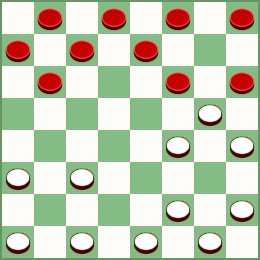
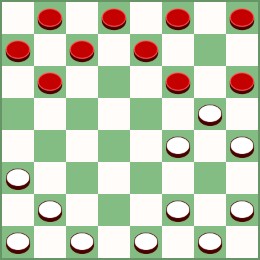
As originally defined, the White Doctor is: 11-16 22-18; 10-14 25-22; 8-11 24-20; 16-19* 23x16; 14x23* 26x19
(diagram above left). The arrowhead of pieces at 16/19/20
resembles the similar formation at 13/14/17 in the Black Doctor. This appears in games 45 and 46 in Payne
[with White moving first; the analysis here reverses the colors in
Payne's examples]. This gambit has drawn the attention of analysts since its
introduction, and appears in the major go-as-you-please guides. Call's Vocabulary cites a move called King's Invention, a winning move played by J. King against James Wyllie (seen in variation 11 in Lees' Guide).
But the line in which this move was played was already a winning
position for White at least seven moves earlier: in fact this was game
45 in Payne, who did not realize that 4-8 in the position above left
loses for Black,
and after 31-26 6-10 27-23 Black should be getting crushed. But
White plays 21-17 instead of the correct 23-18* (as in Lees) and lets
Black off with a draw. (In game 46 White plays 22-17 instead of 27-23,
resulting in another drawn position). The first detailed analysis was by Matthew Atkinson in his 1892 pamphlet The White and Coloured Doctors,
showing that Black could draw. His analysis of the 6-10 31-26 line is still sound; a Tinsley-Long game in 1981 (Pask's Repertoire) follows his analysis (the trunk in Lees) to the end. Eventually 6-10* was shown necessary to draw from the position above left. What Atkinson names the Coloured
Doctor is a variation from the Double
Corner: 9-14 22-18; 5-9 25-22; 11-16 24-20; 16-19 23x16; 14x23 26x19;
8-11: in this branch the sacrifice 16-19 is not necessary for Black to
draw (and 24-20 isn't even White's best third move).
The White Doctor is a notoriously difficult opening: we list it here among the Denny openings because it develops most
naturally from the formerly barred three-move ballot 10-14 22-18 12-16 (ACF 49A, C3G), rated among the hardest for Black. White's powerful reply 24-20 forces Black to sacrifice a piece with the star move 16-19*, followed by a series of exchanges: 23x16; 14x23 26x19; and another star move 8-12*
(diagram above right; 25-22 would then produce the same position as above left). The White Doctor can also occur from the similar ballot 10-14 22-18
11-16, after 25-22 8-11 24-20 (see Wiswell and Shuffett's America's Best Checkers,
p. 122, game 87), 10-14 22-18 6-10 (see Fortman), or the Millbury
(11-16 22-18; 10-14 25-22; 8-11 24-20). [In the original
move order from 11-16 22-18 10-14 (or from ballot 49), the strongest
play bypasses the White Doctor entirely: 26-22 may be better than
25-22, and if White does play 25-22, Black should prevent the White
Doctor by playing 16-20.] The traditional version of the White Doctor (and some of the transpositions) have an early 25-22 move
by White, but modern analysis of 49A suggests holding off 25-22 until
later. This was once thought to produce a winning line for White
(see Fortman), leading to the opening being barred until
1970. A contemporary analysis is in endgame expert Ben Boland's only book on opening
theory, White and Black Doctors.
In the 1992 Man-Machine match against Marion Tinsley, Chinook was
playing White in the White Doctor opening, and lost after it tried a
new move on White's 10th move. In 2005, a stronger version
of Chinook was able to prove that the 10-14 22-18 12-16 opening was a draw
with best play, the first step in its plan to prove that the opening
position in checkers is a draw in go-as-you-please. Ed
Trice wrote The Notorious White Doctor Opening, for the first issue of Draughts Razoo (Summer/Autumn 2003, pp. 6-7), describing the process by which computers analyze difficult positions.
The Denny Exchange
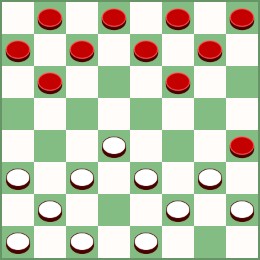
Another formerly barred two-move opening, 10-14 23-18 14x23
(ACF ballot 50, or C4X) was eventually found to be the easiest of the
six for White. The trunk is 10-14 23-18; 14x23 27x18; 12-16
32-27; 16-20 26-23
(diagram above), recommended in the three standard references (Kear,
Fortman, and Pask), and
played in 13 of the 14 games in the 1924 Sixth American Tourney
(scoring an even 2-2-9). The rarely played alternate
capture 26x19 makes a much harder draw for White (Shearer, Tescheleit,
Kear, and Fortman
analyze several lines).
The Diabolical Denny
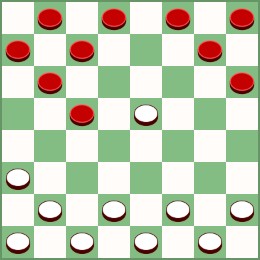
Played occasionally in the go-as-you-please and two-move eras, 10-14 23-19 7-10 has more than 80 games in the Open Checker Archive, and its companion opening 10-14 23-19 6-10 more than 50. Both date back to the late 19th century, though there is little published play from that era. 6-10 has a couple of lines of analysis in Kear (var. 50, p. 303), and one game in Wood's Checker Studies 7 (p.43, Game 9). Both openings were included in the 150 three-move ballots in 1931 (though the latter was listed under a little-played transposition 9-14 23-19 6-9), but were dropped in the reduction to 138 ballots. In Elam's Checker Board
(v6 n4, April 1952, p. 1825), Marion Tinsley suggested that both
openings (along with six others) had the potential to be drawn, though
he offered no analysis beyond suggesting that White's best attack in both was 19-15.
The variation 10-14 23-19 7-10 19-15, was named the Wolfville in
GAYP days by William Forsyth of Nova Scotia, in honor of players in
that town; it is followed by a double X exchange (diagram
above). In the companion opening 10-14 23-19 6-10, 19-15
gives Black a choice of captures. Eventually tenable
defenses were found for Black: the trunk lines are 10-14 23-19; 6-10
19x15; 10x19 24x15; 11x18 22x15; 7-11 (the Hellman Defense) and 10-14
23-19; 7-10 19x15; 10x19 24x15; 11x18 22x15; 3-7 (developed by Karl
Albrecht; 8-11 is common also). See Fortman and Pask for details
and other lines. In the 7-10 opening, Kingsrow prefers a move
which does not seem to have been played: 2-7 instead of 3-7. They were two of the five openings added to the official ACF ballots in 1970 (6-10 as 50-A, and 7-10 as 50-B), and 7-10 was named the Diabolical Denny. 6-10 sadly does not seem to have a name.
The Virginia
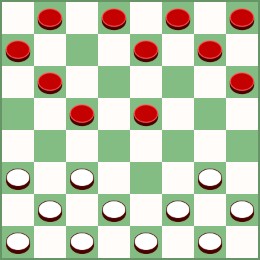
In the 1874 Recreationist, the opening 11-15 23-19 10-14 19x10 6x15 (diagram above) was named the Virginia.
Janvier includes the name in his 1881 revision of Sturges (not
Anderson, as cited in Call and Fortman) and Dunne in his 1890 Guide and Companion,
but neither gives an example. Fortman and Pask say it was played
occasionally in go-as-you-please, but I can only find a few lines,
credited to C.H. Irving (with the modern move order 10-14 23-19 11-15)
in Janvier's 1881 revision of Anderson. As 10-14 23-19 11-15 (C5E), it was one of the 12 openings originally included in the 150
American Restriction openings in 1931, but removed when the list was
reduced to 138 before the 1934 National Tourney. It isn't found in most older sources, but Tescheleit gives some analysis on p. 206 of Master Play.
It was on the path to being approved when Fortman was writing Basic Checkers,
and he includes analysis under its official designation as
50-C. Fortman thought it might be approved for the 1982
National Tourney (it had already been approved for mail play, and appeared in several Inter-District Mail Tournaments),
but according to the sources I checked, it was officially approved in
1994 (and the name Virginia retained) along with 9-13 24-19 10-14, when
the number of ballots increased to 144. After the forced
captures, White has many viable attacks: the most common and perhaps
strongest is 22-18 (see Pask's comments on p. 56 of Insights),
giving a choice of captures on both sides (this line is nowadays called the Grand Canyon Attack, for the gaping hole it leaves in both players' positions (it can also occur from the Gemini 1 opening: see Cayton's Compilation). All five resulting
positions are playable, but 26x10 after either Black capture lets White
keep the advantage; Black might as well play 14x23, hoping
for 27x11 8x15. Tescheleit recommended 22-17 14-18* 17-14,
as did Oldbury in Move Over (see Pask and White's Supplement), while Fortman gives 26-23 as the trunk. Despite
being banned for over half a century, the opening, though definitely
favoring White, is not among the most difficult for Black. It's one of only two tenable ballots in Anglo-American checkers which fails in American Pool (to the double capture 19x17).
The Nemesis
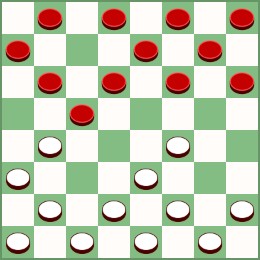
An important opening since the two-move era, 10-14 24-19 6-10 (ACF 53, C6J) is nowadays considered the best line for both players in the Denny opening (it is the trunk in Kear's Encyclopaedia, p.304). Maurice Chamblee named it the Nemesis in Ryan's American Checkerist,
and later lost to Walter Hellman with it in their world championship
match in 1951. (I don't know whether Murray Cash's computer
program was named after it). The strongest attack for White
is 22-17
(diagram above), to which there are only two tenable replies: the
preferred defense has historically swung from 9-13 to 11-15, and back
to 9-13 again, but both are quite playable. Kingsrow's
five-move ratings suggest 11-15 is better for Black, but Pask says it
"leads to a highly spindly Black position". (See also Fortman's analysis in Draughts Razoo, Spring 2004, pp. 12-14). Other second moves for White
are 22-18, 28-24 (both best met with 11-15), and 27-24 (best met with
11-16); these can transpose into other ballots. In two-move
play, Nemesis can also arise in two-move play from 9-14 24-19 6-9, and in three-move play from 9-14 22-17 6-9
24-19.
Kelso Openings
The Albion
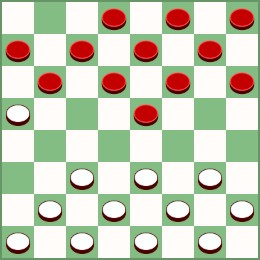
Albion is a poetic name for England (used in Shakespeare among others), which the Recreationist
used as a name for the opening 10-15 21-17; 6-10 17-13; 1-6 (diagram
above). The name is no longer in wide use (though Fortman mentions it),
although it was a reasonably common line in the Kelso, even in the
go-as-you-please era (Lees' Guide
has it as Variation 11, one of the principal variations; 11-16 instead
of 6-10 was the trunk). It was less common in the two-move
era (since weaker replies to 10-15 were just as common as the superior
21-17), but 6-10 still remained the second most popular choice after
11-16. In Kear's Encyclopaedia,
it is still the most principal variation, number 51, but with the
footnote about 17-13: "Perhaps best, but the experts prefer
17-14". Indeed, in the three-move era, 17-14 has become the
dominant reply in ballot 62 (D1J), though both Fortman and Pask also
analyze 17-13 as a variation. 17-14 is the most often played and
most effective move for White in the Open Checkers Archive statistics.
The main line of the Albion in go-as-you-please days, and carried through the two-move era, is
10-15 21-17; 6-10 17-13; 1-6 23-18; 12-16 24-20; 16-19 25-21; 8-12
27-24; 3-8 31-27; 9-14* (11-16 and 12-16 both lose). Pask
in Variation 12 plays 11-16 instead of 12-16. Fortman prefers
22-18 to 23-18, but analyzes both lines. Fortman's note M on 1-6
says it is the only sound reply (Lees and Kear don't even give any
alternate lines), and claims 9-14 may lose after 22-18; 15x22 25x9;
5x14 13-9 ("any [Black] draw is problematical"). Kingsrow
analyzes 9-14 as a very difficult but definite draw for Black, and
includes an extended opening book on the line (it prefers 29-25 instead of 13-9 as the main variation).
The Octopus

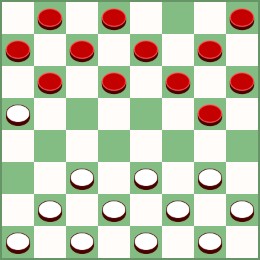
Regarded
as one of the most difficult of the three-move ballots for Black, 10-15
21-17 7-10 (ACF ballot 63, or D1K) was named the Octopus
by Willie Ryan. It was rarely played under two-move
restriction (it's also possible as 11-15 21-17 7-11), as the early move of the apex piece 7-10 was considered
very weak. Banks in Scientific Checkers does not mention it;
Tescheleit barely so in volume 4 of Master Play,
calling it a doubtful draw, but he only gives 9-14 or 3-7 at Black's
fourth. The strongest attack for White is the trunk 10-15
21-17; 7-10 17-14; 10x17* 22x13; with 11-16* being Black's only move to
draw (diagram above left). 9-14 was already considered to be a losing move (24-20* wins) by the late
1930's (see John G. Finley's analysis in the May 1938 Games Digest, pp. 45-46), while players held out hope for 3-7 much longer (25-21* wins). Alexander in the 4th edition of Kear's Encyclopaedia gives a few variations on p. 209, but says "I doubt a draw after this".
He does correctly assess 9-14 a loss and gives 11-16 as "Best chance
for a draw". Willie Ryan opens the game section of his
1940 book, The Modern Encyclopedia of Checkers, with 27 pages of analysis on the 11-16 Octopus (slightly expanded in the 2nd edition), calling it Battleground of the Analysts. He credits A.J. Mantell
as the main analyst, with help from Ryan and others.
Ryan says that the alternate capture 9x18 probably loses, and
offered to play White against any player for $5, with Black only needing
to draw. This was still being analyzed at least as late as 1980 (e.g. Sam Schonbach, Midwest Checkers, vol. 2, pp. 97, 109), but conclusive analysis by Kingsrow confirms Ryan's claim. There is further analysis in Big League Checkers. Fortman points out in Basic Checkers
that White replies other than 17-14 allow transpositions into easier
lines. Eugene Frazier and Stenson Tribble both published compilations on the Octopus in 1969 (see Lovell).
The
Octopus can also occur from the ballot 11-16 21-17 7-11 (ACF 105, or F1L):
if White replies 17-14 10x17 22x13, every Black reply loses except
11-15*, which transposes into the Octopus trunk (see Moiseyev's Sixth, Game 48, pp. 344-349, for a deeply analyzed game). Instead White can
also play 17-13, called the Octopus Refused or Baby Octopus;
here 3-7* is
Black's only saving move (above right). Both the standard and Baby
Octopus ballots barely survived the same vote in 1937 which eliminated the Nutcracker (see part 2 of Cayton's history in the Keystone Checker Review, vol. 5, num. 1, pp. 659-662, Jan 1994).
The Tyne
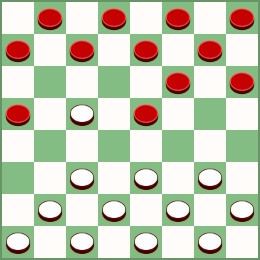
Another very difficult ballot for Black, 10-15 21-17 9-13 was named the Tyne in the May 1869 Draught Board (Call). Despite its age, it was a minor variation until the three-move era. Kear's Encyclopaedia gives it as variation 22 (p. 394), and Lees' Guide
mentions it only in a footnote giving a transposition to a line of the
Boston: 10-15 21-17; 9-13 17-14; 15-18 (Fortman calls this the Frazier
defense) 22x15; 11x18, transposing to 11-15 22-17; 9-13 17-14; 10x17
21x14; 15-18. Tescheleit in Master Play calls 9-13 weak, but gives several variations.
After White's second move 17-14 (diagram above; undoubtedly strongest), Black is subjected to many possible attacks. Notable
players including Nathan Rubin and Newell Banks felt this move should
win for White (see Cayton's history as noted above under the
Octopus). Wood's Checker Studies
(Vol. 4, March 1935, Study number 49, pp. 16-18) analyzes several
lines, giving 6-10 as the trunk for Black's third move. Of
11-16, he says: "A line that must be improved or abandoned as
untenable." He also gives the Boston transposition ("a weak
line"). In his 1943 Modern Encyclopedia of Checkers,
Willie Ryan reverses Wood's conclusion, calling 11-16 "in my opinion,
black's only move to draw". 11-16 is now the trunk,
although 15-18 and 6-10 are also draws, as well as Kingsrow's preferred
move, 6-9 (Tescheleit gives two lines on 6-9, both winning for White;
Pask has some 6-9 analysis in Repertoire). Fraser and L.L. Hall analyze 11-16 in some detail in The Inferno of Checkers.
The Nutcracker
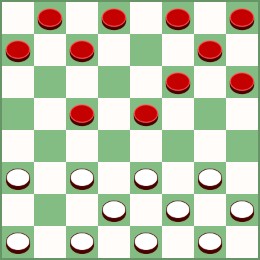
The most famous of the now-barred openings, 10-15 22-17 9-14 17x10 7x14, named the Nutcracker, was one of the 138 openings allowed under three-move restriction. The Nutcracker was balloted five
times in the 8th National Tourney in 1934,
with two wins by Black and three by White. The annotator
suggested
that 24-20 was probably a winning move for White (actually 24-20 15-18*
draws, after several more star moves), but in four of the five games
25-22 was played. In 1937, the committee overseeing three-move ballots were divided on
both the Nutcracker and the two Octopus openings, eventually voting to
drop the Nutcracker and keep the other two, even though none of the
three had been definitively proven sound or unsound. The attack which defeats the Nutcracker is 25-22* (diagram above: other moves
allow Black to draw): Denvir's Three Move Guide concluded that 6-10 was
a saving defense, but Ryan's analysis in 1938 found that 25-22* 6-10 24-20* was a win for White. As both versions of the Octopus proved tenable, the committee's decision was validated. [Note that in Pool, Russian, or Brazilian, the Nutcracker loses
at once to the double capture 17x19 (capturing backwards from 10)].
The Skull Cracker
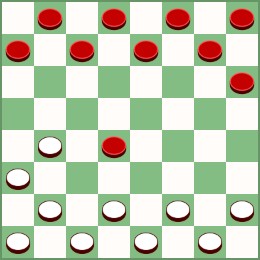
Another Kelso three-move ballot was a successful one: 10-15 22-17 15-19, named the Skull Cracker
by Lee Hunger, was part of the initial three-move restriction (ACF ballot 71, or D2S) and made
its serious debut in the 1934 National Tourney. It proved
playable, though very difficult for Black (8 draws and 3 White wins), and
is rated by most analysts among the hardest ballots for
Black. White has two possible captures, but 24x15 is much stronger; this
leads to a flurry of forced exchanges (11x18 23x14 9x18: diagram
above). [23x16
allows Black to equalize after 12x19 24x15 11x18.] The
Skull Cracker is noted for the difficulty of the endgames it produces
(see Pask's Complete Checkers: Insights
for a detailed example, as well as analysis of the opening
itself). Manuscripts devoted to the opening have been
published by L.L. Hall and Eugene Frazier, and it is covered in every
three-move guide. [Skull Cracker is sometimes spelled as
one word or hyphenated, but two words is the official ACF spelling.]
The Goatgetter
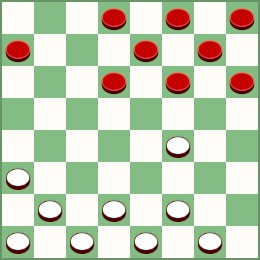
10-15 23-18 6-10 was a secondary line in the Kelso Cross during the two-move era (12-16 and 7-10 were preferred). Early analysis by Tescheleit (10 variations on pp. 296-297) and Kear (var. 55, p.236) concentrated on 27-23 as White's second move. Shearer's Modern Draughts Handbook
gives 10 games played in the correspondence tournament featured there,
all featuring 26-23 (called weak by Tescheleit). Kear noted that
both 26-23 and 18-14 were also good. By the time it
appeared in three-move restriction (ACF Ballot 73, D4J), the strongest
attack for White was understood to be 18-14; 9x18* 24-19*; 15x24 22x6*; 1x10 28x19
(diagram above). Willie Ryan and Harrah B. Reynolds played both
sides of it in the 1934 Eighth National Tourney (both games were
drawn). Ryan later analyzed it in his Modern Encyclopedia of Checkers (he analyzes the alternatives to 18-14 but says "none of them pack any real zip"). Fraser's The Inferno of Checkers
(game 30, p.160) analyzes the alternate capture 27x20, played by Marion
Tinsley in 1950 to a win (see also Fortman and Pask). A modern
look with eight example games is in Moiseyev's Sixth (pp. 290-293,
Selected Game 31), including several new moves introduced by Chinook,
Cake, and Kingsrow. Some time during the three-move era the
opening was named the Goatgetter.
Strickland's Cross
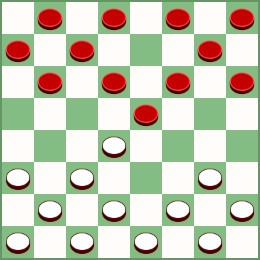
Another Cross variation, seen in go-as-you-please and two-move as both
10-15 23-18 7-10 (ACF 74, D4T; diagram above) and 11-15 23-18 7-11, was named Strickland's Cross after the blindfold champion William Strickland, also a noted analyst who wrote the earliest portions of what became The British Draughts Player.
While 7-11 is a weaker and less common response to the regular Cross,
7-10 is the second most popular response to the Kelso Cross, and nearly
as strong as 12-16. (Kear's says that 12-16 is "Better than 7-10,
... but rather too heavy a line for the ordinary player".)
The recommended White response is 27-23 (best answered by 3-7), but
26-23 (best answered by 10-14) is also solid (see Strickland's own analysis of 26-23 in Bowen's Cross, pp. 159-161, vars. 889-900).
Old Faithful Openings
The Switcher
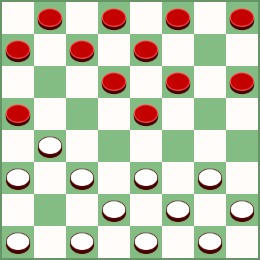
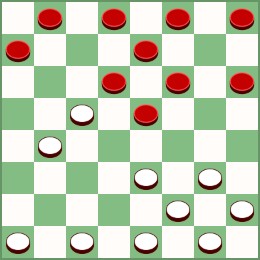
Except for the fomerly barred exchanges (Double Cross, Denny Exchange,
and Black Widow), the two move openings 11-15 21-17 and 9-13 21-17 are
the weakest for White, because both allow a position called The
Switcher (11-15 21-17 9-13,
or 9-13 21-17 11-15). This was made famous
by world champion James Wyllie, who played the White side to confuse
his opponents: "...with that weak and apparently silly opening I have
switched and perplexed many an eminent player...". The name
was given by Wyllie's friend George Wallace to the opening 11-15 21-17,
although any responses other than 9-13 are much weaker. Switcher
became a generic name for the 21-17 reply to any Black opening, when
using the compound names
of the two-move era, although 21-17 is only a strong reply against
10-15. [Note also that 9-13 is frequently a strong Black
reply to 21-17 (as in the Tyne above), just as 24-20 is to 12-16.] Historically,
the dominant reply by White in the Switcher is 25-21, usually followed by 8-11
(diagram above left). The ACF list of opening names
officially defines the diagrammed position above left as the Switcher (11-15 21-17
9-13 alone is ACF ballot 85, or E1A). The same position can
also arise from 11-15 22-17 9-13 25-22 8-11.
The trunk line in Charles Lawson's 1889 book Lawson's Switcher Guide (also in Lees' Guide) is ...17-14; 10x17 21x14; 6-10 22-17*; 13x22 26x17
(diagram above right); 15-18 24-20. [4-8 (the trunk in Kear)
instead of 15-18 is also sound, but played less often.]
Around 1879, player named J.W. Brock advocated 29-25 instead of 24-20,
which caused the Switcher Controversy (see Call's Vocabulary):
R.E. Bowen offered a prize (either $5 or $10) for anyone who could
prove a draw for White after 29-25. Wyllie played a
correspondence match with Robert Martins in 1880 to test its soundness, and won Bowen's prize after 25 of the 30 games were drawn. Wyllie wrote a book on the Switcher in 1881 including those games, and the entire match was reprinted in Gould's Historic and Memorable Matches. (Lawson's book doesn't even mention 29-25.) Another book on the Switcher is William Timothy Call's Rambles with the Switcher; Call was perhaps the most entertaining writer on checkers before the heyday of Willie Ryan.
Modern practice has largely bypassed the 17-14 line, preferring 30-25,
known as the Andrew Jackson defense, played by a player of that name
(not the president) as early as 1886 (Fortman analyzes both 30-25 and
17-14). 30-25 allows White a virtually forced line:
4-8 24-19*; 15x24 28x19; 11-15 17-14*, followed by a double exchange in
either order. Pask has an interesting discussion in Insights of the relative merits of 17-14 vs. 30-25. Cake's
opening book prefers 24-19, found in Lees, Kear, and Walker, but much
less popular. The fourth tenable response is 23-18, analyzed by
Tescheleit (Master Play, var. 24, pp. 342-343).
23-18 is also the only other tenable alternative to 25-21: 9-13 23-18 was named
the Squirrel by John Bell in 1881. Modern works don't even
mention it, and there doesn't seem to be much analysis in the standard
references except for a few variations in Tescheleit (Part 5, pp.
349-350, var. 31) and Kear (pp. 393-394, vars. 18-21 under 9-13
21-17). Tescheleit says 23-18 is stronger after 8-11 (as an
alternative to 17-14), rather than earlier (as an alternative to 25-21). Shearer's Studies of the Two-Move Openings says it "is good enough for a draw, but offers little prospect of White wins." Wood's Checker Studies 8
(game number 22, p. 50) gives a Black win with 23-18 12-16 (which
transposes into a branch of Ryan's Cross) analyzed by Nathan Rubin, but
he gives a probably losing move on White's 5th (25-21 is best instead
of 27-23?). Other moves lose (see Pask's Repertoire, p. 419):
22-18 loses, after the 15-22 (not 13x22?) double exchange, to
8-11*. 23-19 is answered by 5-9*, with a
position similar to the Laird and Lady Refused. A.B. Scott advocated 24-20, but that also loses, to 5-9 or 8-11 (not to 15-19 as suggested by Shearer).
The 26x17 variation of the Single Corner
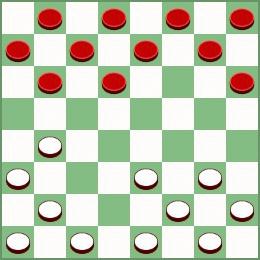
The trunk of the Single Corner opening is 11-15 22-18 15x22 25x18;
this is one of the most common openings in go-as-you-please
play, and leads to a position only slightly favoring Black.
There is a voluminous amount of published play on 25x18, and hardly any
on the alternate capture, 26x17 (diagram above), which is found mostly in older books. Lees' Guide classifies this as an opening separate from the trunk,
giving four pages to variations of the "26-17 Single Corner", citing an
1864 match between Wyllie and Martins as its first important
appearance. It gives 8-11 as Black's principal third move, with
"the results showing Black has a decided advantage". Strickland, in The British Draughts Player (1896) has only a footnote: "26-17 also draws, but is weak". Charles Ellsworth, in Ellsworth's Checker Book
(edited by Call in 1899) says: "The 26-17 jump is sometimes played to
get the opening away from the books, but it is regarded as weak
although supposed to be sound. In spite of its popularity the
'Single Corner' is a hard game for White, and that is why 26-17 has
received considerable attention, but it has nothing in its favor except
as a novel departure from the beaten track."
Even some works devoted to the Single Corner barely mention it: L.S. Head, on page 100 of Durgin's Single Corner,
says: "26 17 draws, but the experienced player should never capture in
that manner, as it leads to very critical play." Volume 6 (The Single Corner) of Tescheleit's Master Play of the Draught Board
gives it half a page on the very last page of the book, showing some
draws and some Black wins; Tescheleit recommended 12-16 for Black's
third move (with the impossible reply 18-14, clearly a typo for 17-14). Duffy's Single Corner
is quite pessimistic, giving it two pages showing nothing but Black
wins: "This take rarely arises as the second player labors
at a great disadvantage. The position is decidedly in Black's
favor... It is doubtful whether a sound White draw can be sustained on
the opening." Duffy recommends the 9-14 response: "The
strongest attack and creates for White a weakness leading to an
untenable defense and eventual loss. A draw is nearly impossible
because of White's cramped position." Duffy's analysis is flawed: he does not give White's
strongest lines, and in his trunk (Variation 131, p. 106), at note
E, he misses White's critical drawing move 26-22*.
Many modern guides, even comprehensive ones like Fortman's Basic Checkers, do not even mention it; several authors even give 25x18 as a star move (the only drawing
move). However, Richard Pask mentions it in the postscript to Complete Checkers: Repertoire:
"Long dismissed as a loss, this has now been shown to be perfectly
sound." He gives a line from the 9-14 reply which after 22
moves he calls even. In Insights
he adds: "it is a case of swimming against the tide and best left to
the specialist." Alex Moiseyev has a long note about the
move in Sixth
(p. 261), commenting that both he and Ron King have played the move. Moiseyev suggests
that Black's main attacks are 9-13, 9-14, and 10-15, but Ed Gilbert's
Kingsrow analysis of five-move ballots says that Black's best reply on the third move is 8-11, rating
White's position at this point as even worse than the trunk of the
Double Cross opening. Gilbert has computed an extended opening book
showing a draw for White against every Black line of play. So it
is definitely not a forced win for Black, but nevertheless a very
difficult draw for White, confirming Patterson's verdict in How To Play Checkers: "If white plays 26 to 17, it would require great skill to obtain a draw." The official ACF list of opening names still includes 26-17 Single Corner and 27-20 Second Double Corner (see below) as separate names.
The IDF system of balloted openings
has one variation of the 26x17 Single Corner: ballot 17 XIII specifies
the moves 11-15 22-18 15x22 26x17 9-14 31-26. The Open Checkers Archive
has ten games (six by Wyllie and Martins): two wins for Black and eight
draws, all from the 19th century except King's drawn game in the 1999
National Tournament.
The Cross Openings

The Cross opening, 11-15
23-18, has a volume of published play perhaps
only rivalled by the Single Corner. It was first named the Cross
in John Drummond's 1851 second edition. The term Cross was used
in compound names
in the two-move era (and still occasionally now) to denote the 23-18 reply to any White move,
although the only other move it crosses in any sense is
10-15 (still called the Kelso Cross). The trunk for the Cross is 11-15 23-18; 8-11 27-23; 4-8 23-19
(diagram above), dating all the way back to Payne. An extended trunk found as early as R.E. Bowen's 1878 compilation
of the Cross opening, and still recommended by Pask, shows the gradual
evolution through multiple authors: 11-15 23-18; 8-11
27-23; 4-8 23-19 [Payne]; 10-14 19x10;14x23 26x19; 7x14 24-20 [all from Sturges]; 6-10 [Spayth] 22-17; 9-13 [two from Drummond] 30-26; 13x22 25x9; 5x14 [Robert Martins, from his 1867 match vs. Wyllie].
Many ways have been developed
for Black to avoid the most-played lines. Black's
most common alternatives are
covered below: on the third move the Short Cross (10-14) and Slip Cross
(11-16), and on the second move Cross Choice (9-14), Ryan's Cross
(12-16), and the Montrose Cross (15-19). 7-11, Strickland's
Cross, is also seen as 10-15 23-18 7-10 (ACF ballot 74 or D4K), and is covered above under the Kelso openings.
There are also two White alternatives after 8-11 which are occasionally
seen: 18-14 is the Waterloo (or Boston Cross), and 26-23 is the
Crescent Cross (or Witch). As noted below, 9-14 on Black's fourth move is likely to transpose to one of the two Old Fourteenth landings.
The Short Cross
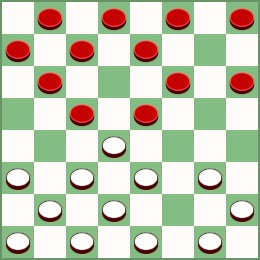
The Short Cross 11-15 23-18; 8-11 27-23; 10-14 (diagram above), named by Carl Reno in The Work of the Pentium,
which analyzes it in some detail, is one of the two most solid lines
for Black to avoid the Cross trunk (along with the Cross Choice below). The Short Cross was briefly covered in Bowen's Cross
(though less so than the Cross Choice), and was played relatively often
in the go-as-you-please era (there are actually slightly more Short
Cross games than Cross Choice games in the Open Checkers Archive).
Like the Cross Choice, it seemed to wane in the two-move era, and
didn't get the latter's benefit of being a three-move
ballot. Fortman gives only a short note, but calls it
strong (Kingsrow concurs). A similar opening with 26-23;
10-14 is common in Brazilian draughts (see the book on Abertura Cruz
(Cross Opening) by Alexander Loureiro).
The Slip Cross
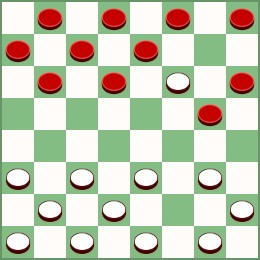
This variation of the Cross opening: 11-15 23-18; 8-11 27-23; 11-16 18x11 (diagram above)
dates back at least to Joshua Sturges in 1801, who gives it as Game 21,
also showing a now well-known trap as Variation 1. It was named the Slip Cross in the 1888 Campbell-Reed match (Call). Willie Ryan calls the Slip Cross "one-time favorite of go-as-you-please players", and covers both the trap and several solid lines in Tricks, Traps & Shots of the Checkerboard (pp. 105-108, Sturges' Steamroller). Kear
calls the Slip Cross "obsolete in expert play", and it isn't covered
much in modern works, though Gordon Hester published a book devoted to it. Fortman gives a line in the trunk
18x11 16-20 24-19, leading to a spectacular blocked
position with a king on each side stuck and unable to break through the logjam,
and an inevitable draw by repetition. Pask gives an alternate
line advocated by Kenneth Grover, 18x11 16-20 31-27 (see Let's Play Checkers for Grover's own analysis). A rare alternative to 16-20 is 3-8, which was recommended by Howard Billian on the checkers page of NOST-Algia in May 1971, as
a move to get out of book play. I can't find any reference
to 3-8 anywhere in published play (except by transposition in two OCA games), but both Cake and Kingsrow recommend
it in their opening books.
The Cross Choice
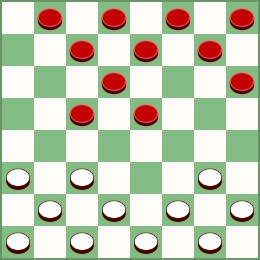
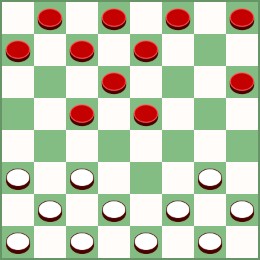
A solid opening which dates back to 19th century go-as-you-please,
11-15 23-18 9-14 also avoids the bulk of published play on the Cross,
while being more solid than the Slip Cross or most other
variations. It was named the Cross-Choice (spelled as two words now) in the January 1873 Recreationist, according to Call's Vocabulary (in Russian checkers it is known as the Little Fork.) Black offers White a choice of captures, and even today there is no clear consensus which is better for White: 18x9 (almost always followed by 5x14; above left) or 18x11
(almost always followed by 8x15; above right). [There appears to be no published play at all, even in specialized works, on the weak
but tenable alternate captures 18x9 6x13 or 18x11 7x16.] R.E. Bowen covered
the Cross Choice in his 1878 manuscript, giving 66 variations (mostly by William Strickland) over about 11 pages,
but it appears to have largely ignored in the two-move era.
It reappeared as one of the three-move ballots (ACF 94, E4B) and has
received much more attention: Gordon Hester wrote an entire book on it
in 1963 (covering 18x11 in much more detail than 18x9). Reno covers the Elbert Lowder variation 18x9 5x14 22-17 15-18 in The Work of the Pentium.
After 18x11 8x15, White's best move is 22-18, which gives Black
a choice of captures, and again there is no agreement on which capture
is better. (This is also possible after 18x9 5x14, but 22-17 is
regarded as much stronger than 22-18 in this case.)
Ryan's Cross
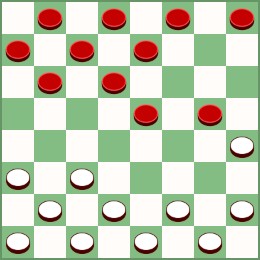
The opening 11-15 23-18 12-16 was not often played before
the
three-move era, although "Throstle", writing in the 1908 Canadian Checker Player
(vol. 2, num. 1, p. 6) says: "12-16 is a move not to be lightly
treated. The Little Giant of Pittsburgh [James P. Reed] often treated
us to it...". It was one of the 137 three-move openings adopted in the
1930's (ACF ballot 96, E4G). Although it was apparently never
considered for elimination, Rex B. Wood wrote in April 1936 in the 8th
volume of Wood's Checker Studies:
"This is a weak three-mover that some think is untenable and claim
should be barred." He nevertheless analyzed it in detail as
Study number 89 (pp. 24-35), and further in volume 9 as Study number 106 (p. 20-21). Willie Ryan spent 22 pages in the 1943 2nd edition of The Modern Encyclopedia of Checkers
(pp. 34-55) analyzing the opening in even more detail (Ryan played it
under two-move restriction against Jesse Hanson in the 1929 National
Tourney, getting a draw). Ryan did not give it a name;
Richard Fortman called it "the weakest reply to the Cross opening", but
suggested calling it Ryan's Cross, which is now the official ACF name.
After 18x11 8x15, White's only move to keep an advantage is 24-20
(diagram above); Black's best defense is probably either 9-14
(recommended by Wood, Wiswell, Fortman, and Pask), or 7-11 (preferred by Ryan,
and the book move for both Cake and Kingsrow). Wood and
several other analysts claimed that 9-14 was the only saving defense,
and Wood's study claimed wins against both 7-11 and 16-19 (Wiswell claimed 16-19 a loss but not 7-11); Ryan claimed
all three moves could draw. Computer analysis agrees with
Ryan that both 7-11 and 9-14 draw, but the status of 16-19 is not
clear: if Black draws, it is extremely difficult (running Kingsrow at 2
minutes per move produced a clear win for White after 50
moves). Atwell's Scientific Checkers gives a gambit after 16-19 and the weak reply 27-23: 19-24 28x19 15x24 32-28: White is slightly ahead here. In Big League Checkers,
Ryan presents another defense, 3-8: "This defense in my opinion is at
least equally as good as the 7-11 or 9-14 alternatives, and certainly
involves far less play." Computer analysis also gives 3-8 as a
definite draw, but it has been little played, and I have found no other
published play (one game in the 1954 World Mail Play Tourney ended in a win for White after a middlegame mistake by Black).
The same 12-16 move after 11-15 23-18; 8-11 27-23 is a gambit called the Firehouse Cross (see Fortman, p. 318), a known loss after the two-for-one shot 24-19 15x24 28x12. It was famously played by Walter Hellman
in the 8th National Tourney in 1934, in the third round against Charles
W. Young, trailing by a game. The annotator commented:
"This a tricky move, and although it loses, it requires correct play by
White. Many games have been won ... by deliberately playing
12-16." Young, however, won in 25 moves. I have not
found a source for the name Firehouse, nor any published play.
The Montrose Cross
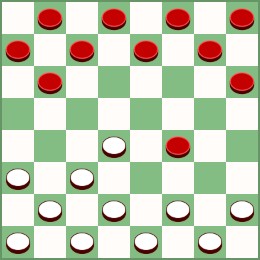
Another alternative to the trunk lines of the Cross opening is 11-15 23-18 15-19 24x15 10x19 (diagram above), the Montrose Cross.
This was named in 1869 by John Bertie, after yet another town in
Scotland. It has a long history from go-as-you-please and
two-move (where it was also seen from 11-16 23-18 16-19), although it
isn't covered in older guides (Kear only gives a transposition from
9-14 23-19 11-16 (var. 32, p.366)). Today 11-15 23-18
15-19 is ACF ballot 97 (E4S), and is found in most three-move
guides. It slightly favors White, who has at least five reasonable attacks in the diagrammed position, but Pask in Complete Checkers: Insights,
calls it: "a dynamic, complex ballot with excellent winning chances for
both sides. The mystery is why it is not adopted more often at
freestyle play..." (see Lesson 264, pp. 420-421). The recommended move in Fortman and
Pask is 27-24 (also played twice in the Moiseyev-King match: see Sixth).
Maurice Chamblee, an advocate of the opening, preferred 22-17; Kingsrow
recommends 21-17. The other two moves, 18-14 and 18-15, are
likely to transpose into other openings. The Open Checker Archive has 89 games covering all five of the common White attacks.
The orthodox openings
The most common four-move opening in go-as-you-please play is 11-15
23-19 8-11 22-17, which has given rise to four main openings, each with
a characteristic move: Alma (3-8), Old Fourteenth (4-8), Laird and Lady
(9-13), and Glasgow (11-16). They can also occur from 11-15
22-17 8-11 23-19.
The Alma
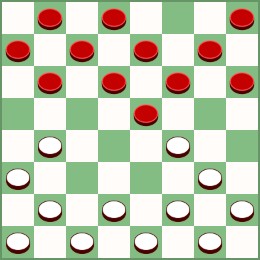
First published and named in Drummond's 1861 3rd edition, the Alma (named for a battle in the Crimean War) is 11-15 23-19 8-11 22-17 3-8
(diagram above left). It is unusual among traditional
openings for the early move of the bridge piece at 3. The
earliest published compilation was by Baker and Reed in 1888, followed
by J.L. Richmond in 1901 (both were later revised). The
most common line is 25-22; 11-16 26-23 (27-23 is less frequent, but
preferred by modern analysis); this can also occur as 26-23 11-16
25-22. Black sometimes plays 9-14 in reply to either 25-22
or 26-23; this can lead to the Whilter landing (25-22; 9-14 26-23; 5-9 17-13; 11-16 is Number 11 in Pask's Key Landings),
which can also develop from the Whilter itself or a delayed Alma
(...22-17 9-14 25-22 3-8). In fact, the Alma was originally
seen as a Whilter variation: the 25-22 9-14 branch is an exact
transposition to the 3-7 branch of the Whilter.
A
trap can be sprung if Black tries to get both 11-16 and 9-14 in before
White plays 17-13: after 25-22 9-14 26-23, playing 11-16 loses to
22-18* 15x22 19-15
10x26 17x3 (the same if 26-23 and 25-22 are swapped, or if 11-16 and
9-14 are swapped). The Open Checker Archive has two examples: in
the 1929 Nationals the player playing White missed the 22-18
combination, but later won anyway; in the 2001 English Open White played the trap, but eventually allowed a draw.
A
gambit which can develop from the modern 27-23 line is 25-22; 11-16
27-23; 7-11 24-20; 15x24 28x19; 10-14 17x10; 6x24. This is the
trunk in both Lees' Guide and The British Draughts Player
(Alma section by Francis Tescheleit, p. 145), and Tescheleit continues
22-18; 1-6 21-17. Call's Vocabulary has an entry for Busby's Alma move,
which is 2-7 in this position (from Lees variation 4, p. 10).
J.S. Busby's move draws, but 6-10 is probably stronger here (Lees note
m). Tescheleit credits the Busby move to W. Beattie in a game vs.
Robert Martins (p. 148).
One of the drawbacks of the modern encyclopedias (such as Kear, Fortman, and
Pask) is that they have so many openings to cover, and cannot afford to
spend much space discussing some of the traditional openings: Fortman
gives Alma one paragraph (note R, p. 341) and Pask only a few
variations, while it doesn't seem to be in Kear at all (the Whilter
landing only appears by transposition from 10-15 23-19, variation 19,
p.
241). J.L. Richmond gives seven pages to the 11-16
variations of the Alma in his 1901 book which mainly covers the
Single Corner. A more modern Alma compilation is by William
M. Courtney
in 1946.
The Old Fourteenth
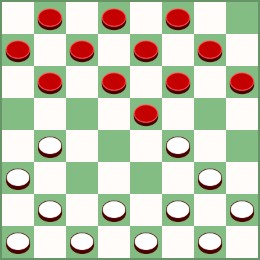
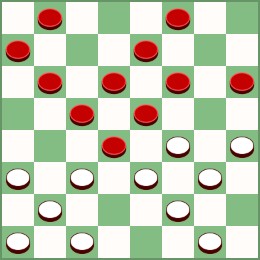
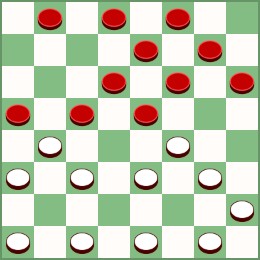
Dating back to Payne, the Old Fourteenth is 11-15 23-19 8-11 22-17 4-8
(diagram above left). There are two principal trunks:
the older is 17-13; 15-18 24-20; 11-15 28-24; 8-11 26-23; 9-14 31-26;
6-9 13x6; 2x9 26-22 (diagram above center): this is a landing which can also be reached by transposition from other openings (e.g. see Miller's Three Move Checker Chart, 98-J and 102-5). The modern trunk is 25-22;
9-13 27-23; 6-9 23-18; 9-14 18x9; 5x14 26-23 (diagram above right),
another landing which can also come from the 9-14 line of the Cross
(Miller, 93-D and 98-C). C.F.
Barker played the Old Fourteenth 14 times, all drawn, in his 1887 match
with Robert Martins, with every game reaching the position above right,
and five of the last six played identically move for move. The
Old Fourteenth is so named because it is the 14th game in Payne (and
Sturges), though Payne later gives another variation which develops
into the Black Doctor after 25-22 9-13 17-14.
Peter Doran's 1936 compilation Doran's Old 14th
is a more in-depth analysis. William M. Courtney also published a
book in 1946 on the Old Fourteenth, mostly covering the modern trunk,
but including a section on the Chapman Line, which is 15-18 instead of
6-9 in the modern trunk: W.K. Chapman paid a lot of money to analysts
to try to prove a White win, without success. Kear, Fortman, and
Pask
give the Glasgow as the trunk of the 11-15 23-19 8-11 opening: Kear
gives the Old Fourteenth as variations 17-28 (pp. 173-176), Fortman
gives it as Variation 1 with a few notes, and Pask gives a few
variations starting with 17.
The Laird and Lady
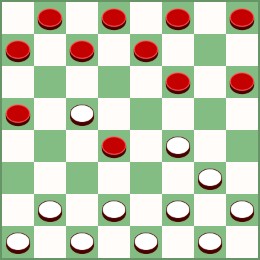
The original form of this traditional opening was 11-15 23-19; 8-11
22-17; 9-13; the trunk is ...17-14; 10x17 21x14. If White plays
25-22 instead of 17-14, the opening is called the Laird and Lady Refused,
which is found in older guides, despite already being a known loss (5-9* wins) by the time
of Lees' Guide in 1893. If White captures 19x10 instead of
21x14, followed by Black's recapture 7x14 (6x15 is weak, sometimes called the Black Doctor Refused), the opening becomes the Black Doctor (see below), or Nonsuch.
Nowadays, however, several other moves are preferred for Black's third, and the Laird and Lady is more often seen from the Boston:
11-15 22-17; 9-13 17-14; 10x17 21x14; 8-11 23-19, transposing into the
trunk above (this bypasses the Black Doctor). After the usual 15-18 (diagram above), White's most common replies
are 19-15, 24-20, or 26-23. In the third section of Stearns' Granite State Checker Series, G.D. Sherrow suggests the move 26-22, and shows several White
wins after 4-8 22x15; 11x18 19-15, but the last move overlooks the two-for-one shot
6-10 15x6 1x17. Instead of 19-15, Kingsrow suggests ...25-21; 6-9 30-25; 13-17
24-20 with a relatively even game.
The Black Doctor
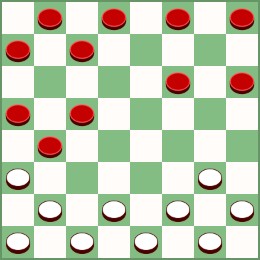
As noted above under Laird and Lady, the Black Doctor is 11-15 23-19; 8-11 22-17; 9-13 17-14; 10x17 19x10; 7x14
(diagram above). This opening gambit goes all the way back
to Payne: his last four games show a variation developing from the Old
Fourteenth after 11-15 22-17; 8-11 23-19; 4-8 25-22; 9-13 17-14 etc.
(same as the diagrammed position plus 25-22; 4-8; however, Payne gives
the losing move 29-25? instead of 27-23 for all four
games.) Swan and Adamson analyzed the opening in the
1878-1879 Glasgow Weekly Herald
(where they called it Nonsuch or Doctor): some of their analysis is
quoted by Lees and other guides. Dr. Walter Edward Truax put
out a booklet on the Black Doctor in 1888 (revised in 1892 with
Denvir). Around 1895 Dr. Stayman played a correspondence match
with Julian Janvier, trying (unsuccessfully, despite 11 wins and a draw
out of 12 games) to prove the entire opening unsound for White; he also
published his analysis. The 1908 Canadian Checker Player
(volume 2) analyzed the Black Doctor over five consecutive issues, over
40 pages in all, with 11 trunk lines (drawing heavily on Swan
and Adamson, but adding analysis from many others). Ben Boland's 1984 White and Black Doctors covers both openings, basing most of his Black Doctor analysis on The Canadian Checker Player, with new corrections and 24 landings.
In 1995, Whitefork Press put out a 40 page booklet called Lockhart's Black Doctor,
based on an 8-page manuscript by Charles Jordan Lockhart (possibly
unpublished, date unknown), with additions from Truax, Stayman, and
other well-known analysts (though Swan and Adamson barely appear). Doran's Old 14th
covers lines of the Black Doctor which come from the Old Fourteenth
(vars. 15-44, pp. 8-18). Two different bookdealer listings
include a compilation by I. Peterson and W. Bailey, date
unknown. Modern encyclopedias do not cover the Black Doctor in any detail, since it is avoided by recommended variations, but Pask's Insights
(p. 167) and Fortman (p. 337) mention a variation starting from 11-15
23-19; 8-11 21-17 (Derek Oldbury played this, to a draw, in his 1988
GAYP World Championship match against Don Lafferty).
The Kentucky Glasgow
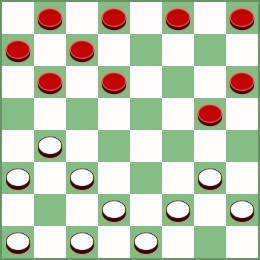
The Kentucky Glasgow was named and analyzed by Conrad Cantor in his 40-page monograph: 11-15 23-19; 8-11 22-17;
11-16 25-22; 16x23 27x11; 7x16 32-27 (diagram above). According to the author:
"eliminating reams of hackneyed published play." Tom Wiswell's Complete Guide to Checkers (Glossary, p. 122) calls the Kentucky sound. Jim Loy claimed a possible refutation in Basic Checkers: Corrections,
but computer analysis has Black only a bit ahead in the position he
marks as a win: both Kingsrow and Cake play the game out to a
draw. Kingsrow's opening book also has improvements for both sides (e.g.
preferring 24-20 or 22-18 instead of Cantor's 32-27, or 24-20 instead of 29-25 or 26-23 in the 9-14 line), and Black has
only a slight edge in the best lines.
The Tillicoultry
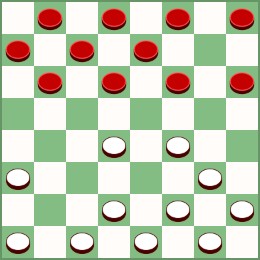
Named after a town in Scotland, The Tillicoultry (11-15 23-19; 8-11 22-18; 15x22) is a delayed version of the Single Corner. The opening was called Cuckoo in Dunne's 1890 Guide,
but the name Tillicoultry given to it by Strickland in 1885 caught
on. Unlike
the regular Single Corner, the 25x18* capture is necessary (diagram
above): 26x17? loses to several Black replies (11-16 is best; 11-15 or
4-8 also win). The trunk continues 11-16 27-23; 16-20 32-27; 10-14,
dating all the way back to John Drummond in 1851! (see Lees' Guide). [Despite its age, it was listed among seven irregular
openings in the British Draughts Player in 1906, but Lees' Guide established it as a standard opening.]
The Single Corner can transpose into the Tillicoultry after 25x18 8-11
23-19, but other Single Corner lines (12-16, or 8-11 followed by 29-25) are
more often played and probably stronger. In Complete Checkers: Insights
(p.167), Richard Pask says: "the problem this early exchange causes White is that of over development"; he gives a line with 4-8
instead of Drummond's 10-14. The Tillicoultry is still
seen today (world champions Sergio Scarpetta and Alex Moiseyev have
both played it). Modern players often prefer 4-8 (also Kingsrow's choice) instead of the trunk 11-16. Carl Reno wrote a full book on the Tillicoultry in addition to his analysis in The Work of the Pentium.
The Defiance and the Dodger
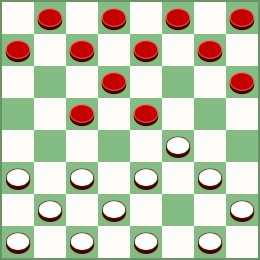
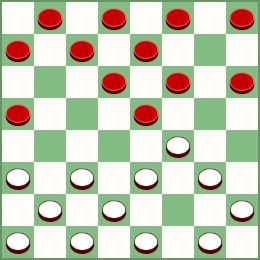
These related openings are characterized by White's second move 27-23 following either 11-15 23-19 9-14 (Defiance) or 11-15 23-19 8-11 (Dodger).
In both cases White wishes to avoid the well-analyzed openings: the
Defiance (diagram above left) dates back to the third game of Andrew Anderson's 1847
match vs. James Wyllie. It was devised by Anderson's second John McKerrow (see
Fortman, or Hester's Defiance System), as an alternative to 22-17 (which allows the Fife,
Glasgow, Souter, or Whilter). It is the preferred modern
variation against 9-14, with the trunk being 8-11 22-18; 15-22
25x9*; 5x14 29-25 (Pask's Key Landing
6). [Ryan claims that 8-11 22-17? 4-8! wins for Black (p. 111,
note A), but it is in Kingsrow's opening book, and almost certainly a
weak draw.] Other moves besides 8-11 transpose to other
ballots (see Fortman or Pask). Gordon Hester's 1960 Tournament Checkers: Defiance System is the most detailed guide to the opening.
The Dodger was analyzed and named by Willie Ryan in Championship Checkers Simplified (pp. 105-144; available at Internet Archive). Also
an alternative to 22-17, it prevents the Glasgow, Alma, Old Fourteenth,
and Laird and Lady, among others. Ryan claims it as a safer
drawing line, rather than a line with good winning chances for
White. Although it "dodges" a number of openings, Ryan
actually named it for his friend Col. Sam S. Schiller, a devoted fan of
the Brooklyn Dodgers. The Dodger can transpose to the
regular Defiance if Black plays 9-14, but the strongest move is 9-13
(diagram above right), which usually leads to a variation of the
Tillicoultry after 22-18; 15x22 25x18. See the Ryan book for
much more detail on both openings.
Will o' the Wisp
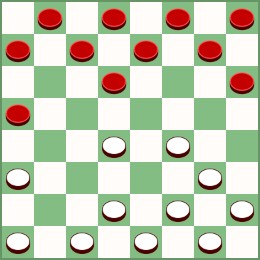
Another opening dating all the way back to Payne (games 35 and 36) is 11-15 23-19 9-13, known as the Will o' the Wisp [sometimes hyphenated].
It was named by George Wallace, who analyzed it for Anderson's 2nd
edition. Other names such as Provost (Drummond) and Marengo (New York
Clipper) are obsolete. In the two-move era, it also appeared
frequently as 9-13 23-19 11-15, Black's best
response to that two-move opening. Payne's
original games (and the trunk in Sturges) played 26-23 in reply to
9-13, but by the time it was named Will o' the Wisp, 26-23 had largely
been replaced by 22-18 15x22 25x18 (diagram
above), a delayed Single Corner, the strongest and most
common response for White. [The rare alternate capture
26x17 13x22 25x18 is also
playable.] Most often 25x18 is followed by the exchange
10-14 18x9
5x14 (recommended by Kear, Fortman, and Pask), or 7-11 followed by a
different exchange, 19-15 10x19
24x15. The 7-11 branch (including alternatives to 19-15)
was analyzed by Dr. A. Schaefer in his
1902 pamphlet; he mainly covers 12-16 after 24x15. Modern
works cover 7-11 merely as a footnote, but usually prefer 5-9 to
12-16. Pask gives it as variation 8 of the Kelso
Single opening 10-15 22-18 15x22; Fortman gives a long note C1, also
giving a more logical transposition from 10-15 23-19 7-10. Wood's Checker Studies 8 gives analysis of 24x15 6-9 (game 23, p. 50); Kear has variations for 12-16 and 6-9.
Schaefer followed up his 7-11 pamphlet
with another, on the older 26-23 (most of which covers 6-9 followed by 22-18, a doubly delayed
Single Corner). Elbert Lowder has played 13-17 21x14 10x17 (often suspected as a loss) from the
diagrammed position with limited success, but Kingsrow analyzes it as a narrow draw for Black. Willie Gardner, in the British Draughts Player
(var. 9, p. 349) said of 13-17: "..upon examination I find that White,
if not careful is liable to lose the ending, as frequently happens in
supposed weak lines." Reno's The Work of the Pentium
analyzes this line, as well as the standard 10-14 and several less
common lines: 10-15 for 10-14, and two alternatives to the 22-18
exchange: 26-23, and a
different exchange, 22-17 13x22 25x11* 7x23 26x19 (instead of the
more common 27x18: both captures are playable). Conrad Cantor also wrote a
monograph on the Will o' the Wisp (rare: date not given in dealer lists, 24 pp.).
dealer lists).
The Fife
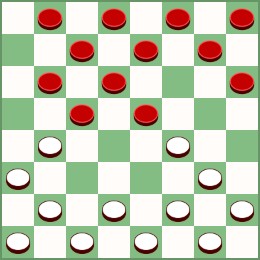
One of the most popular and strongest traditional openings, 11-15 23-19
9-14 22-17 5-9 (diagram above) is the Fife,
played by James Wyllie in the first game of his 1847 match against
Andrew Anderson, and named after the county in Scotland where he
lived. Derek Oldbury in The Square World (vol. 1, p.95) argues that it was played well before Wyllie and he contributed little to its theory. The 19th century trunk was the gambit line called 3x2 Fife: 17-13; 14-18 (Wyllie called these seven moves the true Fife) 19-16;
12x19 26-23; 19x26 30x5; Black gives up a three-for-two shot for a better position, with White's extra man stuck in the doghole.
This line first appeared in print in Drummond's 1851 second edition,
where a game with it was included with other variations under "Fife
Game - First Part"; his third edition had a page labeled Fife with the gambit line. Later 26-23 9-13 became the preferred line, usually followed by either 24-20 or 30-26 (credited
to Charles Francis Barker, but
Oldbury also observes that Barker had little success with it: it was
played 15 times to a draw in his 1887 match with Robert
Martins).
R.E. Bowen began the first compilation of published play in The Fife Opening (completed and published by M.F. Clouser in 1886). An uncommon variant, 17-13 15-18 (usually followed by 26-23 1-5), was named the Chicago Fife
by its three inventors: (Frank R.) Wendemuth, Welen, and Gilday, whose
1903 booklet was published by Schaefer (who published his own analysis
of the 26-23 line in 1906). The Chicago Fife has been
little-played (Ron King beat Derek Oldbury in a 1992 game in Barbados)
and rarely analyzed outside the 1903 booklet (Smith's Checker Classics contains a game by M.C. Priest with 26-23 15-18, which Smith also labels the Chicago Fife). Fortman
covers the three main Fife lines, which are all quite playable (Basic
Checkers, Variation 1 of 11-15 23-19 9-14, pp. 348-350); he calls the
Chicago Fife an easy draw for White. The Chicago Fife is also covered in Reno's The Work of the Pentium.
The Whilter
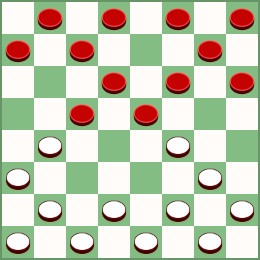
William Timothy Call's Vocabulary of Checkers comments that "Nine different ways of spelling this title have been used by various writers....In
all there are eighteen ways, ranging from three to eleven moves, in
which compilers have produced what they termed 'Whilter'." The Whilter is an opening with an early 7-11 move by Black, most often defined as 11-15 23-19 9-14 22-17 7-11 (diagram above), an alternative to the Fife and Souter openings in go-as-you-please play. It was named by a Scottish player, John McArthur, and first
appeared in Anderson's 1st edition (spelled Whulter), and again in the
2nd edition, spelled Whilter, which became the accepted spelling.
Despite the early move of the apex piece at 7, it soon became a
standard and popular opening, and appeared in later compilations by
Drummond (spelled Wholter) and Lees. James Deans published an in-depth analysis in the Auckland Chronicle; this was reprinted in two parts (40 pp.) in 1885 as Analysis of the Whilter.
The trunk of the traditional Whilter is 11-15 23-19; 9-14 22-17; 7-11 25-22; 11-16 26-23; 5-9 17-13; 3-7 29-25 (the Open Checkers Archive
has 167 games with this position). Fortman gives a
transposition of this as the trunk of opening 36. The Whilter is also seen from 11-15 23-19 7-11, which may transpose into regular Whilter lines,
or produce the Whilter Exchange after 22-18 (like the Tillicoultry, a
delayed Single Corner opening; this variation may transpose into the Will o'
the Wisp), or the Whilter Cross after 26-23 3-7 23-18. It is still seen today in both go-as-you-please and three-move play (11-15 23-19 7-11 is equivalent to the ACF ballot
79: 10-15 23-19 7-10, or D5K). Its many transpositions can lead to what Pask calls the Whilter landing (Key Landings, number 11, p. 23). Pask also discusses it in Insights (Lesson 48, p. 71). As noted above, 3-7 instead of 11-16 in the Whilter transposes to the 9-14 branch of the Alma.
The Souter
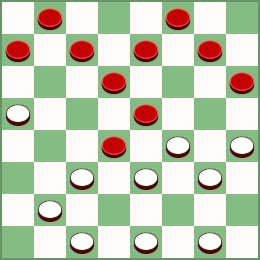

A traditional opening which first appeared in Anderson's 2nd edition is the Souter, originally defined by the move sequence 11-15 23-19; 9-14 22-17; 6-9
(its characteristic move). Originally spelled Suter,
Janvier spelled it Souter in his 1881 revision of Anderson, and the
present spelling took hold. In modern play it usually
occurs by
transposition from other openings: Fortman analyzes it as the
trunk of the opening 11-15 21-17; 9-14 25-21; 8-11 23-19; 6-9 17-13;
2-6, which transposes to the traditional Souter trunk (also from the
Double Corner; e.g. via 9-14 22-17 11-15 25-22.) The
extended trunk is 6-9 17-13; 2-6 25-22; 8-11 29-25; 4-8 24-20; 15x24
28x19; 11-15 27-24; 14-17 21x14; 9x18 26-23 (diagram above left), dating
back at least to Janvier's 1881 revision of Sturges.
The Souter was the subject of a manuscript with 800 variations, by
William M. Courtney, probably in the 1930's or 1940's, cited in the literature as Courtney's Souter (he also wrote
books on the Alma and Old Fourteenth). Reno also analyzes several lines in The Work of the Pentium, including the line 26-23 (preferred by Kingsrow and often played by Walter Hellman) instead of 24-20.
In 1892 Thomas J. Riley wrote a monograph on an alternate tenth move
for White, 31-27 instead of 26-23. Fortman calls this line
Riley's Souter, but says it is "at best, a technical draw". The Open Checkers Archive has one game with 31-27, compared to
109 games with the book move 26-23. While
the move is tenable (it can be found in Kingsrow's opening book), it
leaves White at a disadvantage, while 26-23 produces an even
game. It may not even be original with Riley, being found
in Janvier's Sturges, as well
as books by Robertson and Livermore, which predate Riley's book by a few
years (Livermore gives it one of his oddball names: Bennet and
Barnard). The usual continuation is 5-9 20-16 (a correction by Janvier); 10-14 19x10;
12x28 22x15, with a difficult draw for White.
William Hay's 1862 edition of The Draught Player
has a number of weaker Souter lines under the name Pioneer (not related to the modern Pioneer). He also has two long lines with 22-17 on White's
sixth move (a weaker but playable alternative to 24-20 or 26-23), continuing with 14-18 (diagram above right). He designates this as the Needle
(presumably for the long formation from 8 to 18), showing a trap as the
trunk line: 24-20? loses to 15x24 28x19; 18-23 27-18; 10-14 17x10;
6x29. Several other weak lines are shown, before Hay shows
the strongest reply to 14-18: the move 27-23, which he calls the Shuttle.
The 27x20 variation of the Second Double Corner
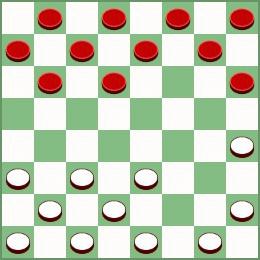
This has some similarities to the 26x17 Single Corner above, though it
is not as weak compared to the trunk Second Double Corner (11-15 24-19; 15x24
28x19). Once again Lees' Guide gives it a separate section "27-20
Second Double Corner", almost as long as the section on the usual capture 28x19,
with the comment "... still, it seems to admit of a fairly firm
defense". It also first appeared in the Wyllie-Martins 1864
match. Lees gives 9-14 as the best response, also analyzing 8-11
and 10-15 (which transposes into a line of the Kelso
Second, also mentioned in Kear's Encyclopaedia). It is not mentioned in Denvir and Bradt's Second Double Corner Book. Fortman calls it a "handicap line", also
mentioning the Kelso transposition. Pask, in Complete Checkers: Repertoire,
calls it "weak, but sound, and capable of producing many White
wins!". He gives one line with 8-11. Kingsrow says
that 8-11 is the best response (just as it is against 28x19), and White
appears to lose after any response except 22-18*. 27x20
occurs twice as an IDF ballot, once alone and once followed by
10-15. The Open Checkers Archive has 21 games with 27x20, with
all three common responses. [The Recreationist magazine in 1873 or 1874 named this variation Ravensdowne, a name which did not catch on (see Call's Vocabulary:
p. 150, Recreationist list).] The analogous capture in the
Kelso (10-15 24-19; 15x24 27x20) is a bit better for White than it is
here:
see Pask's Repertoire p. 413 #112.]
Was the Second Double Corner ever considered a loss?
The New Complete Hoyle, at least as early as 1956, says: "The Second
Double Corner, for a long time considered to be a White loss, has been
rehabilitated by the discovery that White can draw by breaking his
bridge promptly." Call's 1908 Vocabulary of Checkers
defines Suspected Opening as "one whose soundness is doubted by
experts, owing to the absence of proof. The Second Double Corner,
for example, was for many years classed as a suspected opening, but its
soundness was finally established." In the 11th Edition of Encyclopaedia Brittanica
(1910-1911), the article on Draughts by J.M.M. Dallas and Richard
Jordan says: "...it came to be regarded as decidedly weak... In the
Scottish Tournament of 1894 ... Stewart ... won the game with white,
introducing new play which has stood the test of analysis, and so
rehabilitating the opening in public favour." Doubt
and unpopularity aside, I can find no evidence in the literature that
the Second Double Corner (11-15 24-19) has
ever been judged as a loss for White. It has been
a standard opening since the 19th century, first named by
Anderson in 1852 (Game 8 in Anderson's 1848 first edition was even labeled Wylie's invincible Game [sic]). It has been part of
both two-move and three-move restriction since their inceptions (it is
ballot number 101 in the ACF system).
The early bridge-breaking move 30-25 on
White's 5th move dates back to Sturges in 1800 (where it is the trunk
in game number 53, a draw): 11-15 24-19; 15x24 28x19; 8-11 22-18;
10-14 25-22; 11-16 30-25; 4-8 22-17; 16-20 17x10; 6x24 32-28 (White has
now moved both bridge pieces). This was half a century before
Anderson, so how could it have rehabilitated an opening that didn't
even have a name yet? A supposed loss by
27-24 (instead of 30-25) on White's fifth, still mentioned as late as
Cady's 1896
booklet Checkers, had been corrected by Janvier in 1881, and 10-14 on Black's fourth
was considered a branch line as early as 1895 in Kear's revision of
Sturges, with 11-16 becoming the trunk (which it still is today).
Even more curiously, Kear gives three lines with 30-25 ending in losses for
White (with Black playing 6-10 or 16-20 instead of Sturges's 4-8 on
Black's sixth), and the 30-25 line doesn't appear at all in Kear and Alexander's Encyclopaedia. In fact, Kingsrow gives 30-25 in the
Sturges line as a probable loss (after, for example, 6-10 27-24; 16-20 31-27; 9-13
etc.). The most likely explanation
I can see for the Hoyle
comment is that they were mistakenly following Cady. [One
example of bridge-breaking even earlier in the game is Black's 3-8 in the
Alma
opening.]
The Old Paraffin
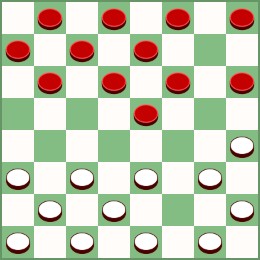
This
is a branch of the Ayrshire Lassie opening: 11-15 24-20; 8-11 27-24
(instead of the usual 28-24; diagram above). It was named by William
Campbell, editor of the Draughts World,
in February 1893: "...the opening we saw most generally practiced about
twenty years ago among the employees of a chemical works near Lamarck."
(Call, Vocabulary). It doesn't appear in most compilations: the most detailed analysis is by Willie Ryan (Scientific Checkers Made Easy,
pp. 97-108), who was perhaps its biggest advocate: "The opening is
slightly in favor of Black, but the playing edge is never dangerous
when the White pieces are properly manipulated." Jim Loy
attempted a refutation in Basic Checkers: Corrections,
but analysis by Kingsrow indicates that White has various drawing lines
available. Richard Pask, in the postscript to Complete Checkers: Repertoire (p. 415), gives it one variation, but says: "...now officially designated sound."
Bristol Openings
The opening move 11-16 appeared in several games in Payne, followed by either 22-18 or 22-17, but was not named the Bristol
until Anderson's 2nd edition in 1852. Anderson defined it
specifically as the opening 11-16 24-20 16-19; only later was Bristol
applied to the first move in general (Wiswell was still referring to
11-16 as Paisley in some of his books as late as 1960).
Newcastle and Leeds
In his 1890 Guide and Companion, Frank Dunne named two of the responses to 11-16, calling 11-16 21-17 Newcastle (this name is still in occasional use: see Martin Gardner's article in Scientific American) and 11-16 22-17 Leeds. H.F Shearer, in the 1912 Modern Draughts Handbook,
mistakenly used Leeds to refer to 11-16 21-17, despite citing Dunne as
his source. The error was compounded in the 1927 Draughts
Review (p. 158), where note (b) says of 11-16 21-17 9-13: "the
distinctive reply, as recommended by the late W. Strickland, after whom
the opening was named 'Leeds' " (Strickland was a native of the city of Leeds). Shearer's 1914 Studies in the Two-Move Openings,
however, says of 9-13: "Strickland deemed this a weak
reply". Why would Strickland have recommended a weak
reply? It is true that the two openings can
transpose: 11-16 21-17 9-13 25-21 is the same as 11-16 22-17 9-13
25-22. The trouble with that idea is that 11-16 22-17 9-13
(the Wilderness Companion we saw earlier) was
virtually unknown until the three-move era, and was barred until 2003. In Basic Checkers,
Fortman (p.370, Opening 105) says of 11-16 21-17: "Under the 2-move
restriction this opening was titled the Leeds in many
periodicals". If this is true, such periodicals are repeating Shearer's
mistake: I have not turned up any references besides those cited above.
Oliver's Twister
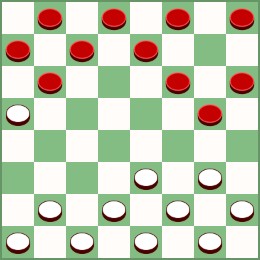
Willie Ryan named the opening 11-16 21-17 8-11 Oliver's Twister, after his friend and fellow analyst Oliver J. Mauro, who did much of the work analyzing it for the 2nd edition of Ryan's Modern Encyclopedia of Checkers,
where it is covered in more detail than the 1940 1st
edition. It was not seen much until the three-move era (ACF
ballot 106, or F1M). The characteristic attack is White's
second move 17-14, followed by the recapture 10x17* 22x13
(diagram above: the alternate capture 9x18 loses after 22x8 4x11
24-20). Other moves 17-13 and 25-21, instead of 17-14,
usually transpose.
The Black Widow (F5) and Barred Dundee (G5)
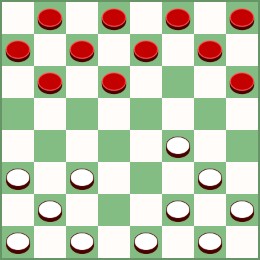
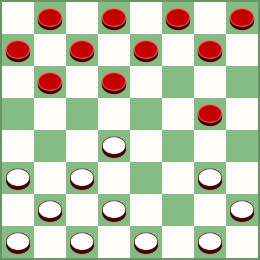
Black Widow trunk
Barred Dundee (White is lost)
In the earliest version of two-move restriction, the twin openings
11-16 23-19 (F5) and 12-16 23-19 (G5) were both barred.
Both openings have a forced capture of 16x23 by Black, with White able
to recapture by either 26x19 or 27x18. Later they were both
controversially added to the two-move ballots, with some analysts
believing they could be
drawn, while others thought them losses. In G-5, the
recapture 12-16 23-19 16x23 26x19 was soon discarded by almost every
analyst as untenable (the 1950 edition of Kear's Encyclopaedia and Shearer's Modern Draughts Handbook each still include one variation). W.G. Parker analyzed G5 in volume 1 of the Draughts Review, finding a draw doubtful, with the line 27x18 11-16 26-23 being the only hope for White. Banks gives some
analysis for both openings in Scientific Checkers:
he thought that 11-16 23-19 and 12-16 23-19 16x23 27x18
might both be found to be draws, but reached no definite conclusion on
either. Note that 11-16 23-19 16x23 27x18 12-16 transposes
into 12-16 23-19 16x23 27x18 11-16 (diagram above right), which Banks gives as the trunk for
G5. (Of course, 11-16 23-19 16x23 26x19 12-16 is
a win for White!) Various analysts, particularly John Howe Jr. and Peter Doran, attempted to prove draws for G5 in the American Checker Monthly beginning in March 1921. P.H. Ketchum analyzed G5 in 1922 in Wendemuth's Checker Companion: "Mr.
Ketchum believes this opening to be a loss for white, but does not wish
to make the positive assertion." Erroll Smith analyzed G5 in detail in his 1931 American Checker Player's Handbook (pp.45-66) without reaching a definite conclusion.
When three-move restriction began in 1931, both 11-16 23-19 16x23 and
12-16 23-19 16x23 were excluded from the three-move
ballots. Tom Wiswell called them "hopeless" in his 1946 Learn Checkers Fast.
Kear's says of F5: "It should have been left on the scrap-heap", but
analyzes both. Walter Hellman and Herbert Richter analyzed F5 (11-16 23-19 16x23 26x19 (diagram above left) was established as the only hope) in
the 1980's in Midwest Checkers (starting with "The Barred Bristol", Midwest Checkers, April 1980, pp. 20-21, and June 1980, p.88), eventually concluding it to be a loss,
but Chinook later found a draw in the 26x19 8-11 line, with the innovation 18-15 on White's 8th move (see Dennis Cayton's Compilation
for details): White must still make several star moves
thereafter. Another major line is 26x19 9-14, usually
continuing 27-23 8-11 22-18*. The alternate capture 27x18 is a loss when Black follows with 12-16 (the transposing line Banks gives for G5). The name Black Widow was proposed and accepted for F5, and the opening was added to the
ACF three-move ballots in 2003 as 121-A. Oddly, the recapture 26x19*, the
only
one which saves the Black Widow, loses in the formerly barred Double Cross.
Attempts to rehabilitate G5 included Albert Henry Rickard's
1949 monograph (see Lovell) which tried to prove it sound, but Cayton's Compilation gives a correction which refutes Rickard's analysis. Chinook
eventually analyzed 12-16 23-19 16x23 as a loss for White after either recapture
(confirmed by Kingsrow), so G5 remains barred. However, the win
in most
lines requires several star moves for Black: for example, a heavily
analyzed line of the 1920's needs six consecutive star moves
(discounting forced captures) for Black to keep a winning advantage: 12-16
23-19; 16x23 27x18*; 11-16* 26-23;
16-20* 24-19; 8-11* 22-17; 9-14* 18x9; 5x14 25-22; 11-15* 30-26; 15x24
28x19; 4-8*!
The Paisley
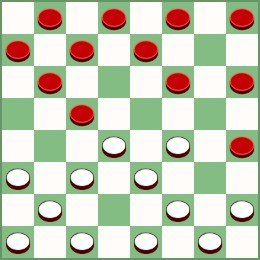
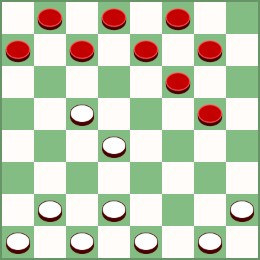
One of the oldest replies to the Bristol opening is 11-16 24-19, given
in Drummond's fourth edition (Volume 2, pp. 44-47, Bristol), which also
gives, under Denny, a line beginning with 10-14 which transposes to the same
Bristol trunk. Janvier named the 11-16 24-19 opening the Paisley
(another Scottish town, more famous for the textile design named after
it) in his 1881 revision of Anderson, and that name is standard
today. Dr.
A. Schaefer and Charles Kelly
published a 22-page analysis of the Paisley in 1886; this is apparently
extremely rare. (Arthur H. Barnes published a pamphlet in 1912
with original analysis of the Switcher, Dundee, and
Paisley.) The
strongest and most common response to 11-16 24-19 is
8-11 (some sources define the Paisley as only this three-move opening);
this position can also be reached from the Dundee
via 12-16 24-19 8-12. The ACF defines Paisley even more
restrictively as 11-16 24-19; 8-11 22-18. Kear's Encyclopaedia
claims that the common Paisley trunk 11-16 24-19; 8-11 22-18; 10-14 26-22;
16-20 (diagram above left) is more natural from the Bristol Cross, via 11-16 23-18; 16-20
24-19; 10-14 26-23; 8-11.
A solid alternative to 10-14 on Black's third move is 4-8. This is often followed by 18-14, the Paisley Bust, which produces a flurry of exchanges starting with a double X exchange: 4-8 18-14; 9x18 23x14; 10x17 21x14; 16x23 27x18; 12-16 (diagram above right).
The other responses to 11-16 24-19 are much weaker, and were little
played until the three-move era. Matt T. Long published a short
monograph in 1968 on 7-11, which he called the Bear Trap
(see Lovell). The trunk of 11-16 24-19 7-11 (ACF
ballot 122 or F6L), is 22-18 3-7; 25-22 11-15*; 18x11 8x24 [3-7 is
almost a star move: 9-14 is the only other move which probably draws].
Dundee Openings
The Minotaur
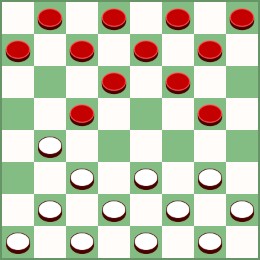
The opening 12-16 21-17 9-14 (diagram above), named the Minotaur
by Richard Fortman, was little-played before the three-move era,
although it can be found in Kear and Shearer. It was one of
the original three-move ballots (ACF 127, or G1B). It is somewhat
dangerous for both sides, but only mildly favors White.
White can block the capture with 25-21 (a passive move which usually
results in a flurry of exchanges), evade with 17-13 (recommended by
several sources), or counterattack with the aggressive
24-19. Wood's Checker Studies 7 devoted three studies to
the opening (74-76, pp. 10-12 and 14-15), covering all three of White's
options. More analysis can be found in Fortman and Pask.
The Bonnie Dundee
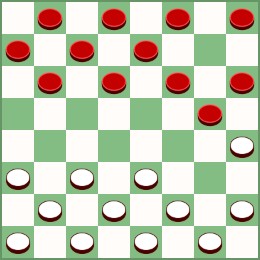
In older books, the opening 12-16 24-20 8-12 (diagram above) was called
the Black Switcher: after the common reply 22-18, it is exactly the
Switcher (11-15 21-17 9-13 25-21) with colors reversed, but 28-24 has
been considered the strongest response since the 19th century.
Nowadays
it is known as the Bonnie Dundee (given in Fortman, but not Call, so it is a comparatively recent name). Since 24-20 and 8-12 are the strongest second and third moves, the
Bonnie Dundee is essentially the trunk line for the entire Dundee
opening (the only other tenable replies to 24-20 are 10-15 (Skunk, below) and 11-15, which transposes to ballot 103 (11-15 24-20 12-16). The Bonnie Dundee is a common opening in Brazilian Draughts, where it is called the Bodianski opening (see the book by Louriero): the original form in Russian draughts is the Skunk, while 8-12 is the preferred variation in Brazil (11-15 doesn't work with backwards captures, because of the double capture 20x18).
After 8-12 28-24, the traditional play for Black was 9-14, but Julius D'Orio advocated 3-8 (known in the 19th century, but considered a secondary line), and that line was gradually improved (see Fortman for more details) so
that it is the preferred line today. [The only other tenable move
is 10-15, transposing into a mild branch of the Skunk.]
Pask analyzes 3-8 in great detail, and relegates 9-14 to a
note. Both lines are analyzed by Lees (3-8 only in a series
of footnotes, but calling it quite safe in the 1931 edition), Fortman,
and Wood's Checker Studies 7 (Study 87, p. 36). D'Orio himself discusses the 3-8 line in his Mysteries of Dama (pp. 94-105).
The Skunk
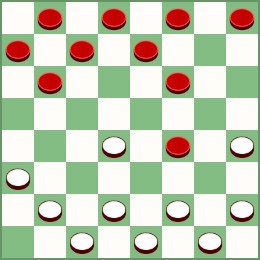
One of the twelve ballots added in 2003, 12-16 24-20 10-15 was named the Skunk by Elbert Lowder. Most older books don't include it, but Shearer's The Modern Draughts Handbook includes a few lines on pp. 119-120. It has been a
common opening in Russian draughts since the late 19th century,
advocated by Pavel Nikolayevich Bodiansky (see comments above on the Bonnie
Dundee). [Official IDF ballots cover 12 variations for 10-15 and 11 for 8-12.] The Skunk is also common in American Pool (see the book
by Black and Waters). The trunk is 12-16 24-20; 10-15 22-18; 15x22 25x18: Cayton's Compilation
gives 11-15 as Black's best fourth move, evaluating 8-12 as a loss
after 29-25, but 8-12 29-25; 16-19* 23x16; 12x19 saves the line
(diagram above), and 8-12 is given as best in Pask's Repertoire
(although 11-15 is also sound). 16-19 is credited to Nigel
Proffitt, who played it in Wood's Mail Play Ladder in 1998.
In The Golden Dozen, Pask calls the Skunk "Undoubtedly the most balanced of the new ballots". [In older terminology, skunk
has an unconnected meaning: to win without the opponent being able to
get a king, sometimes used as a problem theme (see Call's Vocabulary)].
Appendix 3 -- Glossary
analyst -- theorist who analyzes games, problems, and especially openings.
apex -- checkers
at
7 or 26, which form a strong defensive formation with 2 & 3 or 30
& 31. Most openings avoid moving the apex piece too early.
bridge -- checkers paired at 1 and 3 or 30 and 32, which defend the
king row. General strategy suggests maintaining the bridge as
long as possible, but there are exceptions.
compilation -- a detailed
collection of indexed variations of a particular opening, usually in
book form (occasionally in magazines). See also manuscript.
cook -- a correction to
published play, particularly one kept private until used in
competition. Sometimes also used, as in chess, for a
correction to a problem (which sometimes renders the problem invalid).
cut -- an exchange where the captured piece is recaptured, which reverses the Move.
dog hole -- squares 5 and 28,
where an advanced piece can be blocked by 1 or 32. A piece
in the dog hole reverses the calculation of the Move. See Pask's Complete Checkers: Insights for examples of its effects.
dust hole -- squares 12 and 21, where an advanced piece can be trapped by 3 (or 4) or 30 (or 29).
double X exchange -- a
transposition where two exchanges are forced, with the resulting
position the same no matter which capture is taken first (e.g. in the
opening C6Q, the position will be the same after either 22x15 11x18
23x14 9x18, or 23x14 9x18 22x15 11x18). Other examples on White's
second move are in openings C7Q,
D1R, E1S, E2S, and F3T; there is also one in the Goose Walk trap. If one of the initial captures
allows a double capture in reply (e.g. the 5-9 line of the Henderson), it is not a true double X exchange,
and the other initial capture choice is usually better.
gambit -- a variation sacrificing a piece for a positional advantage.
Golden Dozen -- the last twelve ballots approved in three-move restriction, bringing the total to 156.
inside vector -- a transposition reached by two different pieces
moving: e.g. 12-16/8-12 on Black's first two moves reaches the same
position as 11-16/8-11.
king walk -- a non-capturing
move by a king, the only move that is reversible (captures, promotions,
and non-capturing moves by men are irreversible). In endgame
databases, king walks can lead to repeated positions and lack of progress.
landing -- a position in the late opening or early midgame which can be
reached from many openings by transposition.
manuscript -- a compilation of
variations of many or all openings. Several of these have been
published (particularly in the early three-move era), but many players
assemble their own private manuscripts (which may contain cooks they
hope to use in play).
the Move -- traditional
name for what is called opposition in chess. The side with opposition, if it is not
altered (usually by a cut), will eventually put the opponent in zugzwang.
Old Faithful -- Black's opening move of 11-15, by far the
strongest. Named by Tom Wiswell in 1946 in Learn Checkers
Fast. Only one plausible three-move opening starting with Old
Faithful was found to be untenable (and only one with 11-15 second). In the Open Checkers Archive
(more than twenty thousand games), it has by far the highest Black win rate
(19% vs. 14-16% for the six others) and the lowest White win rate (15% vs.
20-26%), but also the highest draw rate (no doubt because of familiarity).
outside vector -- a transposition reached by moving a piece twice by
different paths: e.g. 11-15/15-19 on Black's first two moves reaches
the same position as 11-16/16-19.
published play -- (often abbreviated PP; also called book play) analysis of games,
particularly openings, in the literature (books and magazines, and now
websites). Corrections are found frequently, either winning lines
in positions thought to be drawn, or vice versa.
Petrov's Triangle -- a basic
endgame technique in 8x8 checkers with three flying kings versus
one, dating back to 17th century Spain. It does not work in 10x10 checkers. In American Pool the 3 vs 1 ending is
called The Special or Spanish First Position.
star move
-- (denoted by an asterisk) the only move in the current
position which wins (all other moves draw or lose), or holds a draw
(all other moves lose). Some authors seem to use it for a
very strong move which is not the only move to win or draw.
tenable -- a move which allows a player to at least draw with best play.
transposition -- a variation
which reaches the same position as another variation, in the same or a
different opening. These can range from simple changes in
move order and inside and outside vectors, to exchanges and more complex combinations
of moves.
trunk (game) (line) -- principal line in an opening (the same as a
main line in chess) from which variations (branches) are listed.
untenable -- a move which produces a losing position with best play.
variant -- one of a family of related games.
variation -- a sequence of moves in an opening.
zugzwang -- a position where any move will lose one or more pieces.
This article
is
copyright ©2025 by Michael Keller. All rights reserved.
This file was revised on March 1, 2025.























































































